
The Project Gutenberg EBook of Acrobats and Mountebanks, by
Hugues Le Roux and Jules Garnier
This eBook is for the use of anyone anywhere at no cost and with
almost no restrictions whatsoever. You may copy it, give it away or
re-use it under the terms of the Project Gutenberg License included
with this eBook or online at www.gutenberg.org/license
Title: Acrobats and Mountebanks
Author: Hugues Le Roux
Jules Garnier
Translator: A. P. Morton
Release Date: May 5, 2014 [EBook #45587]
Language: English
Character set encoding: UTF-8
*** START OF THIS PROJECT GUTENBERG EBOOK ACROBATS AND MOUNTEBANKS ***
Produced by Chris Curnow, RichardW, and the Online
Distributed Proofreading Team at http://www.pgdp.net (This
file was produced from images generously made available
by The Internet Archive)


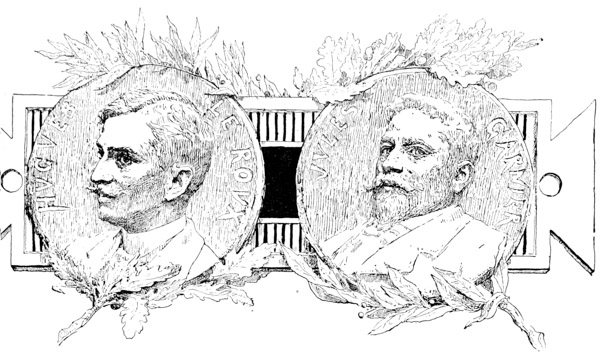
The Banquistes was the first title chosen for this book: it has been altered for two reasons which appeared conclusive after some consideration: the general public would have misunderstood it, and it would certainly have wounded those interested in it, who would have known what it meant.
But if we consult an etymological dictionary we shall find that the word SALTIMBANQUE, which is more generally used than BANQUISTE, is derived from a definite root: SALTIMBANQUE, s. m., from the Italian word SALTIMBANCO: who vaults on a bench (Latin, SALTARE IN BANCO). In Italian we also find the word CANTIMBANCO, a platform singer. I must add that when, after tracing out the etymology of the words SALTIMBANQUISTE and banquiste, we search for the origin of the word banker, we shall find that the same radical, BANCO, is the root of these three derivatives. In the old fairs two personages were allowed to erect a small platform, a “banc”—the money-changer and the acrobat. Perhaps the “banc” already served as a spring-board, giving both the BANKER and the BANQUISTE a greater impetus in their leap; perhaps we must even look back to the same date to find the exact origin of the now common expression “LEVER LE PIED” (to abscond).
However this may be, after the perusal of this book, it will be readily understood that the contemporary acrobat, established, enriched, emerging into the middle classes, indignantly rejects a slang term which apparently assigns to him the same origin as that of our modern financiers. This intolerance is certainly not the only surprise reserved for the reader of these pages. We claim to lead him to the threshold of an unknown world.
Before commencing this work, which has absorbed us during at least three years, I made a thorough investigation of the bibliographic and monographic information now existing upon the banquiste question, and I came to the conclusion that no French or foreign author worth attention or quotation had yet interested himself in this original people. M. Houcke, the manager of the Hippodrome, had kindly placed at our disposal a series of lithographs published in Germany. But the text and the correctness of the work were so defective, that the drawings were of no use to us. It was the same with the Saltimbanques, which M. Escudier published at the close of the Empire through Michel Lévy. The sole merit of M. Escudier’s work lies in his discovery of an unknown subject. He made the mistake of writing without information, picturesqueness, or philosophy, in the light, insufferably trifling tone, which is common to most of the publications of that epoch.
Since then, a conscientious writer, M. Dalsème, who is attached to the acrobats, has published a more interesting account of them entitled Le Cirque à Pied et à Cheval. The kindliness with which M. Dalsème alludes in his book to the quotations which he has made from my publications induces me to notice his work in return. And truly, however unequal and incomplete his book may be, it is still the most interesting work that has yet been seen upon a new subject.
This judgment places M. Edmund de Goncourt’s novel, the Frères Zemganno, far above this level, and beyond any invidious comparison. Although exact observation is the discipline of the novelist, M. de Goncourt has declared that in this instance his chief object was to write a symbolical book. His information was necessarily superficial. Such as it was, I do not think that any one has now more reason than ourselves for admiring the superior art and truth with which M. de Goncourt has spoken of the circus, has formulated its philosophy, depicted its passions, and divined those things that were concealed from him. And I trust that the author of the Frères Zemganno will be one of the first to enjoy the novelty of this work.
The perusal of the so-called naturalistic novels has gradually accustomed the public to a fairly strong dose of realism in books. A number of young men have written in imitation of the great masters, stories which, commonplace in themselves, are yet worth reading for their conscientious observation of the “surroundings.” A thousand inquiries upon contemporary life have been cleverly made, and readers have examined these social records with much curiosity.
It appeared to me that the best part of these novels, the portions most appreciated by the readers, were the facts of actual experience. I therefore asked myself if the time had not come to present to the public these facts free from all romantic fiction, in a form in which the author only intervenes in order to arrange the incidents and to point out the philosophy to be derived from them.
The success of this book will prove whether the attempt is premature, or whether there will be any reason for a sequel.
This publication is really the monograph of an unknown people, related by the pen and pencil. Its laws, its customs, its traditions, its secrets, its hopes, have been seized, defined in spite of reticence, evasions, wavering, and contradictory witnesses. It describes the organization of the banquiste people, the foundation of its agencies, newspapers, and syndicates, it follows the mountebank from his birth in the wandering caravan to his apotheosis in the friezes of the circus. And at the same time it penetrates into the stables to explain the secrets of the trainer, the tamer, and the ring-master; into the booths to ask the clown for the story of his adventures—and by what chance, having become a gentleman himself, he one day met in the land of whims a gentleman who had become a clown!
I cannot close this preface without addressing the warmest thanks to all those who have aided us in bringing this work to a successful issue—to our willing correspondents from America, England, Germany, and Russia. But whilst thus paying our debts, we must express our special gratitude to the learned director of the photographic department of the Salpêtrière, M. Albert Londe; to M. Guy de la Brettonière, the well-known circomane; to amateurs like MM. de Saint-Senoch, Bucquet, and Mathieu. The photographs which these gentlemen kindly took for us enabled the draughtsman to represent the acrobats in THOSE INTERMEDIATE POSES WHICH THE EYE NEVER SEIZES, and which hitherto the most rapid instantaneous photographs have failed in reproducing. A few figures will prove better than any words the extreme rarity of these plates.
In the month of June, 1888, M. Houcke having given us an appointment at the Hippodrome, made the clown, Auguste, and an artist of the fixed bar, vault in our presence. The members of the Société d’Excursions Française de Photographie, headed by its president, were nearly all assembled. Fifty cameras were arranged like a battery: each amateur had brought twelve glasses. After they had been examined, M. Albert Londe sent us ten proofs, which alone out of six hundred had been deemed worthy of being printed, and after a final examination only seven plates were preserved by the painter. They inspired the series of somersaults which are found in the chapter on GYMNASTS.
HUGUES LE ROUX.
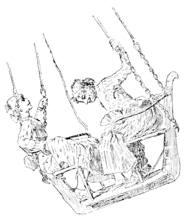
Page 78, line 7 from top, for “bloated Vitelliuses”, read, “bloated Vitellii”.
Page 206, line 3 from top, for “Naet Salsbury”, read, “Nael Salsbury”.
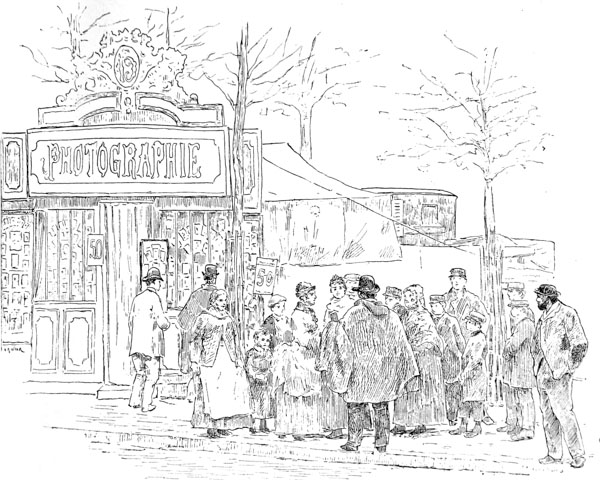
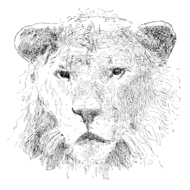

Parisians live in scandalous ignorance of the beings who surround them and of the world in which they move. Although fond of curious entertainments, they have never made any serious inquiries about the origin, the private life, or the terms of enlistment of the skilful artists whom they applaud in the circus, the theatre-concert, or the playhouse. I have often heard persons who considered themselves well informed, and who spoke with much reserve and many hints of deeper knowledge, assert that secret manufactures of monstrosities exist in the world, training schools for acrobats, registry offices for mountebanks; and that by diligent search, with a little discreet assistance from the police, one might discover branches of these picturesque establishments in the thieves’ quarters of old Paris. [p002]
This story is enough to frighten children, but it must be allowed to pass away with the dust of other fabrications destroyed by time, whilst you may rely upon the accuracy of the information contained in this book; its sole ambition is to enlighten you on this mysterious subject by telling you the truth about it.
The collection of all these facts has been a work of time. The mountebank is too jealous of his freedom to talk openly to every one that approaches him. The same patience which travellers use in their relations with savages must be employed before one can hope for any intimacy with this people, who are still as much scattered, as varied, as strangely mixed, as vagabond, as their ancestors, the gipsies, who, guitar on back, hoop in hand, their black hair encircled with a copper diadem, traversed the Middle Ages, protected from the hatred of the lower classes and the cruelty of the great by the talisman of superstitious terror.
This tribe, recruited from every nation and every type, is called, in its particular argot, the banque;1 there is the grande banque and the petite banque: its members are called banquistes.
Qualities transmitted through many generations, natural selection always tending in the same direction—of strength and dexterity—have, in course of time, endowed this [p003] international people with special characteristics. With regard to the superior instincts, they possess a taste for adventure, wonderful facility in acquiring languages, in assimilating every variety of civilization, and a strange amalgamation of qualities, which would seem incompatible with each other—Italian pliancy, Anglo-Saxon coolness, German tenacity. I do not quote the influence of French characteristics in the fabrication of these free citizens of the world: the soil of France is so dear to her children that, even if they tempt the glory and perils of an acrobat’s life, they rarely leave their native land. According to statistics, Frenchmen form a proportion of but five per cent, in the tribe of banquistes who travel round the world. But these mountebanks are not so numerous as one might imagine; in all there are only a few thousands. But earth contains no guests more free than these men, whom the poet Theodore de Banville greets as the “brothers of the birds, the inhabitants of the ideal city of Aristophanes.” Lords of their own will and time, they obey no laws except the terms of their voluntary engagements. They fly from war, pestilence, and ruin. When the heavens darken, they strap up their trunks, go on board a steamer and journey to other countries where gaiety and gold are to be found.
The sole disturbance in these careless lives is the question of engagements. The skill with which they have averted the difficulties, which their preference for a nomad life might have produced in their business, is a very remarkable example of that practical sense which constant travelling develops in the least cultivated individual.
Dispersed throughout the four quarters of the world, the [p004] banquistes have placed themselves in perpetual communication with, first, managers and impresarii, and then with their comrades, by means of a certain number of agencies and newspapers belonging to their corporation.

The eldest of these publications is The Era, published in London in English. The Era, now edited by Edward Ledger, was started in 1837. It is a kind of guide-book, consisting of twenty-four pages, each containing six columns, in the usual shape of an English newspaper; the price is sixpence a copy. In the title the royal escutcheon, supported by the lion and the unicorn, separates the two words The and Era. [p005]
Half the newspaper is filled with addresses of this kind—
All these addresses are arranged in alphabetical order. A proprietor can at once discover where the “novelty” with whom he proposes to communicate is temporarily staying.
The Era also serves as a letter-box to all its subscribers. A special department is open under this heading:
THE ERA LETTER-BOX.
Then follows, arranged in columns, an alphabetical list of the persons for whom a note has been sent to the newspaper office.
Adeson, M.
Atleyn, Madame.
Barry, Miss Helen.
Chelli, Miss Erminia, &c.
The remainder of the Era is consecrated to artistically-written accounts of all the new theatrical performances going on in the world, and naturally to offers of employment and advertisements for engagements.
The most extraordinary fancies are allowed free play in the compilation and typographical arrangement of these advertisements. It is a question of attracting notice at [p006] any price. A clever artist unhesitatingly pays for a whole column, in which horizontally, diagonally, as a cross, or an X, he repeats his own name and acquirements three or four hundred times.
I quote the following specimens, taken at random from the columns of the Era:
A YOUNG MAN, completely disarticulated, wishes to enter into an engagement with a travelling troupe.
This artist can be described in the placards either as the india-rubber man or the serpent man. He undertakes the monkey parts in pantomimes.
MISS MAGGIE VIOLETTE (fixed bars) is free from any engagement after Christmas.
A FATHER offers to managers a young girl, fourteen years old, who has only one eye, placed above the nose, and one ear on the shoulder.

The Era has an American rival also published in English, The New York Mirror. This newspaper has only one advantage over the Era: it publishes portraits.
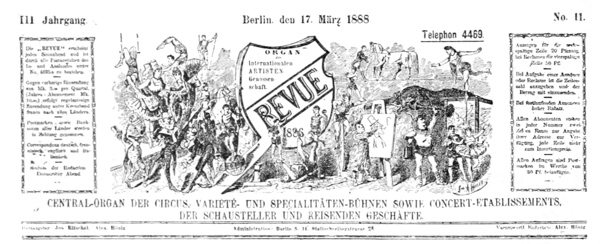

Germany, however, possesses two newspapers for the banquistes: one, under a French title, La Revue; the other, which is far the most important, is called Der Artist. The complete sub-title is: Central-Organ zur Vermittlung des Verkehrs zwischen Directoren und Künstlern der Circus, Varietebühnen, reisenden Theater und Schaustellungen. This paper is printed at Düsseldorf; M. C. Krauss is the chief editor.
Der Artist has been established six years. It looks like a weekly review of twenty leaves, printed in three columns. A woodcut, which fills the frontispiece and all the left side of the first page, represents various scenes from the circus [p008] and theatres: “shootists” breaking bottles, horses leaping over bars, pretty equestrians on their highly-trained steeds, tame lions, dwarfs, giants, clowns,—all the attractions of the circus and fair.
Here, as in the Era, we find long alphabetical enumerations of travelling and stationary establishments and lists of addresses of artists engaged or disengaged. These advertisements are nearly all compiled in an extraordinary gibberish, which far surpasses the ingenuity of the “sabir”: here is a specimen of them, the first I met with. It is a curious mixture of French, English, Latin, Italian, and German words:
MISS ADRIENNE ANCIOU, la reine de l’air, la plus grande Équilibriste aérienne de l’Époque,—Nec plus ultra—senza Rival, frei ab August 1888, 28 East 4. Str. New York.
It is very remarkable that English and American puffing has quite disappeared here. The earnestness and application of the German character are betrayed even in the typographical arrangement of this newspaper for acrobats. It is as clearly and carefully printed as a catalogue of the Leipzic libraries. The biographical notices, announcements of death, column of accidents, the Varietebühnen are compiled with scrupulous care and exactitude. This curious publication even finds space for literature, and the last number of the Artist published as a supplement Damons Walten, a novel, by Otto von Ellendorf. It is easy to appreciate the services which these and similar newspapers are able to confer upon the banquistes.
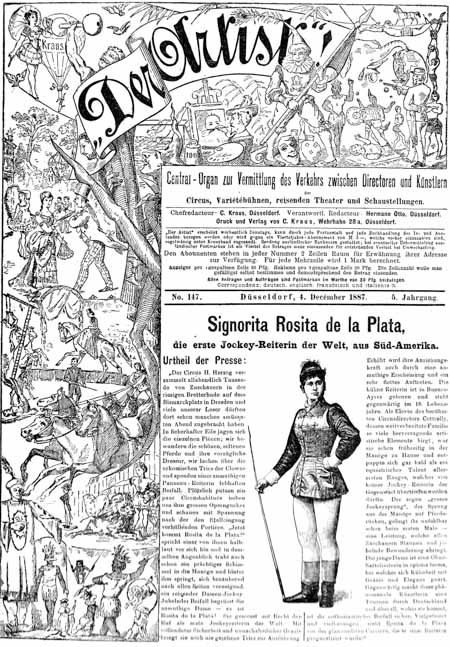
“To tell the truth,” one of the confraternity said to me one [p010] day, “in the whole world we have no other home but the little pigeon-hole of advertisements, where those who know us go and ask for news of us, where they learn the history of our engagements, our successes, our accidents, our marriage, the birth of our children, or the tidings of our death.”
Between the artist who seeks for an engagement and the manager always on the look out for an extraordinary “novelty,” a third person necessarily intervenes, the middleman, who arises everywhere between buyer and seller.
And, in fact, at the present time all the principal cities of the world have their agents for performing artists of every kind. These personages are very important, and make large profits. Those best known on the Continent are Messrs. Paravicini and Warner, of London; Hitzig and Wulff, of Berlin; Wild, of Vienna; Rosinsky, of Paris; Nael Salsbury, of New York, who, during the Exhibition of 1889, has shown the Parisians the savage life of the “Wild West,” transported to Paris in the persons of the celebrated Buffalo-Bill and his Indians.
The history of the Rosinsky agency is worth narration, for it is now so flourishing that it has replaced, to the advantage of Paris, the engagement market which formerly existed in London.
You can imagine that a man would not open an agency of this kind without first passing through many vicissitudes, and, in fact, R. Rosinsky has had a most checkered life.
He first acquired a taste for the profession through frequenting Barnum’s show in the United States. He has been manager of several American troupes, and proprietor of [p011] a theatre, alternately at St. Louis de Missouri and New York. His affairs prospered, and, with the aid of a partner, Rosinsky opened a circus, which he intended to run during the whole time that the Exhibition at Cincinnati was open, when an unforeseen accident ruined him.
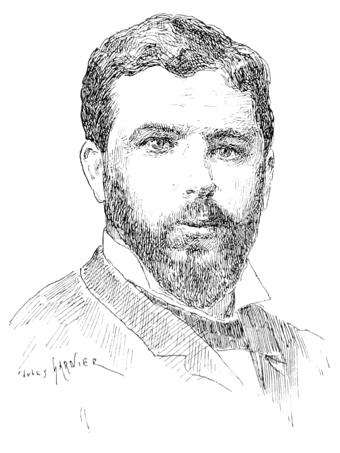
One evening his partner’s son, a young man twenty-five years old, but deaf and dumb, almost a brute, yet robust and dangerous, attempted to force an entrance into the dressing-room of an equestrian, who was just changing her dress after rehearsal. A policeman was quickly sent for. The deaf-mute drew a revolver from his pocket, fired at the policeman, and killed him on the spot.
The consequences of this murder may be easily guessed; [p012] the circus was closed. R. Rosinsky was ruined, and he recommenced his wanderings.
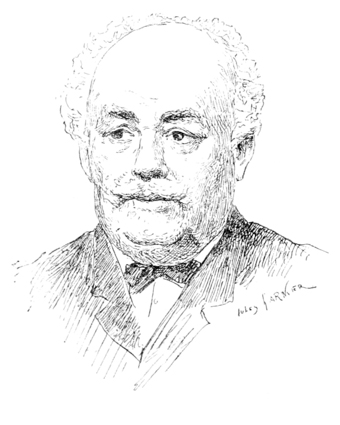
A few months later the famous Brigham Young invited him to undertake the management of the Theatre of the Mormons. I still have a copy of the newspaper—The Salt Lake Daily Herald—in which is found dated “Saturday morning, May 22, 1875,” an advertisement thus worded:
Salt Lake Theatre
R. Rosinsky . . . . Manager
GRAND MATINÉE THIS EVENING
The Wonderful
JACKLEY FAMILY.
Acrobats and Gymnasts.
Engaged [p013] during the course of the same year by Sari, the founder of the Folies Bergères, R. Rosinsky crossed the sea with the Jackley Family.
He was immediately struck by the small number of “stars” known in Paris, and, in order to attract them, he founded an agency for artists in 1875. His business has increased so rapidly that the Rosinsky agency is now in communication with correspondents scattered through all the great cities of Europe and the world. One fact is enough to prove the extent of this business. The annual postal expenses of the firm exceed 10,000 francs (£400).
An agent of this kind receives 10 per cent, upon every engagement which he arranges. To prevent any disputes in collecting this fee a clause is inserted in the agreements to the effect that the agent’s percentage is to be deducted by the manager himself from the salary remitted to the artist at the end of the first month, and these salaries are, sometimes, very considerable.
In order to compare the amount formerly paid to circus artists with the sums now received by them, I have consulted an old manuscript from the archives of M. Franconi, which bears the title of Registre personnel du Cirque, and dates back for fifty years.
We find that in 1838 the equestrians Auriol, Lalanne the elder, Lalanne (Pierre), Lalanne (Paul), Lalanne (Joseph), were paid, the first-named 500 francs (£20), the others 250 francs per fortnight.

The star equestrian, Mdlle. Lucie Linski, then received 300 francs, her companions 100, 50, and even 25 francs per fortnight. [p015]
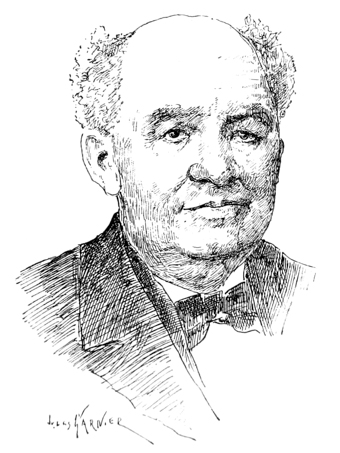
Four years later, in 1842, Auriol, whose success evidently increased, found his salary doubled. He received 1,000 francs per fortnight, or 2,000 francs per month, and the equestrian, Mdlle. Lilianne, 700 francs. Now, a good pad equestrian often receives 2,000 francs per month; a vaulting clown 1,500 francs; a family of acrobats 3,000 or 4,000 francs; and a single artist, whose performance is extraordinary and unusual, receives from 700 to 7,000 francs. Even these prices have been surpassed at times. Dr. Carver, the great “shootist,” was paid 15,000 francs a month at the Folies Bergères. Léotard, at his début, signed engagements for six months, and received 100,000 francs. The two brothers Lockhart, whom the Rosinsky agency had sent to India as [p016] clowns, returned as elephant-trainers, and now each of them, with his beast, earns about 70,000 francs per annum.
The enumeration of these sums tends, I admit, to only one object—to fill the public with respect, and make it understand that a good acrobat is, in his own line, quite as exceptional a being as, for instance, M. Renan is in his. I intentionally name the learned historian in preference to many other great intellects, because, in his wisdom, he is certainly convinced that acrobatic feats are not less useful than exegesis in the recreation of mankind.
I was led a short time ago, à propos of the manager Rosinsky, to mention Barnum—P. T. Barnum, the legendary man whose name, in every language spoken upon the surface of the globe, serves as an amplified superlative to the positive impresario.
To write a book upon the banquistes and omit to celebrate Barnum in it would be equivalent to erasing the venerated name of the Prophet from a commentary on the Koran.
Let us, therefore, now recall the chief events in the biography of Phineas Taylor Barnum. The man who has converted the “American Circus” into a national institution of the New World was born in 1810 in the village of Bethel in Connecticut.
He is, therefore, now in his eightieth year. I refer those readers who may be curious about the details of this adventurous life to a book which P. T. Barnum himself wrote for the edification of his admirers (The Life of P. T. Barnum: New York, 1885), and also to another work, which was published simultaneously in Paris and New York in 1865, under the title of Les Blagues de L’Univers. [p017]
I pass over the exodus of the youthful ploughboy who quitted the farm to become the editor of a newspaper, and will only dwell upon the patriarch, who is ending his life in the village of Bridgeport (Conn.) with all the splendour of the setting sun. There, as far as eye can reach, Barnum’s gaze rests upon his own property only. To him belong the village, farms, and workshops, the 1,200 workmen, who labour incessantly, perfecting the materials of the circus, which special trains convey through the American continent, perpetually travelling from one ocean to the other.
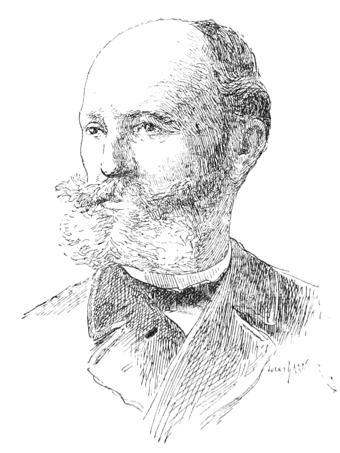
The law endeavoured to oppose the free passage of these trains over the public railroads. Barnum, through economy, at [p018] once proposed to construct new lines for his private use by the side of those already existing. Should the idea of visiting Europe during the Paris Exhibition occur to him, he would wish to acquire the Great Eastern to carry his apparatus, men and animals. The tent which covers his circus is alone worth 30,000 francs (£1,200); it is twice as large as the Hippodrome in Paris, and can shelter 15,000 spectators. In one day it can be erected, a performance given, and the journey renewed. The daily receipts vary between 40,000 and 60,000 francs.
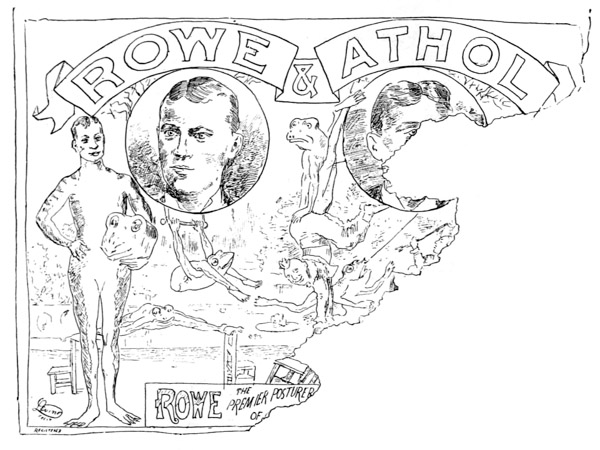
Barnum’s cashiers, although installed in cars containing tills and writing-tables, have no time to keep any books. The daily receipts are forwarded uncounted to Bridgeport in sealed barrels, which are really measures of capacity for gold, silver, and copper coin. The accounts are all kept at Bridgeport. [p019]
A crowd of parasites follows Barnum on his travels and dwells round his tent. A town springs up in a few hours; people throng to it from fifty miles round. But then the arrival of the impresario king has been preceded for some months by immense descriptive placards posted in the localities through which his troupe would pass.
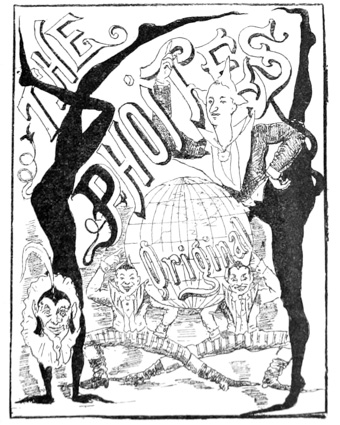
One anecdote taken from a thousand is a good example of the advantages which Barnum has derived from advertisements.
Some years ago a negro, having obtained a reward as a violinist at the Paris Conservatoire of Music, Barnum concluded an engagement with him by telegram for one year at a salary of 40,000 dollars. The walls of New York were [p020] then immediately covered with placards depicting a negro playing the violin, but without any descriptive words attached to the picture.
His virtuoso arrived, and Barnum hastened to produce him. The Yankees came, listened, applauded, but did not send their friends. What could Barnum do to rouse their dormant curiosity? He told his workmen to paste the figure of the negro upside down. This ingenious device was crowned with success. Perhaps the audience who flocked to hear him during three consecutive years fancied that a negro would be exhibited to them—a laureate from the Paris Conservatoire, who would play the violin whilst balanced on his head. Whatever their idea may have been, they went in millions; and this anecdote is not less characteristic of the peculiar stamp of American curiosity than of Barnum’s genius for puffing.
It is also an interesting proof of the share which advertisements play in the success of an entertainment. The artist world has learnt to appreciate the extraordinary effect of these coloured placards, and willingly spends a large sum of money in procuring the most effective designs; and these advertisements—of which I have reproduced a few of the most typical—are so varied and so brilliant that they might fairly dazzle collectors. The finest are issued by the firms of David Allen and Sons of Belfast, Mr. Barlow of Glasgow, Adolphe Friedlander of Hamburg, and Charles and Emile Levy of Paris.
This is the general outline of the organization: of the banquistes, who travel round the world without a country and without home ties. [p021]
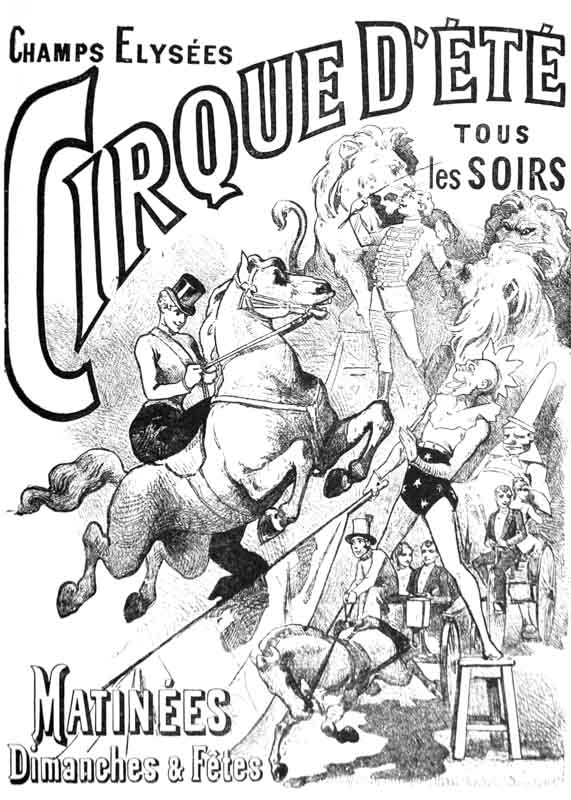
[p022] I must now speak of a less adventurous mountebank—the Frenchman, who never willingly travels either by railroad or steamer, and who for centuries—for generations—has contentedly jogged along in a caravan from one fair to another, making in this way his eternal tour of France.
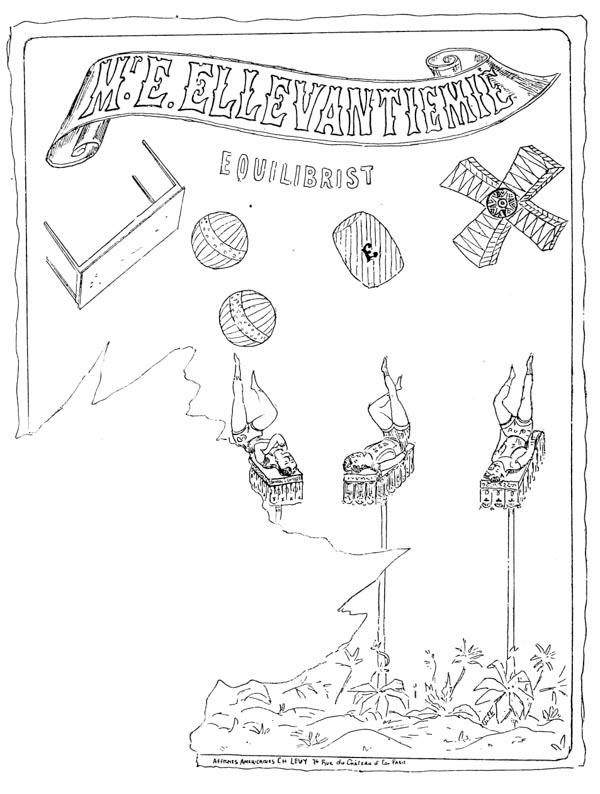
The origin of all these troupes of mountebanks, of every [p023] one of these travelling shows, is lost in the mist of ages. At what epoch were founded the Théâtre Vivien, the Théâtre de Saint-Antoine, the theatres of the Enfer and of the Physicien Delisle? In what century did Mouza-ba-baloued first turn his prophetic wheel under the awning of his caravan? I assure you that it is beyond the recollections of grandchildren or of their grandfathers. At all events, it is certain that from our birth we feel some curiosity mingled with a delicious dread of the mountebank, the picturesque wanderer, who passes our home at the same date in every year—like the migratory birds—who disappears one morning, without any one knowing where he has gone, or even with any certainty where he has come from; an ambiguous individual whom travellers on the high road pass as evening falls, encamped on the wayside, his kettle installed on a heap of stones, his thin steed munching the dusty grass, his half naked children wandering round the caravan, whilst the light shining through the little red curtains in the window throws the semblance of a plash of blood on the road.
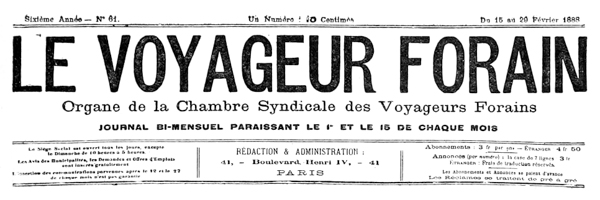
This is the rear-guard, the voluntary laggard, the hermit, who wishes to remain alone until the end. He has not changed any of the customs of his ancestors, preferring to [p024] separate from his comrades rather than conform to new ways. His comrades have therefore renounced him. They will not drag such miscreants in their rear, now that they form a corporation with charters and statutes publicly decreed.

At the present moment the showmen’s world, like all other societies composed of rich and poor, is divided into two great disputing parties. Each of these divisions has its own newspaper, its representatives, the managers of its interests, its public opposition meetings. On one side you will find a group of all the important men in the profession, the proprietors of large establishments—who have serious interests to defend. These gentlemen are the anxious guardians of wealth, amassed with much trouble and labour. The authorities, who wish for the success of the “local fairs,” show special favour to these influential banquistes in the allotment of space. From this undue preference, extraordinary hatred, savage jealousy, result on the part of the smaller folk, whose sole fortune consists of one van, the sellers of gaufres and fried potatoes, the owners of swings and rifle saloons, lotteries, shows, and halls of mystery.
The less important men were the first to organize [p025] themselves. This is already the sixth year of publication of the Voyageur Forain,2 the organ of the syndical chamber of forain travellers, a fortnightly newspaper, published on the 1st and 15th of each month. A notice, always placed above the leading article, informs the readers that “the syndical chamber of forain travellers admits into its ranks all those, whether rich or poor, who honourably earn their livelihood by instructing or amusing the public, or by retail trade.”

The office of this picturesque newspaper is situated in the [p026] Boulevard Henri IV., at the end of a courtyard, above a stable. There I found an extraordinary Bohemian smoking a short pipe, lengthened by a quill, who in himself formed the whole editorial staff of the Voyageur Forain. This man of letters edits the notices of the Fairs, the Correspondence, and all the technical part of the newspaper. The rest of the number is composed of articles by the members of the syndical council. They consist chiefly of diatribes, directed against the party of “bourgeois,” who form a separate band, written in forcible language, which renders them most amusing to any one interested in French slang.
The “bourgeois,” whose names I find at the head of the first number of the newspaper of the Union mutuelle, dated May 8, 1887, were, at the time when the society was instituted:
President: M. François Bidel, manager-proprietor of a large zoological establishment, Chevalier de la Valeur civile Italienne.
Vice-presidents: M. J. B. Revest, manufacturer, part-proprietor: boats (sea on land); M. Ferdinand Corvi, proprietor and manager of a (miniature) circus.
I will skip the treasurers and directors, and quote part of the address given to the subscribers to the Union mutuelle in the programme number:
In France, men have fallen into the habit of regarding the forain as a being apart, at the outside worthy of pity.
However, if we consult our memoirs we shall find that in all ages and in every place great appreciation has been shown for the high moral qualities of this population, which, it is true, leads a peculiar existence, but one which is very honest and perfectly honourable.
Are not these men clever, who group as by magic whole cities within the city itself—cities of pleasure, filled with attractions of every kind, which the [p027] public hasten to applaud and admire? Are they not men of progress, these showmen, whose every trick is copied and appropriated in our great administrations?
In a word, are they not the pioneers of civilization and comfort?
Then why do they appear forsaken? Because they exist only as individuals; because they considered it impossible to obtain cohesion amongst themselves; because, in short, they regarded the creation of a great association as impracticable. The generous assistance of M. Bidel has proved adequate to lead this important phalange. Resolutely placing himself at the head of his profession, he said:
“Union is possible; let us unite!”
Now, the Union mutuelle, which was only founded on the 29th April, 1887, is settled in fine offices in the Rue de Châteaudun. The association is rich. Its members have the right to apply to the superannuation fund at the age of fifty if they have belonged to it for ten years. M. Bidel looks forward to the day when, in order to invest their funds, these restless wanderers over the highways of the world will buy some “house property” in Paris. The Union mutuelle will have tenants of its own. The showmen will be estate owners in Paris. And this hope, which will be realized in a short time, gives the greatest delight to M. Bidel and his colleagues, particularly when they recall the modest origin of the association, the meetings held at the Gobelins, in the menagerie even, where the voices of the orators were drowned at intervals by the roaring of the wild beasts. Every month the Union mutuelle holds a plenary meeting, at which the managers submit their accounts to the members. Every Wednesday the managing committee meets to settle the business of the week.
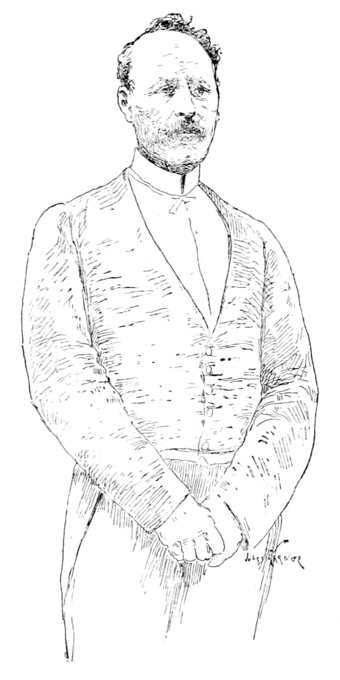
The correspondence is voluminous. Every provincial member of the society who has had to apply to a local [p028] mayor for a license, or to obtain justice, addresses himself to the managing committee to solicit its support, and in this way the showman commands the satisfaction of his claim, which might otherwise have been refused. The interest which the Union mutuelle takes in his affairs is the highest recommendation he can have; for it is well known that no one can belong to the society unless his judicial record is perfectly clear. One may learn many curious things by reading the Voyageur forain and the Union mutuelle. No one suspects, for instance, that the order of the fairs is [p029] organized in an almost unvarying routine, that has existed for many centuries, and that it is arranged so as to diminish as much as possible the expenses of travelling for the showmen.
In each number of the newspaper you will find the following intelligence—Indicateur des Foires du Mois (Guide to the Fairs held this Month). Then follows an alphabetical list of the departments, with all the items of useful information quoted in this way:—
Ain.—1 day: the 2nd, Trévouz, pop. 2,635; the 7th, Marboz, pop. 2,556; the 13th, Bagé-le-Châtel, pop. 727; the 18th, Montreval, pop. 1,475.
2 days: the 22nd, Lagnieu.
Another department, the Review of Fairs and Fêtes, gives exact information to the subscribers of the paper respecting the chances of a good sale, and the disadvantages of a useless removal. The following account of the fair at Sigean is a specimen of these articles:—
“THE FAIR AT SIGEAN (November 6th).
“A small town, 21 kilomètres from Narbonne by road (a railway to La Nouvelle, 4 kilometres). Business has been extremely bad here, owing to the unlucky weather and the total ruin of the country. A few years ago this was one of the most popular fairs amongst showmen, for the inhabitants are fond of amusement and most sympathetic towards strangers. Space is exceedingly dear, the price being fixed by the municipality at 25 centimes the square mètre per diem. It is true that some reductions are granted on this price, but it is still much too high.
“The following establishments were present: M. Bétriou, Museum of Progress, and M. Bracco, theatre of performing seals, Place de la Mairie. In the Rue de Perpignan; Lemaître, mechanical museum; two rifle-saloons; Cloffulia, decapitation; Mercadier, roundabout; a bear-fight; Gras Chognon, panorama; lottery bazaars, massacres, and above all, gambling booths, which enjoy great liberty here, if they can pay well. We saw one roulette-table which paid 200 frs. for two days, and others in the cafés which paid the [p030] landlord 400 frs. for a single table. This is to be regretted—for such toleration to gambling is the ruin of all good and honest showmen.”
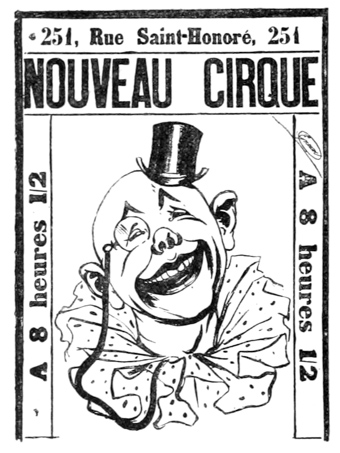
These papers also contain carefully edited accounts of foreign fairs, such as the following letter sent to the Voyageur forain from Karkhoff (Russia):—
“Those of our comrades who do not suffer from cold in the eyes, and are not afraid of being frozen, could try their luck at Karkhoff, where it is only 17 degrees below zero, with 70 centimètres of snow; our friend and correspondent gives us some interesting details about the customs of the showmen and people in Russia: thus in most of the cities it is not unusual to see several shows installed in one booth; for instance, a complete museum of anatomical figures and groups, a panorama, monkeys, crocodiles, giants, dwarfs, and armless women, all shown for 20 kopecks, or fivepence, children and soldiers half-price; no allusion is made to the nurses, or to the treating propensities of Russian soldiers in love.
“These booths remain in the same town for two or three months at a time; this year an exhibition was held at Karkhoff, which preceded the fair, and lasted a fortnight; it consisted of a large museum, a glass-spinner, a large circus, a fine menagerie, a monkey theatre, and an aquarium, besides the town [p031] theatre; and all these entertainments were established in a city which only contains 20,000 inhabitants, that is to say, there were too many attractions for so few people, and no one made any profits; the lower classes are not worth counting, they devote themselves to the consumption of brandy which brutalizes them; and only the nobility, the middle classes and the Jews, who are rather bad than good, can be relied upon. It is impossible to open anything before noon on Sundays or Thursdays and, we might add, that the Russian public is utterly blasé, for it has seen nearly every variety of attraction. Still, it is very fond of marionettes, and the owner of a puppet-theatre, willing to risk a journey in this country, would soon make his fortune; rents are very dear but living is cheap, with the exception of wine.”
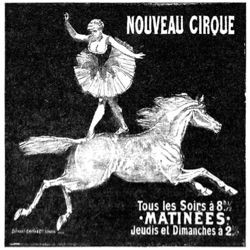
The third page of both the Union mutuelle and the Voyageur forain is filled with advertisements. As usual, these columns are particularly amusing. I need scarcely explain that the following cuttings have been made almost at hazard, and that I have not altered one word of them:— [p032]
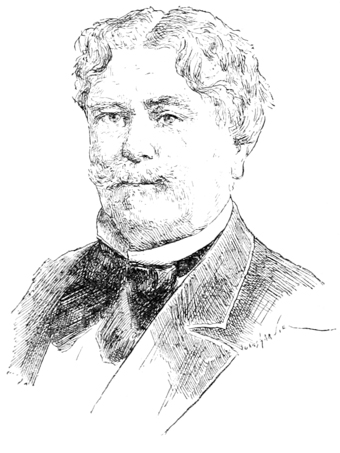
UNRIVALLED OPPORTUNITY.
For sale (on account of family arrangements) a Large Theatre of Performing Monkeys and Learned Dogs, with a Miniature Circus, consisting of a Perfectly New Tent, 28 mètres by 11 m. 40 c.; Chairs and Benches for 800 People, provided with carpets of good quality, the interior well lined with very good carpets, the ceiling of good canvas, the scenery oil-painted and richly decorated; for the outside there is a pretty frontage with a show gallery, ornamented with pictures. The whole has only been in use for one year, and has been well taken care of; in short, it is all new.—5 Vans (or without vans), 1 caravan, 1 van for monkeys, also contains a kitchen; 1 waggon carrying 10,000 kilog., 1 car carrying 15,000 kilog., 1 van for elephants, horses, goats, sheep, dogs, and other animals.—1 Elephant (usual tricks) rides on a velocipede, is worth 15,000 frs.; 6 Well-trained Dwarf-Ponies; 4 Sheep (a performance never yet shown); 15 Monkeys and 12 Dogs, equally well trained.—All these animals are trained and guaranteed, and the purchaser can be taught how to make them perform in a fortnight.—The proprietor of this important establishment is engaged for the winter season in Vienna (Austria).—Orpheum. The whole will be sold for 40,000 frs. [p033]
On the manufacturers’ side:—
FOR SALE an Establishment for Fried Potatoes, entirely new; glass frontage, 8 mètres; depth, 6 mètres; 8 boxes, with a beautiful Belgian stove with 4 frying-holes; 4 saucepans; a cutting machine; gaufre irons; fritter moulds; beer till, &c., &c. The booth is all in panels, with planks, waggon, caravan, and a second caravan 5 mètres long, containing two rooms; advantageous terms, with or without carriages. Address to the office of this newspaper.
FOR SALE a Sweetmeat Business, founded in 1848, well known on the road, possessing an excellent connection. Price 12,000 frs., 10,000 to be paid, and easy terms for the remainder. Business: 35,000 frs. per annum. 156–3906.
Subjects for tamers:
FOR SALE a very large Lioness from the Atlas, 4 years old, works well and is very gentle; Lioness, of the same race, 20 months old, very gentle; Leopard, Panther, Ocelot, White Bears from Canada, Russia, and Malay; large African Monkeys, Baboon, Red-backed Pavion, Monk, Pelicans for shows. Moderate prices.
Lastly in the series of monstrosities:—
FOR SALE ON ACCOUNT OF HEALTH, magnificent opportunity, a superb phenomena of remarkable beauty, elegant, clean, very gentle, at liberty, admired by the whole world. The booth is also very elegant. The whole to be sold on advantageous terms. 87–3290.
The fourth page is filled with advertisements of manufactures—of barrel organs, petroleum lamps, awnings, roundabouts, decorated capitals for riding schools and booths; of glass and china, Chinese umbrellas, and waterproof canvas; of skies, curtains, harness, nose-bags, hobby-horses, mermaids, cars, biscuits, gaufres, sugar-sticks, sweetmeats: of everything that makes a noise, shines or sparkles; that swings or turns; that can be eaten or produces a great effect. And as usual these advertisements amuse us, for we outsiders cannot bring ourselves to look upon those industries which tend [p034] only to procure objects of amusement for us, in any serious light.
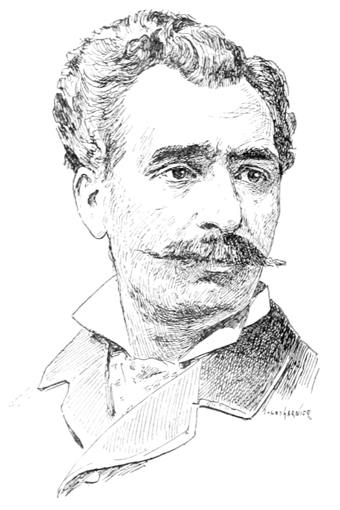
Most of these articles are manufactured in Germany. The oldest manufactory of roundabouts of wooden horses is in Moblitz in Saxe-Weimar, another is in Thuringia. Still, there are a few French manufacturers in the field, and their productions, although a little dearer than the German ones, are much appreciated by showmen, for the good taste which distinguishes them. M. D———, de Vic Bigorre, (Hautes Pyrénées,) a celebrated curtain and scene-painter, is one of these artists. The following notice is added to all his advertisements—
“Note.—Himself a child of the fair, M. D——— is well acquainted with the necessities and style of picture required by each individual, and by this title, he recommends his work to all the children of the banque.” [p035]
Another is a specialist for the vans used for carrying plant, dentists’ cars, breaks for driving parties, caravans, &c.
I saw one of these model caravans at the Fair du Trône; it contained dining and drawing-rooms, a bedroom and servant’s room. Through the open window of the drawing-room, I heard the refrain of one of Métra’s waltzes. I went nearer and saw that the musician was a charming young girl, wearing a plush dressing-gown, conscientiously practising the piano.
I leave you with this vision of middle-class prosperity. I hope it will correct, as far as may be, the very false ideas which hitherto you may have cherished about banquistes and their wandering lives.
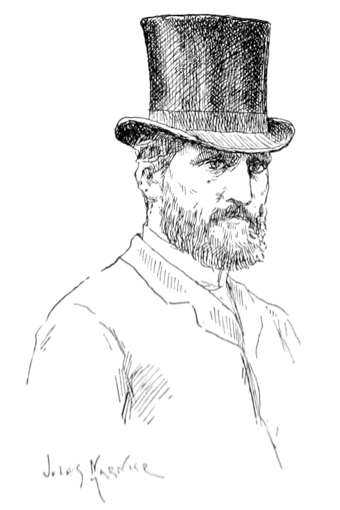
[1] Grande banque is a general term for large shows and theatres in a fair.
Petite banque is used for small shows, such as “fatma,” giants, &c.
Banquistes includes all persons showing or performing on a fair ground, circus, or variety entertainment.
I am indebted to Mr. John Holden, the owner of the popular Palais des Fantocche, for these definitions: there do not appear to be any equivalent words in English slang.—Note by the Translator.
[2] Forain is the cant word used for all merchants with their wares who sell in fairs, but it is also applied generally to all owners of travelling shows and amusements. See Chapter II., page 37.

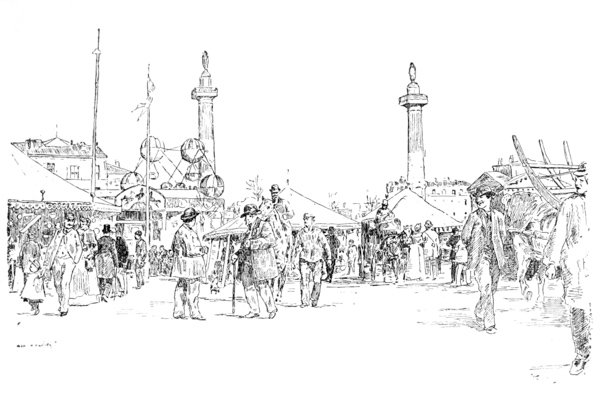
Fashion, which regulates our amusements, has decreed for some years past, that when at Easter time we direct our steps to the Fair du Trône, our little excursion is quite “the correct thing.” The faubourgs and suburbs no longer enjoy the monopoly of the fun collected at the foot of the two columns, the caps of the swells from Vincennes, and the hair-nets of the Cytherean bataillon from Montreuil-sous-Bois are no longer the sole head-dresses visible. The Gingerbread Fair has its reserved days like the Opera and the Comédie, and on Tuesdays and Fridays the largest profits [p038] are made. Really, if you strolled in that direction about five o’clock on one of these select afternoons, you would be surprised to see the long line of carriages standing in the Faubourg Saint-Antoine and the Boulevard Voltaire. For every three cabs, in which a party of students are enjoying themselves in somewhat noisy fashion with their little companions, you will find one gentleman’s carriage with servants in livery, or, at least, a hired victoria occupied by women in over-smart dresses, who are making their annual excursion to the fair, accompanied by the “mashers” of the year. It is curious to watch these society people when they visit this populous district which they have never seen except through the windows of mourning carriages on the road to Père la Chaise, or on the eve of a capital execution, lighted by the windows of the small taverns in a cruel bustle of festivity. Secretly, they feel a little uneasy. The too demonstrative enjoyment, the cries, shouts and songs, the incessant rattle from the rifle saloons, the explosion of fireworks, the pushing crowd struggling round the stages of the various booths, from which the showman harangues the crowd, recall, in spite of themselves, memories of civil war and the barricades, and produce a gentle shiver—that shiver which steals down the spine in front of a wild beast cage, if the thought occurs to one that the iron bars might give way, and the lion in his fury be free to rush upon the spectators . . . . . . But in itself, this secret, indefinable misgiving is rather pleasant, and it is certain that this semi-dread forms half the pleasure which many pretty women feel in venturing amongst the crowd and exposing themselves to a somewhat rough hustling from the people.
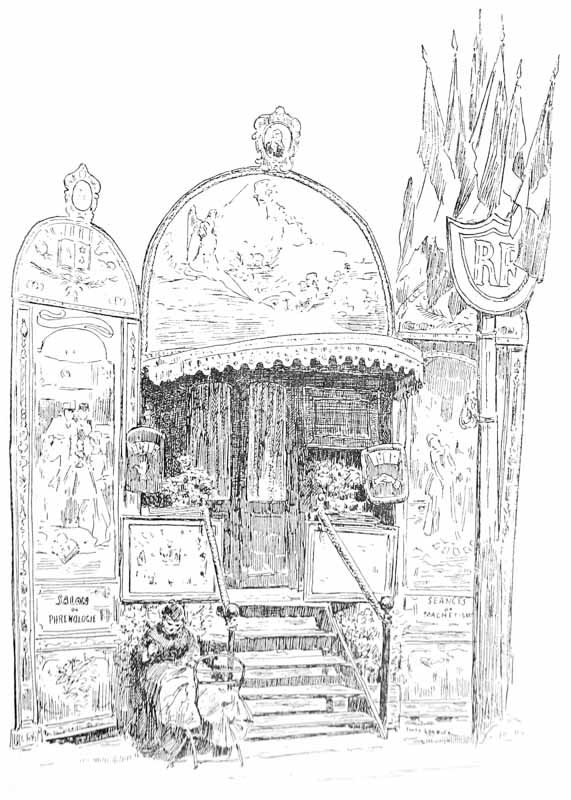
However, when we emerge from the shadows of the [p039] boulevard and faubourg into the brilliantly lighted square, timid hearts regain courage, and we at once catch the infection of the gaiety surrounding us. Every one is come for amusement and intends to get it. We see all the [p040] monstrosities, all the beautiful Circassians, consult all the somnambulists, and visit all the booths, make excursions in the switchback railway and take the traditional turn on the roundabouts, filling up the intervals by breaking pipes, slaughtering marionettes with balls, and throwing the hammer at the Turk’s head. And then the late drive back to dinner in the cool evening air, the slow recovery from the effects of so much laughter as we roll towards the Boulevards, with paper roses in our button-holes, the carriage filled with gingerbread from Rheims, comic figures, symbolic animals, and effigies of Saint Remo with mitre and crosier, which resemble primitive bas-reliefs in old oak torn from the stalls of a church choir.
I also make an annual visit to the Gingerbread fair, but not as a lounger who follows wherever the crowd leads him. I am accompanied to the Champ du Trône by the best of guides, one of the most brilliant correspondents of the Voyageur forain to which I referred just now—M. Philippe, the editor of the Tir de la Republique.
M. Philippe was formerly a sailor; and has retained from his sojourn on the men-of-war the naval cut of his beard, and the cap which he wore during the expedition which he made to the North, when he saluted the Pole in the neighbourhood of the Behring Sea. This retired sailor is a very intelligent man, of a stamp which only flourishes in the atmosphere of Paris; a gunsmith by profession, the vicissitudes of existence and a taste for adventure have made him, as a last expedient, a showman’s journalist.
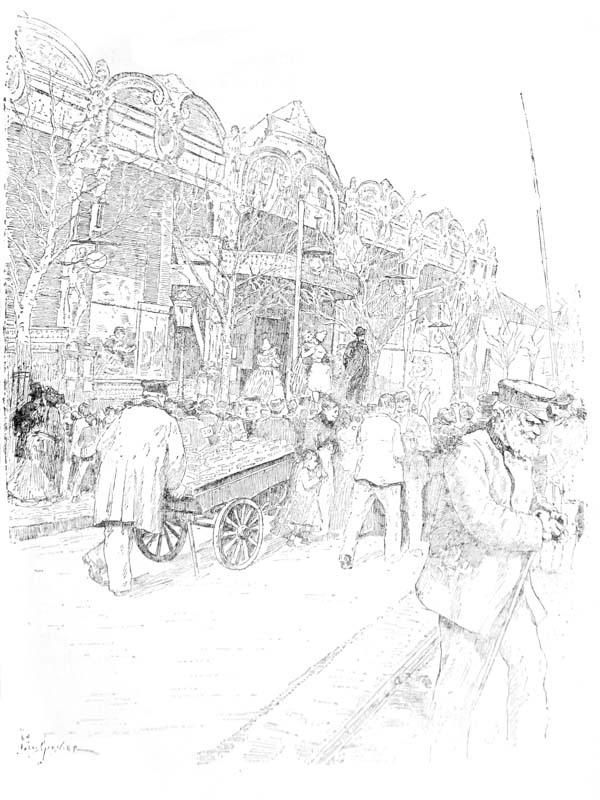
To ensure this excursion passing off with due success, it is always preceded by a short conference held between two glasses of beer, in which, elbows on table, my guide gravely [p041] reminds me, that I must be careful to remember the distinction that exists between the forain and the banquiste, the grande and the petite banques.
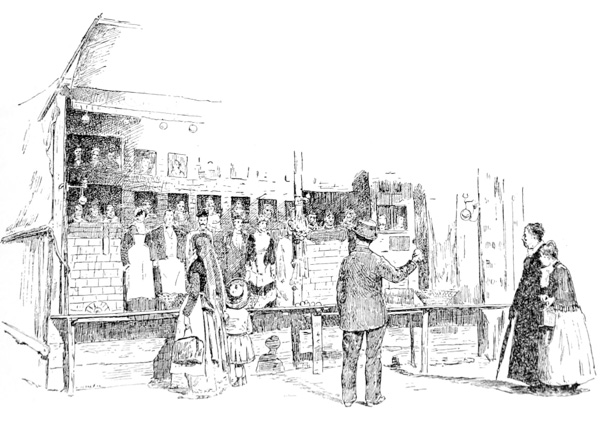
A forain is technically a merchant, or the owner of a game. The sweetmeat-maker who, surrounded by a circle of admiring children, rolls serpentine rings of paste round a flexible wand laden with little bells is a forain, so is the fritter merchant; the same term describes the rich agent of the manufacturers of Rheims and Dijon, who travel round the world carrying with them the best brands of gingerbread. The celebrated M. Exaltier, the director of the American Galleries, is also a forain; by the ingenuity of his inventions he has revived the public interest in panoramas. The same term describes the clever M. Chable, the manufacturer of the finest hygienic horses that have ever been [p042] seen, splendid animals made of varnished poplar wood, stout as a Flemish mare, which cost him two hundred francs each.
“They were dearer than if they were alive,” cheerfully repeats M. Chable, caressing his steeds, “but I save it in the food.”
The post-master of hygienic horses is an important personage in the forain world, and so is also the proprietor of the “Crystal Palace,” the most luxurious roundabout of hobby-horses at present in the Fair du Trône or anywhere else. His tent contains no less than two organs; one of them cost him 5,000 fr., the other 12,000 fr. His daily expenses amount to eighty francs for his establishment; but a fine Sunday doubles his receipts in a marvellous way, and the “Crystal Palace,” when all the three sous a ride have been counted up, often makes a thousand francs in one day.
All the keepers of billiard-tables, the owners of wheels of fortune or lotteries, are forains. A complete and most curious book might be written on the fraudulent games of chance which swarm in a fair, in spite of the vigilance of the police. I shall write one some day when M. Carrabilliat, one of the most intelligent and most respected members of the syndicate, has completed my education. To begin with, he explained to me the mechanism of his race game, an amusement which, although forbidden for a time, is now permitted in the fair since the owners have proved the impossibility of tampering with the small horses or of preventing the slight bars upon which they move from turning freely round the course. The good-natured public more than suspects some tricks. It knows by experience that the rabbit is never won at the first shot, and that no one within [p043] the memory of man has ever carried off the clock with its glass shade. This fact does not prevent it from paying its pennies to the owner of the wheel of fortune, or check its eager competition with chance as a partner, for the possession of a little glass chandelier. Here, as at Monaco, you will find the gambler who gets excited and ruins himself—alas! the poor fellow loses all self-restraint if the bystanders gather round him, watching and discussing his luck!
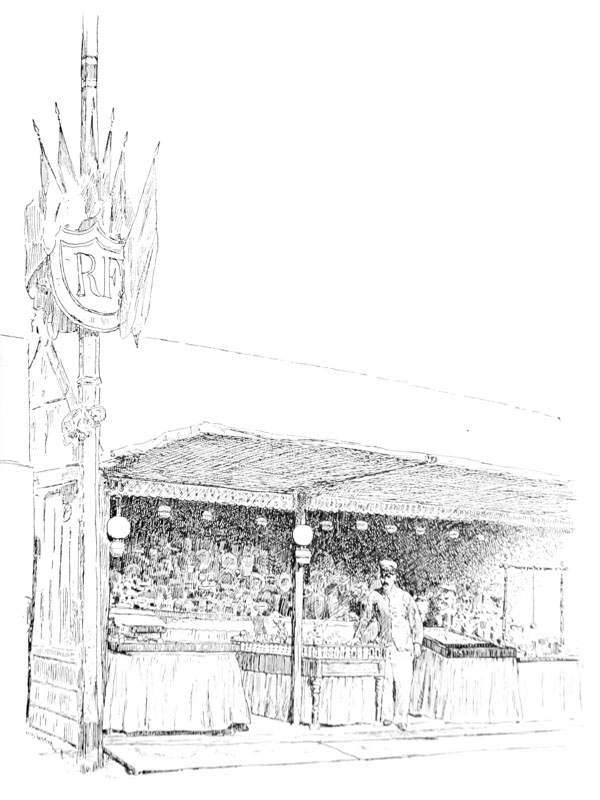
I, who know all the secrets of the fair, would charitably whisper to the imprudent gambler that there are always some accomplices in cant—“stallsmen”—amongst the lookers-on. These individuals are particularly addicted to loitering near the rifle saloons, and the games which require strength and skill. They it is who whisper at your back—
“Well shouldered! a little too low! What a pity! It would have broken the egg. Stop, Arthur, perhaps the gentleman will try again.”
The “gentleman” feels flattered, takes some silver from his pocket, and with an innocent air the proprietor of the saloon pours twelve caps into his hand.
The rifle-shooting, the hammers, and the rings are all manly sports. Ladies prefer the hobby-horses and the swinging-boats. You know what perfection has been attained in this last amusement for the gratification of those who, like Hippocrates, believe in the utility of spring remedies. They clear the system. From this point of view the new swinging-boats are serious rivals to all quack medicines. Those who have not travelled round the world can enjoy in these cars all the spasms of sea-sickness and every variety of giddiness. In these respects the old system gave full satisfaction to many worthy people; but it appears that, compared with the new fashion, like the apparatus in the Rue Basse du Rempart, the old swings were mere child’s play. Some travellers descend from this invention in much the same state as the wolf which Baron Munchausen turned inside out like a glove! Where will progress stop? But progress is very inconsiderate when it attempts to substitute velocipedes and wild beasts for the old hobby-horses. Have [p045] the inventors of these machines never spent one quarter of an hour in front of the old roundabouts? Have they never noticed the defiant, haughty glance which the young shopmen and little milliners throw at you as they pass in the course of their revolutions?
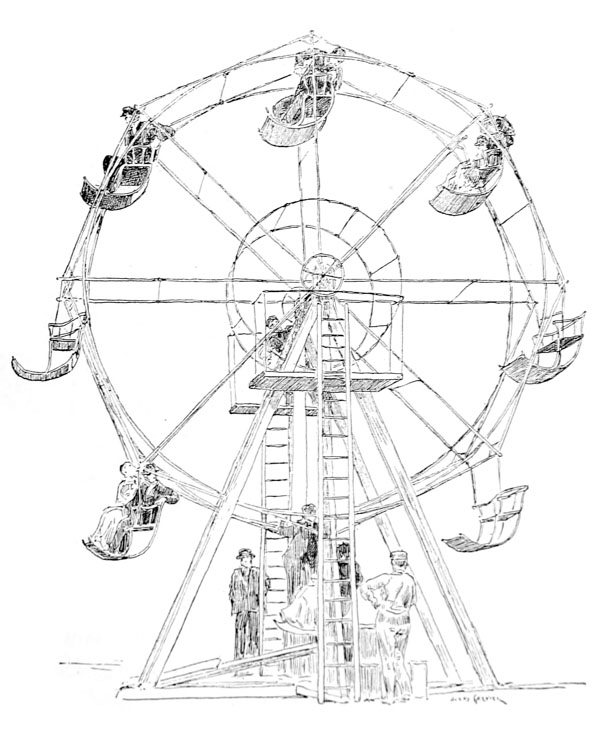
Those people are in a dream. For one whole minute they [p046] imagine themselves in a higher sphere, riding in couples through the woods. Intoxicated by the revolving motion which, through the necessary bend of the body nails them to the saddle, they feel like accomplished riders, incomparable horsewomen. Watch them there, ye pioneers of a mistaken progress, who have not taken the instincts of the heart into your calculation and cannot, therefore, understand the philosophy of hobby-horses! A little attention will yet avert the failure which threatens your riding-schools of velocipedes and carnivorous animals.
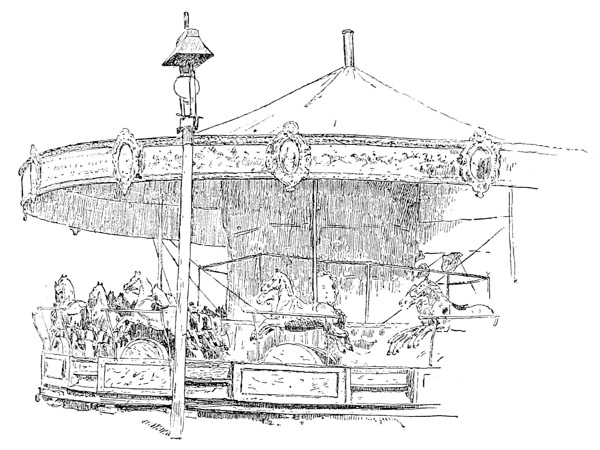
But these are all noisy amusements which the society people avoid. Do you remember, my dear friend, the drive we took outside the shows and bands, one fine Easter-Tuesday, brilliant with sunshine? You dared not leave your brougham, [p047] you were so alarmed at the hoarse roar of the crowd, the explosion of crackers, the shrieks of the women in the swings. Still you had one great desire that you would not own to me, half dreading a reproof, a wish evoked by a most appetizing odour which made your nostrils dilate.
“I am sure you are longing for some fried potatoes,” I cried triumphantly at last.
Ah! who would ever forget the glance with which your eyes rewarded me for guessing your fancy!
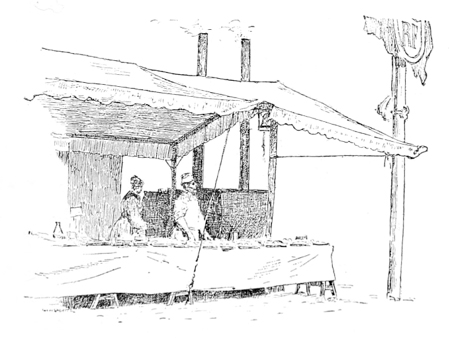
And, much to the disdain of your English coachman and footman, both sitting so correctly on the box, I fetched you some beautiful hot potatoes nicely powdered with salt. And in your satin-lined coupé, touching them daintily with the ends of your lavender-gloved fingers, one by one, you ate them, seasoned with merry laughter.
“Oh, Time, arrest thy flight!” . . . . .
Five o’clock struck: it was the last effort of the fair before [p048] the neighbourhood commenced the evening meal. The clowns joked and shouted louder than usual; the rattles, gongs, pipes, drums, speaking-trumpets, barrel-organs, and whistles of the steam-engines all sounded together in a final tremendous discord. Through the clamour, the crowd, eddying like a stream, ascended the Avenue de Vincennes, going towards the columns erected on the spot where the fire took place.
Between them, the disk of the setting sun was shining like the Pyx upon an altar. And as it suddenly disappeared behind the hill, a cry rose in the air, stifled, agonizing, which threw you trembling upon my shoulder—a cry which pierced above all the clamour of machinery and men—the captive lion’s farewell to the darkened sun!
It is a great mistake to imagine that all fairs are alike. Each of them, although composed of the same booths, assumes such a different character from the locality where it is installed and the people who frequent it, that any one interested in such matters, like myself, could easily make a bet, that carried blindfolded into the midst of any local festival, when his eyes were uncovered, he could at the first glance distinguish which fair was being celebrated. And he could tell, simply through seeing the visitors, who thronged it, and by inspecting the stalls.
Look, for instance, at the old fair held at Versailles, the fair of Saint Louis, which, annually, in the heart of August, placards on the doors of the railway stations, between the lists of circular excursions and the advertisements of summer pleasures, long descriptions of its attractions: water-jousts, fanfares of horns sounded through the alleys of the park, display of fountains in the Neptune basin, shows accompanied [p049] by big drums, the music of the roundabouts, the gaiety of the little booths, side by side with the great empty palace. Is it through the immense width of the alleys that the noise of the bands seems scattered and lost? Or can it be a secret dread of disturbing the king’s slumbers, which still haunts all these small folk, and causes them to subdue the rough music of their orchestras?
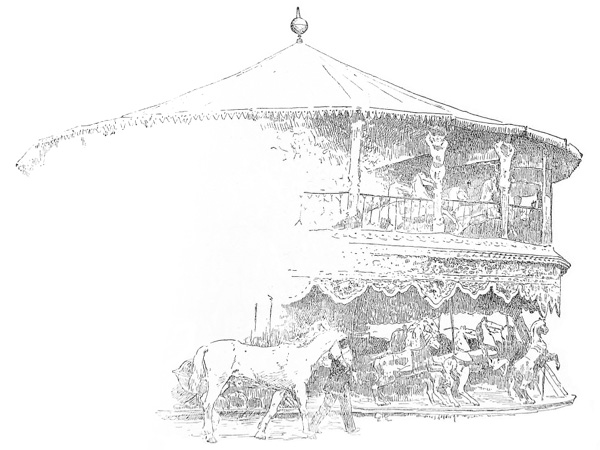
Surrounded by barriers, this agglomeration of diminutive white shops resembles a flock of timid sheep huddling close together, not venturing to ring their bells too loudly through fear of the wolf. Here, too, are stalls of rosaries, holy-water vases, and crucifixes, recalling the sacred origin of the fair.
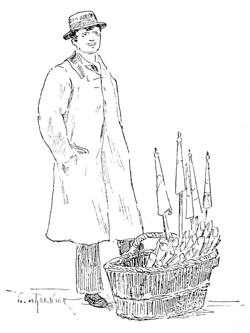
No doubt you will recognize the same faces that you have [p050] seen everywhere else; the same brightly painted caravans, with small muslin curtains in the windows; the same gaufre-seller, mixing the same paste, in the same moulds, with the same gesticulations; and lastly the same horrible trumpery, utterly devoid of any originality: blue-eyed dolls, miniature Zouaves, sixpenny knives, imitation tortoise-shell frames, rabbits playing the drum, reed pipes, and brass trumpets. No one knows why workmen are so entirely bereft of imagination or self-respect as to persevere in the manufacture of these inferior toys for at least a hundred years; yet these “fairings” travel all over the world. You will find them in Algiers as soon as you land; on the threshold of Asia, at Constantinople, shops full of this rubbish are installed side by side with bazaars for Turkish carpets; the ships which bring from Japan the delicious knicknacks which fill our houses, [p051] return to the far East laden with cargoes of plush frames and rabbits playing drums.
But the idiosyncrasy which distinguishes Versailles and its neighbourhood, the chosen retreat of literary men and elderly magistrates, is the presence of the dealer in old books who annually attends this fair. From a little distance the reddish-brown covers of his wares resemble gingerbread paving-stones. Men in spectacles bend lovingly over the stall, the scent of mouldy leather gently tickling their nostrils.
And every year there is one stall at which a woman sells false hair by the pound. Hanging round like horses’ tails, side by side, these poor tresses, collected from the gutter and the hospital, produce a tragic effect. One anxiously wonders where all these dull-looking plaits come from; who will wear them next? One day I lingered about for some time, waiting to see if a customer would appear.
At last a woman drew near.—Ageless, in mourning, basket in hand, unclassable; yet evidently not a happy woman. At first she dared not pause, then she regained courage.
“How much is that?”
“Five francs.”
She hesitated for a moment.
“It is too fair for me. Can you see what I want?” And she raised her veil from her face.
At length she passed on without buying. There was nothing grey enough for her.
The fair at Versailles is a provincial fair, a fair patronized by grandfathers and grandchildren, nursemaids and soldiers.
The typical Parisian fair, the chic fair, is held at Neuilly.
In April, when the Avenue de Vincennes, the Boulevard [p052] Voltaire, and the Faubourg Saint Antoine are decorated with rows of white stalls, the cold winter wind still sweeps over the earth, rushes through the wide streets, carrying with it clouds of dust, blusters through the fair, filling the canvas of the booths like sails on the sea, powdering the gingerbread stalls as it passes; then in rough leaps, as though driven by a whip, forms dusty columns in the air, and rising several feet above the ground triumphantly waves the flags above the booths and roundabouts.
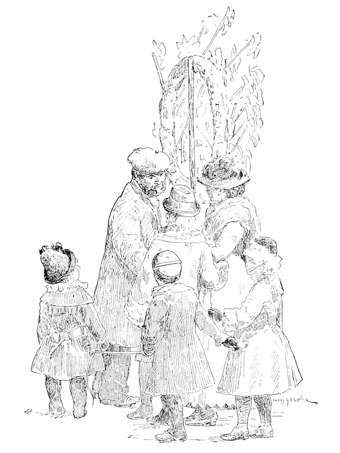
It makes the evenings too chilly for sauntering about, hands in pocket, under the illuminations produced by the waving [p053] lanterns and the flickering gaslights! one feels too cold to care for amusement or refreshments. And therefore when after dinner the frequenters of the cafés on the boulevards hail the club coupés, they never dream, as the door is closed on the still wintry toilettes of their companions, of saying to the coachman, “To the Fair du Trône.”

They turn to the concerts and the circus. There is too much chilly darkness, too long a drive through the deserted boulevards, between the dinner and the suburban fête. The exhilaration produced by champagne and laughter would die on the way.
Neuilly is the evening fair. It opens in the heart of summer, [p054] in the full tide of that excessive heat which renders the drawing-room and theatre equally unbearable to those Parisians who wait for the month of August before they go to the sea, and who live in tea-gowns, fan in hand, sipping ices and lemons, behind their closed Venetian shutters. Like passengers in the tropics, who watch for the setting sun before they go on deck, these pretty women reclining in their bamboo chairs, impatiently follow the course of the clock-hands, so slowly travelling towards five o’clock. At that hour they get up, and in the semi-light of the dressing-room, with lowered blinds and wide-open windows, they leisurely array themselves in fresh and scented toilettes. They are going to dine in the open air, on the terrace of some restaurant in the Bois. Capes and mantles are too heavy during this month, and a young woman can go out without any wrap hiding her charming dress; she only carries a small shawl and one of those parasols, which, itself brilliant as a flower, enhances the effect of the whole toilette and, whilst intercepting the sun’s rays, throws most becoming shadows on the face.
Then about six o’clock, at the doors of the Ministries and all along the Quai d’Orsay, a line of light, open carriages may be seen, in which young women have come to fetch husband or lover, soothing their impatience for the hour of freedom by noting the admiring glances of the passers-by. And when at last the lingerers appear in grey hat, white waistcoat, short coat and smart buttonhole, the couples lounging back in their carriages, drive through the Avenue des Champs Elysées, towards the summer restaurants and the shade of the Bois. The Pavillon d’Armenonville reaps the greatest [p055] advantages from the vicinity of the fair. The orchestra of the Tzigane Rigo, hidden in the gardens of the pavillon, first attracts the notice of the passers-by; they draw near, lean over the hedge, and look in to see if any one is seated at the little tables.
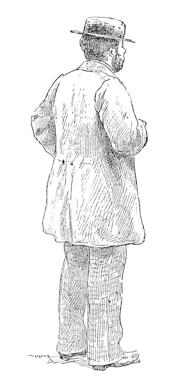
“See, there is so-and-so, and so-and-so, C——— and B———.” Political and literary men, artists, financiers, women of both worlds, the recognized and the unrecognized, the Luxembourg, the Palais Bourbon, the theatre, the newspapers, the drawing-room, and boudoirs. The guests seat themselves under the verandah, to watch the carriages drive up. The table-napkins are dazzling in their snowy whiteness against the green leafy trees, the ice melts in the silver bowls, and the freshly cut cucumbers resemble aquatic leaves, torn from the pond of [p056] water lilies, which we only glimpse at through the hanging branches of the willows.
Hours pass pleasantly, languidly, in this festive scene. The Rakoczy March, the Stephanie Gavotte, give a tinge of gallantry and love to the reverie into which we fall, daydreams vague as the outlines of the landscape before us.
And the spell lasts, until suddenly, lights, which are not reflected from the stars, appear mirrored in the waters of the tiny lake. They shine from the red lamps of the victorias now being lighted.
Night has fallen.
It is time to go to the fair.
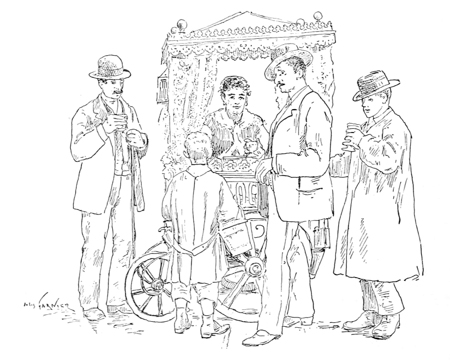
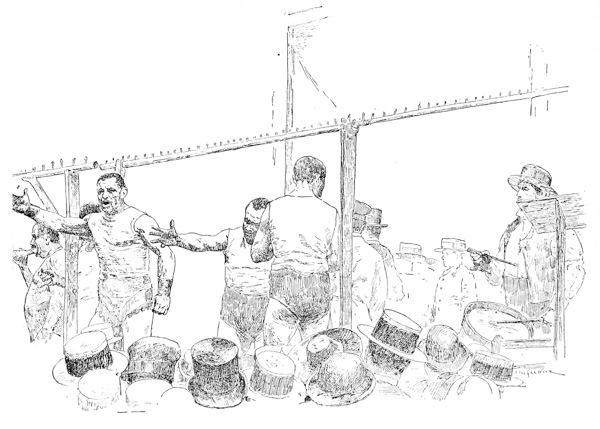
The visit to the fair usually commences by the entresorts, or permanent shows.
What are entresorts?
I must again quote my friend Philip, the ancient mariner, whom I introduced to you just now, at the present moment editor of the Tir de la Republique, municipal councillor, and editorial secretary to the Voyageur Forain.
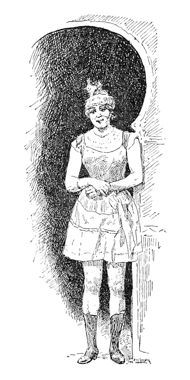
“In the cant idiom used by the petite banque, we describe [p058] by the name of entresort any booth which contains a permanent show without beginning or end, an establishment which the public only walks through. Waxworks are entresorts, so are exhibitions of dwarfs, monstrosities, learned fleas, and tattooed women. The booths which contain catch-pennies, somnambulists, conjuring tricks, fat women, and pretty girls, are also entresorts if you like, but they are more frequently termed Halls of Mystery—I need scarcely tell you why.
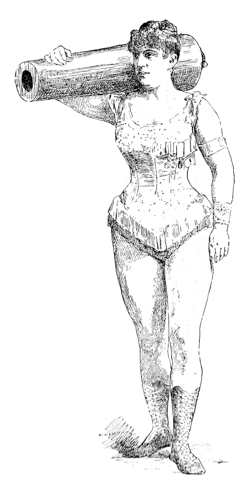
Entresorts and Halls of Mystery always swarm in every fair. They are cheap amusements largely patronized by the [p059] crowd. And whilst the more important shows have changed all their entertainments and have introduced unlimited improvements into their theatres, the entresort has not altered either its arrangements or its exhibition since the origin of time. It is always established in a canvas booth, sometimes provided with wooden benches lighted by four oil lamps; while the show is usually of an alarming nature—scenes from the [p060] Inquisition, executions, heads of celebrated murderers, exhibitions of monstrosities, of five-footed sheep, armless artists, calves’ heads, giants and dwarfs.
No one should wonder at the fact that many people are more interested in the abnormal than in the beautiful. But this trait being once recognised, the dwarf is more wonderful than the giant; man is such a complicated machine, that in watching these microscopic creatures who gesticulate and speak like ourselves, we feel something of the same astonishment that would strike us if we found the seconds marked by a miniature watch which we could only see through a magnifying glass. For this reason the dwarf show is one of the most popular booths in the fair.
Every one knows that there are two kinds of dwarfs—those who are naturally dwarfs, and those who, as children, were at first of average size and growth, but whose development was abruptly checked. In their case the limbs which no longer grew, were yet capable of enlargement. As a rule the head is enormous. Monsieur François, from the Cirque Franconi—the partner of Billy Hayden the clown, the tiny circus rider—is a typical specimen of this class of dwarfs, who are called noués to distinguish them from the perfect miniature of humanity. They are physically deformed, but in all other respects they resemble other men. François, for instance, is very intelligent. I shall always remember our first interview two years ago in Erminia Chelli’s box at the Cirque d’Eté.
“How old are you, Monsieur François?”
“Twenty.”
“I am older than you are, M. François; yet, as you know, I am not celebrated.” [p061]
M. François shook his head, and as a consolation—“you see not every one can be a dwarf”—he gravely answered:
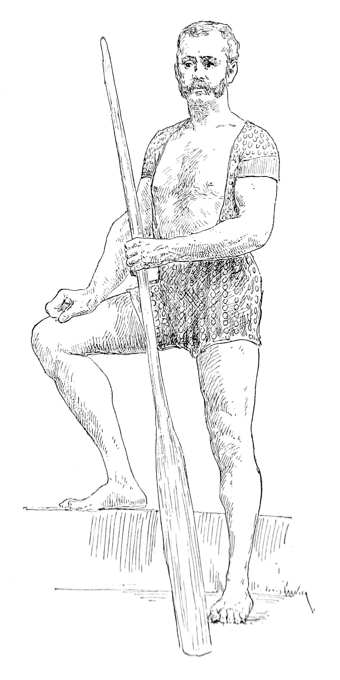
“Do not pity yourself, sir; you are distinguished for your learning.”
Since then M. François has told me all about his present life. He lives at Villette with his mother, whom he supports. In the evening, as the distance is too great for his short legs, [p062] he goes out by the last omnibus, and even when the vehicle is full, he is charged for his place.
“Yet I take so little room, sir!”
M. François is a brave lad; and those who have seen him in his Cordovan boots, driving his team of six horses, know that he is an exceptionally good whip. It should though be noticed, that however deficient the noués may be in size, they possess the same intelligence and sometimes the full strength of a man of normal height. In 1802 Germany possessed a clever painter named Jacob Lehnen, who was exactly 3 ft. 10 in. high; and I read in an English newspaper, the Daily Advertiser, dated 18th August, 1740, an announcement of the arrival at a London tavern, the Great Glass, of a Persian dwarf called the Second Samson, only 3 ft. 8 in., who carried two strong men at arm’s-length and danced between the tables with his double burden.
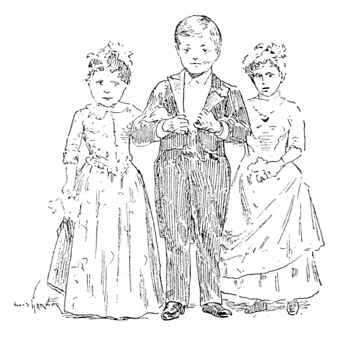
These deformities are not attacked by the decrepitude which prevents their comrades from living beyond their [p063] twentieth or twenty-fifth year. There are historical instances of centenarian noués.
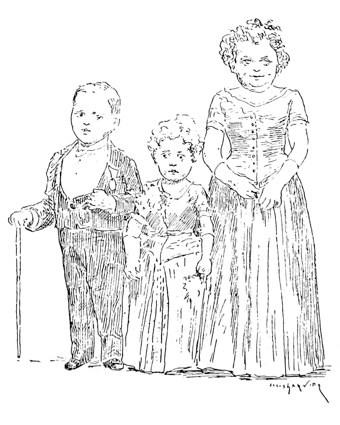
In 1819, at the Court Theatre, a noués was exhibited aged sixty-three; her name was Thérèse Souvary, and according to the advertisements, she was betrothed in her youth to Bébé, a dwarf belonging to good King Stanislaus. And if these advertisements were untrue, there are proofs in other places of a great many marriages contracted by dwarfs, who have had large families. M. Edward Garnier, in his curious pathological study of the noués, quotes the case of the painter dwarf Gibson, who married a wife as small as himself and had nine children by her, of whom five were of average height and attained manhood. Two other dwarfs, married in London, Robert and Judith Kinner, had fourteen children all well made and robust. Lastly, any one may have seen in the Western papers in 1883, the notice of the death at Sables d’Olonne, of a little dwarf long exhibited in fairs under the [p064] name of the Petite Nine. This tiny creature, who was not more than 31½ inches high, married a M. Callias and had several children by him. She had even survived the Cesarean operation, and reached a great age notwithstanding her scandalous insobriety.
In spite of the intelligence of the noués I quite understand why no one becomes devoted to them; but it is quite another thing with regard to natural dwarfs who, whilst remarkable for their extremely small size, yet retain in their miniature forms the æsthetic beauty of proportion. All Europe has seen in the circus or in the fairs, one couple of these elegant dwarfs, General Mite and Miss Millie Edwards, whom Barnum launched upon the world under the name of the American Midgets.
If we may believe the manager who superintends the travels of the Midgets, they are both American citizens. Their respective families advertised their matrimonial requirements—a young man of six inches wishing for a suitable wife, and a young girl of five inches wishing for a husband of six; they journeyed towards each other across the world, and were married at Manchester.
The Midgets have prospered in worldly matters. They are engaged at a very high salary of some thousands of francs per month, and will be able to provide handsomely for any children that Heaven may send them. Their dress and food cost them very little. The “General” usually dines upon half a biscuit and a few carefully-measured drops of wine. He is marvellously jealous of his wife, and when I once advanced to her carriage to help her to alight, Mr. Mite pretty curtly informed me in English that he kept a footman on purpose to attend to her. [p065]
But it appears that the General is not only jealous, he is also fickle: he had brilliant success in England. I tried to make him talk about it, but like an honourable man, he was mute upon the subject, and his present impresario told me that he had often attempted to sound him upon the point, but had met with no better success than I had done.
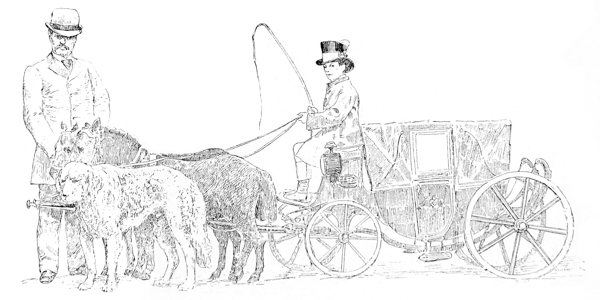
General Mite sings the tambour-major’s song extremely well; manages a “sociable” tricycle like a professional, and waltzes gracefully. The General is very brisk, very lively, a wonderful mimic; he acts several little pieces with real talent—amongst others, a scene of drunkenness, and the promenade of a New York dandy.
But neither the General nor his wife possess the same charm as Princess Paulina. I have been quite close to this wonderful little creature and taken her by the hand, which, like the whole of her person, is modelled with infinite delicacy. [p066] She might be taken for a waxen statuette, a tiny dancer from Tanagra freshly exhumed, with a little carmine still clinging to her lips, a little gold to her tunic.
One might apply to Princess Paulina the same praises which Loret, in 1653, addressed in his “Gazette” to “a little dwarf belonging to Mademoiselle,” who was suffering from a cold on the chest produced by the slamming of a door—
“Jamais près de Roy ny de Prince3
On ne vid de naine si mince.
Quand une puce la mordait
Et qu’icelle se défendait,
La puce pour finir la guerre,
La mettait aizément par terre,
Et la moindre haleine du vent
La fazait tomber bien souvent.
Enfin, elle était si petite
(Quoiqu’aucunement favorite),
Que, dans un petit balancier
De cuivre, d’arain ou d’acier,
Ètant par plaisir un jour mise,
Avec robe, jupe et chemize,
Et de plus sa coiffure encor,
Tout ne pezait qu’un louis d’or.”
“Princess Paulina,” says the voluble individual who advertises her to the public, “is eleven years old. She is of Dutch origin, and measures 15¾ inches, and weighs ten pounds; she is introduced by her brother who is with her.”

And the robust stripling lifts the little doll like an ounce: he holds out one arm and, in the pleasantest manner, the little princess performs a few acrobatic feats over it. She is very [p068] proud of this little social talent. When I was introduced to her behind the scenes, she courteously said:
“Shall I turn a somersault for monsieur?”
And in an instant she was standing on her hands, head down, feet in air, like a clown. With her tiny dress of coral-coloured muslin and satin flying out around her, Princess Paulina did not look any larger than a bouquet of roses enveloped in white paper.
I asked her all the questions that etiquette requires when speaking to a dwarf.
“Princess Paulina, have you a doll?”
“As large as this, Monsieur.”
She raised her hand above her head, but even then it only reached the medium size of the Bébés Hurel.
“Princess Paulina, what did you eat for dinner?”
“Six oysters and some breast of chicken.”
“Princess Paulina, do you speak English?”
“Very well.”
“Princess Paulina, can you speak German?”
“Sehr gut.”
“Princess Paulina, will you give me a kiss?”
“Kiss a gentleman!” cried the little princess, quite alarmed.
And she consulted her tall brother with a look. The tall brother gave an affirmative nod of the head, and the princess submitted to the caress—this is how I am able to inform those who may not be aware of the fact, that, like new-born babies, a little dwarf smells like a grey mouse.
But there is no need for sensitive souls to distress themselves about these fragile beings. Vanity is quite as strong [p069] in a dwarf as in a man, and every “Princess Paulina” in the world is pleased to be exhibited. Besides, the parents of these goslings with golden eggs are too much interested in prolonging their lives ever to maltreat them. Those who should be pitied are the poor children sold once for all to a speculator. One of these dwarfs met with a tragic fate some years ago.
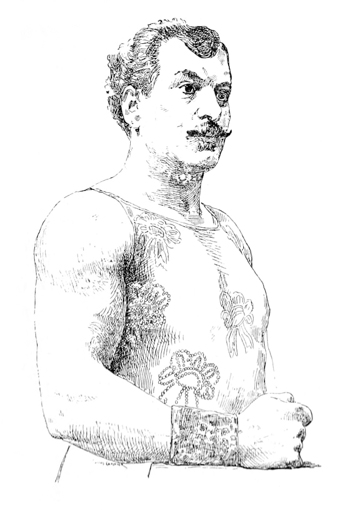
He was named Joseph. At seventeen he measured only 27 inches, and had a thin, woebegone face rendered grotesque by an enormous nose which, like his hands and feet, was abnormally large. [p070]
His parents, small agriculturists at Saintes, sold him in 1882 to a mountebank, who endeavoured to increase the popularity of his show by making this scrap of a man become an animal-tamer.
By dint of great patience six cats were painted to resemble tigers, with yellow and black stripes. The animals were shut into a cage with the dwarf, and the unlucky Joseph, half dead with fear, was forced, with the aid of a riding-whip, to make the cats perform.
The attempt succeeded for some time, when on July 12th, 1882, at the fair of Beaupré-sur-Saône, one of the cats suddenly flew at the dwarf’s throat and threw him down by its weight.
In one second all the other cats had rushed upon Joseph, and before any one could intervene, the cat-tamer was strangled, his eyes torn out, his face covered with blood.
The mountebank fled: a few days later he was arrested at Lille.
I was lately discussing this tragic accident with M. François, and my friend, who was drawing on his riding-boots, paused in the effort to utter these melancholy words:—
“We were certainly happier under the old régime.”
When one is satiated with the abnormal and monstrous, the thoughts naturally tend towards those entertainments which exhibit the perfection of human beauty.
It must be admitted that in this respect the public taste has improved. The infantine and Oriental admiration which the crowd displayed for enormous women, the “fat lady” who weighed 250 lbs., is declining so quickly [p071] that the “colossus” has nearly disappeared from the fair. And really pretty girls are now exhibited in the “Halls of Mystery.”

[p072] The success of the “Beautiful Fatma,” hastened this revolution. No fair of any importance is now held without some imitation of the “Beautiful Fatma” being on the ground. I noticed the Pavillon Marocain amongst the most successful of these imitations.
“Walk in, walk in! ladies and gentlemen,” cries the showman at the top of his voice; “walk in and see the danse du ventre, as danced at Bardo before the Bey of Tunis! Walk in, walk in! Hurry up!”
We enter. The booth is clean and prettily decorated; at one end three women in Oriental dresses are singing a harsh melody accompanied by the traditional thrumming on the bamboo drums, which look like butter pots. They are called, if names are asked for, Aïcha, Dora, and Hardiendja. But there is a Fatma in the house. She is a negress about twenty years old, a fine specimen of her race: at its base the nose is almost as wide as her thick lips, and by this detail Fatma shocks all our ideas of classic proportions; still, when looking at this tall, well-made girl, I, for the first time, understood what travellers mean when they speak of the beauty and exquisite grace of negro women. In spite of all defects there is a pleasant harmony in the dark face, brightened by the modest mischievous eyes. And when Fatma dances before the negro Bouillabaisse,—first comic actor to the Sultan of Zanzibar,—her graceful swaying movements, her languid attitudes and smiling gestures rouse in her audience that innate sympathy with Oriental views of women, the gentle, soulless creature of the East, which lies dormant in the heart of every man.
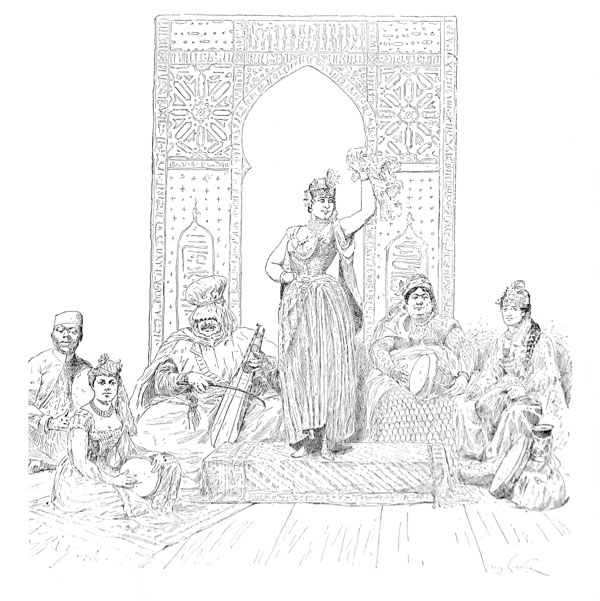
Another “Hall of Mystery” worth visiting is the “House [p073] of Metamorphosis,” Manager Stenegry, at the sign of the “Secret des Dieux.”
The real attraction of this establishment is Mdlle. Stenegry herself, a Romanische of rare beauty, who with her golden sequins and Egyptian diadem forms the most perfect “Esmeralda” that you ever dreamed of at sixteen. Inside we find a second young lady, equally lovely, a charming blonde—Mademoiselle Lutèce. She fills the rôle of Galatea, “the marble statue that acquired life beneath the burning kisses of Pygmalion.”
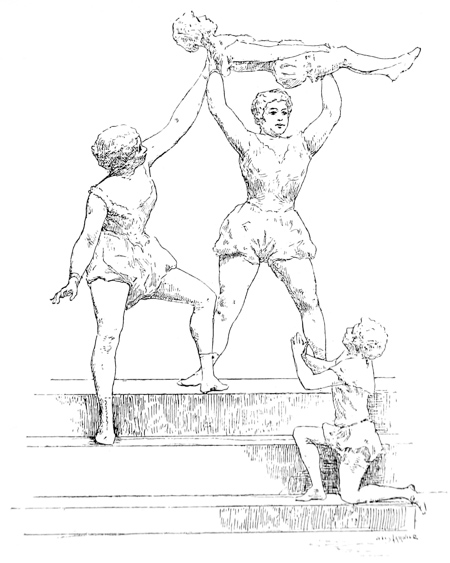
[p074] “Pygmalion” does not appear, but in a darkened room, by some device of slanting mirrors, the beautiful head of Mdlle. Lutèce changes into a death’s-head before the eyes of the spectators. Then from the youthful polished ivory skull a rose bush suddenly appears. This eminently philosophical contrast has inspired M. Stenegry, the father, with some wonderful variations of the original idea. I recommend his “Programme of visible and mysterious apparitions” to all collectors of comicalities.
“Everything pales. . ,” he says, “everything dissolves, everything blends. Come and see the chef-d’œuvre produced by my researches upon metempsychosis; it will submit its revelations and revolutions to the judgment of the spectators, who will become its sincere admirers.”
But just now the most æsthetic entertainment in the fair is the series of tableaux vivants presented to the public by M. Melchior Bonnefois.
M. Bonnefois is an artist and a literary man. Last year he published a very pathetic article in the Union Mutuelle, “Les Drames de la Vie Foraine,” and I have read some very skilful verses written by him for some of the small reviews published in the South.
This man has tastefully grouped a limited number of models, youths and girls, who are not only well trained in their profession, but also good-looking. Amongst them are Suzanne Bertini, the model from the studio of J. P. Laurens; Arabelle, the model from the Bouguereau studio; Jeanne Laurence, the model from the Baudry studio; Antonio Vega, from the Academy of Madrid; Rose Linon, one of the favourite models from the Gervex studio; Berthe Biéville, [p075] Serge Worouzof, from the Academy of Moscow; last and chief, the star of the troupe, the beautiful Mireille, from the Academy of Marseilles. This little Phocean is crowned with beautiful blue-black hair, and has the profile of Pallas Athene, with all the Olympian coldness, the absence of expression, and the gravity which distinguished the goddess.
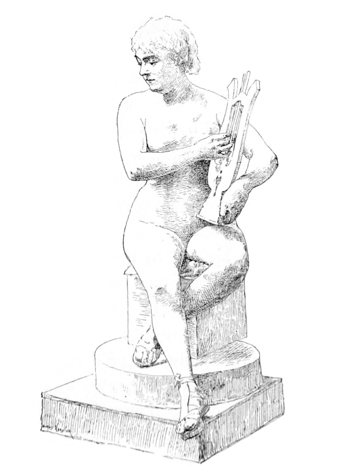
Perhaps, since it is a question of perfection, her arms, like her bust, are a little thin, but Mireille’s statuesque divinity reappears in her legs from the hips to the feet. One lady, whose views upon questions of dress are extremely accurate, and in whose society I was lucky enough to witness this [p076] artistic exhibition, made an observation upon Mdlle. Mireille’s attire which I faithfully transmit to this pretty girl and her directors—directors of conscience and others.
An error on the part of the costumier is the cause of the apparent want of harmony in the fine proportions of Mdlle. Mireille’s figure, giving undue importance to the legs. A scarf has been draped across the hips over the salmon-coloured fleshings; it is about the width of a bath-towel, and is so inartistically puffed that its whiteness destroys the harmony of the outlines, and by its vague resemblance to the short breeches worn with trunk hose, it transforms a nude into a travesty. Above the trousers of the page one looks for the shoulders of the man, and because they are missing, Mdlle. Mireille looks too thin.
What remedy can be applied to this serious error which spoils our pleasure? There is some difficulty in the matter, I know, but it has been frequently overcome with greater skill: for instance, by the artist who designed a costume for Madame Théo, as Eve before the Fall, which won the approval of all admirers of plastic beauty, without shocking the susceptible. I shall send a photograph of Madame Théo to M. Bonnefois.
It is a sad proof of our physical decadence that beauty is no longer found allied with strength; the two qualities, formerly blended like metals in an alloy, are now entirely separated, and M. Bonnefois and M. Marseille each presides over representatives of the two attributes, which, when united, produced the most perfect types of humanity. At M. Bonnefois’s establishment beauty is cultivated without strength, and at M. Marseille’s entertainment, strength is [p077] found without beauty. Yesterday I could not stifle these painful thoughts when I took my seat on the velvet benches provided by the celebrated manager of the athletic show, to watch a wrestling match.

Full of recollections of Plutarch, one remembers that in the palestrea, Lycurgus made the young girls rub themselves with oil and contend with the Spartan ephebes; the lines of Theocritus on the fight between Castor and Pollux are haunting the lips; the eyes are full of visions of the beautiful forms of the wrestlers of the tribune—the young men of Cephissodote, so beautiful that they were taken for the sons of Niobe, of whom Apollo was jealous. One enters the canvas booth, the movable temple of the heroic Hercules, with a religious shiver, and, alas! what do you see? Stout, [p078] heavy men, their hair shining with pomatum, with abnormally developed chests—this is the glorious phalange; on the other hand, amateurs without either masks or black coats, but who are nearly all in the service of the Compagnie Lasage, men who have served their time, or porters in the Great Market. No well-bred figures, no delicate limbs. Compare these bloated Vitellii to the gods? There, my good fellows, go home to your lock-picking and your work.
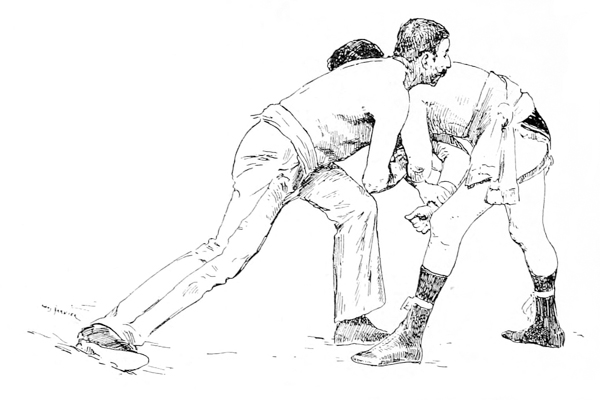
Yet I remember one tragic anecdote of wrestling. It happened at the fair at Loges about fifteen years ago. We had gone into a booth to witness a fight with single-sticks between a fencing-master’s assistant from St. Germains and the proprietor of the establishment. The soldier and the mountebank evidently knew and disliked each other; they were engaged for some time, and seemed less like holding a [p079] match than settling a quarrel; a good many people had followed the soldier into the booth.
The mountebank was completely beaten. He foamed at the mouth, rolling his eyes terribly, whilst the fencing-master, swinging himself to and fro, made his cane whistle above his head.
When the applause ended, the wrestler demanded:
“My revenge! take a belt!”
A woman intervened—a tall dark girl, a gipsy, who had juggled before us with weights and knives.
“Do not fight,” she cried to the soldier in a voice full of pain. “He is furious! he will hurt you!”
The mountebank sneered:
“Madame fears that I might break you! Are you a man?”
The soldier turned white. He was a tall lissom man, but he did not look strong. However, he quietly unbuttoned the waistcoat that he had put on, and picked up the belt.
The other waited, his arms crossed, a smile on his lips.
They grasped each other, but the struggle did not last long. The soldier was immediately thrown underneath the other; the mountebank put one knee on his neck, seized his head with both hands, and turned it completely round. We heard a crack. The soldier uttered a horrible cry—the wrestler had broken his neck like a rabbit’s back. I did not want to see any more and rushed out, whilst the crowd threw itself upon the mountebank. But in the evening an accidental turn in my walk brought me in front of the booth.
In the midst of all the gaiety, of songs, of meals in the [p080] open air, of the illuminations and noise of the shows, the wrestler’s booth, silent and closed, was the only dark spot in the fair. An indistinct form cowered on the wooden steps. I went a little nearer to it. It was the gipsy, the juggler with weights. She was sobbing bitterly, her head buried in her apron—weeping for the prisoner or for the dead.

No king nor prince did ever see
Such a tiny dwarf as she.
When a flea to bite her tried,
The feast intended she denied,
And tried to crush him; then she found
With ease he threw her to the ground.
The summer breeze, a zephyr’s sigh,
Would blow her down in passing by.
In fact, she was so slim and small
(Although in no way beautiful),
That when she stood in merry play,
Upon a tiny scale, one day—
Of brass, of copper, or of steel—
With dress and petticoat and frill,
And with her coiffure, furthermore—
The whole weighed but one louis d’or.
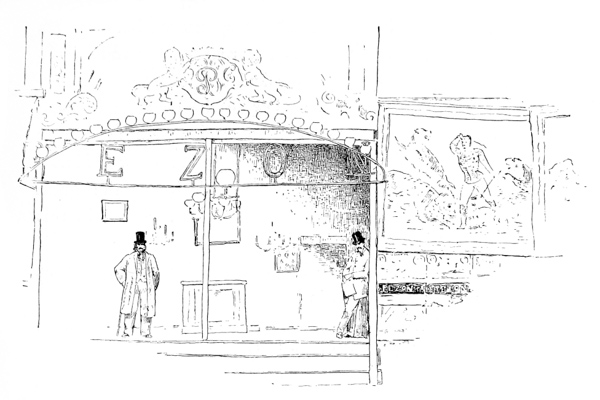
Although an open secret is now called Punch’s secret, it is certain that the marionettes’ theatre and the puppet dance are great mysteries in their way.
Very few people have ever penetrated behind the scenes of these theatres. They are far better defended than the Opera, and I am not a little proud of having been admitted one day at the Versailles Fair behind the curtain of the Bermont Theatre during the performance of a grand drama, in one act, The Spanish Brigands.
I had been attracted by a very brilliant oration from Punch, detailing all the amusements to be found within. [p082]
“This, ladies and gentlemen,” he spluttered between his teeth in the usual way, “this is the real society and family entertainment. Everything is calculated, everything is arranged, to please the eye: a review of the greatest Parisian artists, dances in character, Icarian games held in honour both by the Greeks and Romans, a Spanish bolero, Harlequin’s celebrated feats on a bicycle, and, lastly, the great unpublished drama, now performed for the first time in this town, The Brigands.”
We crowded in, about one hundred urchins, grandmothers, and nurses, eyes wide open in pleasant anticipation.
A small Italian musician, his teeth gleaming like ivory from contact with hard crusts, formed the whole orchestra. He played the accordion on the front bench. His melody ended, some one rapped three times, the performance commenced.
First, two Polish warriors entered and performed a military dance, marking the time with their heels. Then followed a couple of Spanish dancers, who executed some wonderful pirouettes and pigeons’ flights. Then appeared the india-rubber man, who stretched and stretched himself, and finally bent himself until his nose touched his heels, and then he sneezed, a performance which convulsed the spectators with delight. He was succeeded by a lawyer in a black dress, who doubled himself, became triple and quadruple—a naïve symbol of the craftiness of his profession—then played in each of the four corners of the stage with his duplicates and suddenly flew through the frieze.
The curtain falls.
From every bench a sorrowful cry is heard, “Is it over?” [p083]
No. The second part is going to begin.
Rap! rap! rap!
The curtain rises upon a second curtain, which represents a forest, a chief, two brigands, three acolytes. This is the band.

The Captain.—“My friends, I have heard from the old postillion that a post-chaise will pass through this narrow road. You must stop it.”
The Band.—“Yes, captain.”
The Captain.—“You, Pedro, must guard this defile. We, my friends, must away to the mountains.” [p084]
(The band disappears on the side to the court. Pedro remains alone for one moment. A monk enters front the garden side.)
Pedro.—“Halt there; your money or your life!”
The Monk.—“But, my brother, I am as poor as you are. Capuchins have no money.”
Pedro.—“What are those twenty-five golden louis I see in this purse? And the repeater that I see; I—”
(Pedro attempts to rob the monk. The Capuchin falls on his knees.)
The Monk.—“Mercy! If I go home without this money the superior will shut me up in a dungeon.”
Pedro.—“That’s not my business!”
The Monk.—“At least fire into the folds of my frock without wounding me, so that I can prove that I was attacked.”
Pedro.—Very well. (He fires.)
The Monk, springing upon Pedro, and stabbing him with a dagger.—“Fool! You missed me, but I shall not miss you!”
(He disappears on the court side; the captain and his band re-enter from the garden side.
They pause before the body of Pedro.)
A Brigand.—“The coward, he is asleep!”
The Captain.—“No, he is bathed in blood. The monk has killed him. Let us pillage the monastery.”
The curtain falls; the show is really over this time.
I went behind the scenes to ask the impresario Bermont for the name of the author of this fine historical drama.
“I wrote it myself,” he modestly replied. “I have a book [p085] of plays. I write them in the evenings, when they occur to me—recollections, ideas, anything. We also play The Passion, The Temptation of Saint Anthony, Hell, and Geneviève de Brabant. The book is very old, and has never been printed. We repeat it through over and over again. I also perform Camilla Underground; or, the Dangerous Forest. But once in that piece the ‘author’s rights’ found a pretext for coming in, but they did not recognize the piece; I had changed it all.”
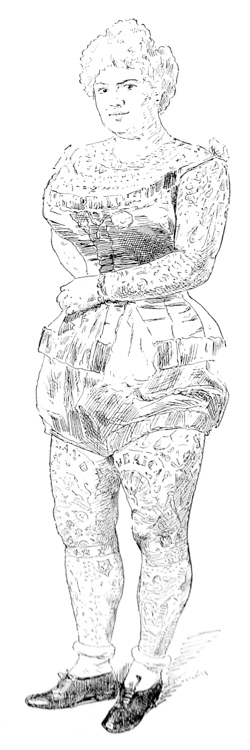
His wife stood near him whilst he spoke, leaning on his shoulder, tenderly proud of belonging to a man gifted with so much imagination.
If you should ever have an opportunity of examining the large volumes in which the Brothers Parfaict, the Des Beulmiers, de [p086] Monnet, and some other authors have scientifically discussed the origin of fair theatres, you will find that they have been always forced to contend against that hereditary enemy which the impresario Bermont now calls the “author’s rights,” and which has borne different names in different ages.
At the epoch when the fair theatres first attracted notice, that is to say about 1595, it might have been justly styled the “comedians’ rights.” The brotherhood of the Passion and the actors of the Hôtel de Bourgogne would not allow any extension of theatrical performances by their side, and as they held the power they easily obtained a rule which restricted the comedies in a fair to wooden actors, marionettes of Brioché, learned animals, acrobats, and juggling tricks.
But the banquistes are a tenacious race, and towards 1678, in spite of the opposition from the comedians, the fair theatres commenced to mount a few well-seasoned farces with actors of flesh and blood. The head of the police protested, and the managers once more pretended to restrict themselves within the limits of the law, resorting to some ingenious infraction of the spirit of it, which provoked laughter and put the comedians in the wrong; for instance, the artifice used by La Grille, who opened, in the fair of Saint Germaine, an Opera de Bamboche, in which the sole actor was a huge marionette, that gesticulated to the melodies of an invisible musician concealed in the prompter’s box.
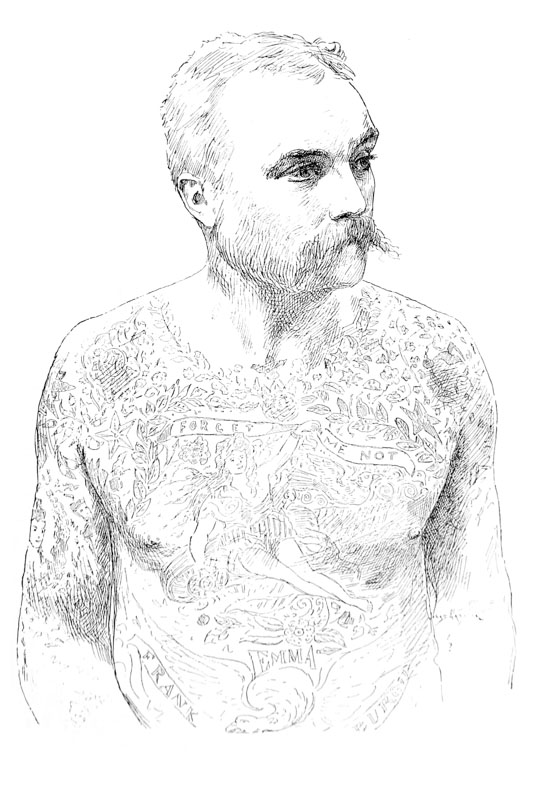
At the same time the companies of Allard, Maurice and Bertrand, Selle, Dominique and Octave, obtained great success in Paris and the provinces. Conjuring tricks and [p088] feats of agility still formed the chief part of the entertainment, but to them were added scenes with dialogue, comedies in song, from which our comic operas have developed.
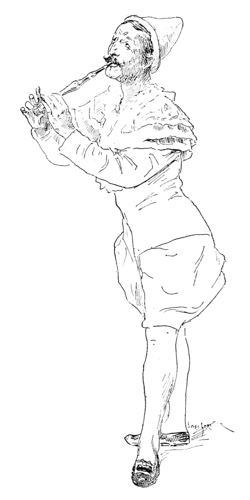
The forain stage has retained the triple characteristics—acrobatic, musical, and charlatan—which appear to have belonged to it from the earliest days of its existence; but since the century in its refinement values distinction of style, the grande banque has adapted itself to its requirements.

There are three kinds of theatre booths:
Singing theatres.
Theatres with good variety performances.
Theatres with conjuring entertainments.
The theatres with operetta are the least amusing. No original work has been produced in them for a long time, not even any new songs. At the present moment the café concerts provide the majority of the tedious repetitions which make the tour of France. The forain opera lives by spurious imitations and clumsy changes of title. All its skill is expended in successfully defying the aforesaid “author’s rights.” It succeeds to its own satisfaction when it advertises the
CLOCHES DE GORNEVILLE
with a large G. Its inventive power is limited to the substitution of this one letter. And the individuals who appear upon the stages of the booths to sing the “trial d’operette” are also the refuse of the café concerts. They can only impose upon an unsophisticated audience. For this reason the forain opera is no longer found in the suburban fairs of Paris or other large cities. It is confined to country fairs and provincial festivities.
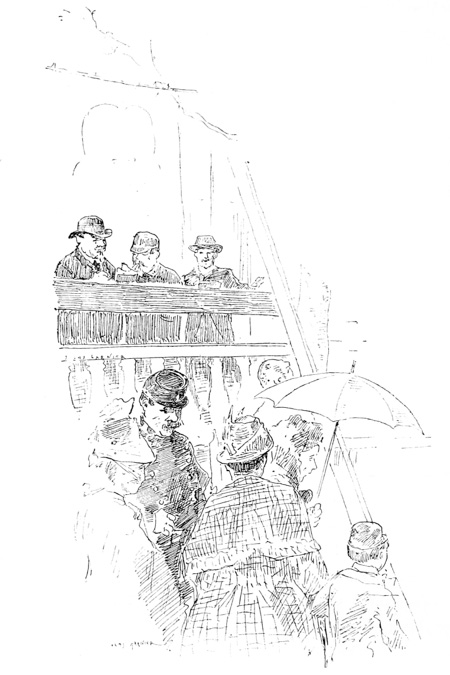
But the variety houses are on quite a different scale. The most flourishing and the best known at the present time are the establishments kept by Marquette and Emile Cocherie, who styles himself on his programmes, “Head of the fêtes of Paris.” At the commencement of each campaign, that is to say before the Fair du Trône, Emile Cocherie gives an audience in his villa at the Porte de Montrouge to all the [p090] artists who aspire to enter his troupe. In his presence the candidates must all jouent le canevas, i.e. improvise a scene with dialogue upon a given subject. The same old themes are used which have served ever since the origin of the open-air [p091] stage; all the situations of the Italian comedies and Gallic farces which amused the crowd even in the time of the escholiers. A new topic is not prohibited, but there are very few “patterers” who can speak outside as well as inside, as the terms of the engagements run.
Still clever actors who can improve the performance receive extra salaries. The illustrious Clam, who is called the last of the merry-andrews, earned as much as five hundred francs a month at the forain theatres. I asked M. Cocherie, who was left inconsolable by the departure of this whimsical performer, why he did not try to replace him by some young student of comedy who had passed creditably through the Conservatoire.
“He would not suit me,” replied the experienced manager. “I have tried them, and still have one in my show, but he does not succeed. The lads have not effective voices, they are not merry and, above all, they have no gift for improvisation. A commercial traveller who can push a sale well, a hawker from the street, would be much more in my line than M. Coquelin aîné.”
And it is quite true, this Clam is a splendid clown. I do not recommend you to make his acquaintance in the Clamiana, a collection of jokes which seem very dull when they are read, printed with old type in a small newspaper. Clam should be heard outside the show in the tumult of smacks and kicks which accompanies his improvised dialogue with his butt.
I begged this important personage to give me a few notes on his life, and I now publish them as they were given to me. The last of the red-tails belongs to literary history. [p092]
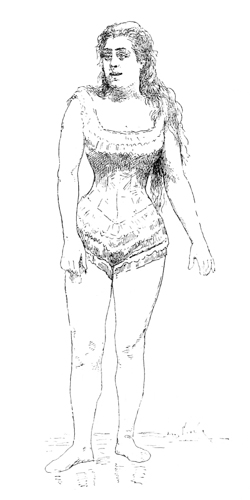
“At noon, on the 5th June, 1837, a baby uttered its first cry. The son of the actor Chanet entered the world in the native place of Casimir Delavigne! Brought up in more than poverty and naturally delicate, my childhood was passed in an asylum at Havre, about the time of the great cholera epidemic, which spared my life; later on, I sold [p093] checks at the theatre door, and considered myself lucky if I occasionally managed to see one act.
“My only recreation was reading plays and acting them in a footwarmer by means of little dolls. I was the most ignorant of the Brothers’ class. In spite of all I became errand boy and lithographer.
“In 1853 I made my début as a comic singer in the Théâtre des Familles, established in an old prison.
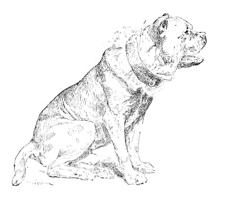
“Some time afterwards I tired of shining in the carnaval fêtes of the period and returned to Havre as a chorus-singer, under the direction of M. Defossez.
“I sang in choruses and made floats. Some years later I returned to the same theatre and gave some performances.
“But in spite of this success Paris has seen me almost barefooted, ill, and homeless; my food gathered from the scraps found under the umbrellas round the Fontaine des Innocents. My mother was poor and could not help me, and for my own part I would not tell her of my distress, wishing to spare her tears. By dint of struggles and of [p094] work I distinguished myself as an actor at Nancy, Limoges, Bordeaux, Toulouse, Havre, Rouen, Besançon, Geneva, Nantes, Paris, &c.
“I have acted with Henry Monnier, my master, Scrivaneck, Vieuxtemps, Hoffman, Darcier, and Renard. Circumstances have forced me to give performances in every description of city and small town. I have played in stables and theatres, in barns, and in the Rothschilds’ drawing-rooms; I have travelled on foot, by railway, and in carts. I journeyed through one part of France with some acrobats, with whom I saw it through many colours and on the road I collected some instructive and still unpublished notes, of which I am the sole owner.
“My travelling diaries are all my fortune. Afterwards I went to the café concert with the remnant of my voice, and was successively engaged in various large cities. I know some parts of Holland and Germany, a little of Switzerland and Prussia, a great deal of Belgium, and something of Italy and Spain. But I know Bohemia best of all.
“Like the late Bilboquet, I have tampered with every banque except the Banque de France, but this does not prevent me from living a quiet, unobtrusive life; my only wish is that no one should annoy me (this is very difficult to get), to live a long time and to die without pain.
“I add for the edification of the reader that my sons bear my name, an item which my father forgot to bestow upon me (he was so heedless).”
Clam, who—as you may judge from this narrative—has some claim to be noticed in any complete anthology of [p095] French writers in prose, has “teased the muse” at times. But his poems echo the prevailing note of his century—they are cynical and melancholy. You may judge by these three verses on the death of a comrade in the show. Clam dedicated them to me:
“Elle est morte, la cabotine,
Sans avoir essuyé son blanc,
A la bouche une cavatine,
Son bouquet de fleurs sur le flanc.
Dans sa “caravane,” on la garde
Entre un cierge et des litres bus;
Sa mère l’habille et la farde
Comme elle a fait pour ses débuts.
Elle attend qu’on lève la trappe
Et qu’on frappe au rideau trois coups,
Elle attend . . . Hélas! on les frappe,
Mais c’est sur des têtes de clous.”4
A man who has so many strings to his bow is not anxious about the future. One day when I hinted before Clam that old age might surprise him, without any provision for it, he replied:
“When I am no good for anything else my friends will [p096] make a politician of me. But I have still some chest left, and I shall put off the death of the show for many years yet.”
The improvements, the tricks of every kind which have destroyed the “outside shows,” have enriched the entertainments given inside the booths, and have most successfully transformed the conjuring performances like those found in the establishments of Adrian Delille and Pietro Gallici.
Since Delille bought the theatre and tricks of Laroche he is the king of showmen conjurers. He is third representative of the name. The first Adrian, the grandfather, was conjurer to King Charles X., and, since that remote date, at every fair held in Paris or any large town, a magician bearing the name of Delille has been seen making omelettes in hats, juggling with balls, &c., without the aid of pointed hat, long sleeves, wand, or cabalistic words—a modern sorcerer in evening dress and lavender kid gloves. The Delilles first introduced the trick of the Speaking Head into France. They bought the patent for 4,000 francs, never hesitated to bring a lawsuit against any one who infringed it, and always won their case.
The science of white magic has made great progress since that date. There are always some means of improving an old trick, and every year Adrian Delille spends his six months of enforced rest in preparing for the summer season.
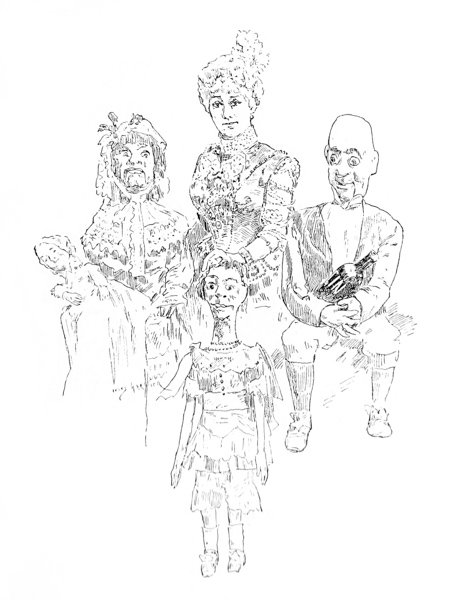
Like all his comrades, he disbands his troupe in the month of November, and takes up his winter quarters in Paris, where he has a study devoted to experiments. He must [p097] be ready to renew the campaign at Easter, to astonish the Parisians at the Fair du Trône. In his youth the conjurer worked almost alone, and for hours he would keep the public breathless with interest and wonder. For this he required great facility of speech, a mind always on the alert, and the [p098] skill to draw the eyes of the spectators in any direction he wished away from his secret manipulations. Conjuring implies a constant struggle against the malicious curiosity of the audience. “I am not strong enough now,” Delille observed to me, “to bear the strain during a succession of tricks; I was obliged to divide the performance. Besides, now, the public like that best.”
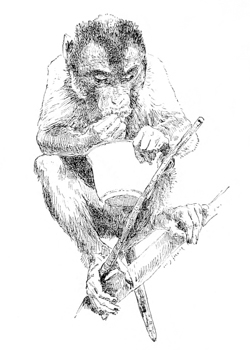
The troupe consists of forty persons. It is a little difficult to realize the size of the establishment required to work these large show-theatres. A booth like that of Adrian Delille can seat 1,200 people, and it is always crowded for the Sunday performances. They cost an average of 400 francs [p100] per diem, for the principal performers receive high salaries. Clowns, acrobats, buffoons, and equilibrists, all these artists—and they are the same who appear in the hippodrome and circuses—are engaged through the agencies. The engagements are concluded for one month, but they can be cancelled at the end of a week at the wish of the proprietor.
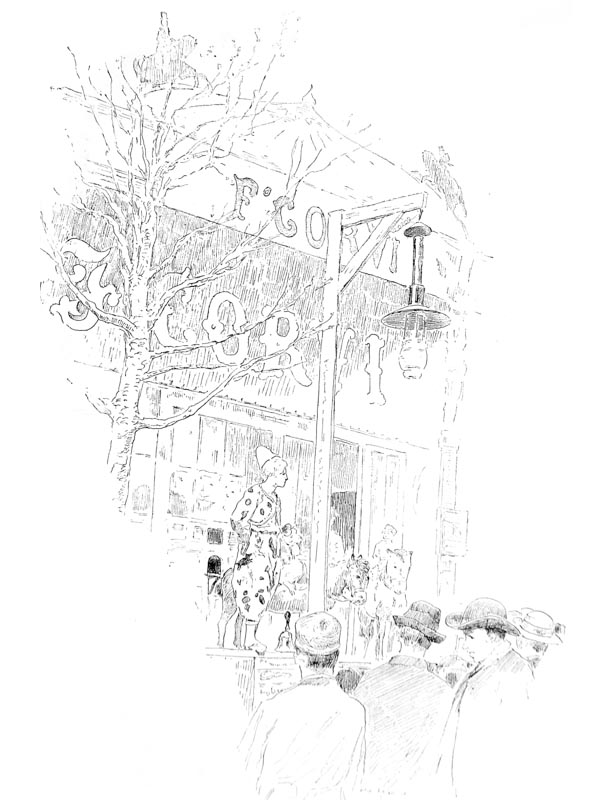
A good clown, a skilful gymnast, can earn in a forain theatre like that of Delille as much as at the circus—about 2,000 francs per month.
The dancers employed to pose in the tableaux vivants are paid according to their beauty and skill—180, 240, or even 500 francs per month.
Delille paid a still higher sum to the two pretty girls who lately posed for him as the two little combatants in Emile Bayard’s picture An Affair of Honour.
It would be quite as indiscreet to ask a conjurer to explain his tricks, as a pretty woman to tell you what scent she uses for her toilet, and therefore I have never discussed the subject. The exclusive ownership of a conjuring trick is difficult to defend in law, and for this reason prestidigitators are always on their guard against the indiscretion of their workpeople. They have been betrayed a hundred times for a bottle of wine and a few banknotes, and now, taught by misfortune, they surround their experiments with as much mystery as the old Egyptian priests used in their worship of the veiled Isis. After all, our pleasure lies in this mystery only. “These phantasmagorias,” it has been well said by one of our contemporaries, whom a taste for philosophic acrobatics has led to esteem acrobats in [p101] fleshings,—“these phantasmagorias please us like every other phenomena which seems to contradict the universal order of things, to counteract the laws of nature. The universe being what it is, we have no other consolation than the dream that it is otherwise, and this is the true essence of poetry. Conjuring is lyrical poetry—fable in action.”5

The time has passed when conjurers were forced to ascend a woodpile and worthy folk clung to the honour of bringing a faggot to roast them with. Every one knows that there is nothing supernatural in the illusions they create. Usually the explanation is one of the most simple things in the world, but our search for it is nearly always unsuccessful, yet whilst we persevere in it we cannot be bored, and this is really the only aim in view.
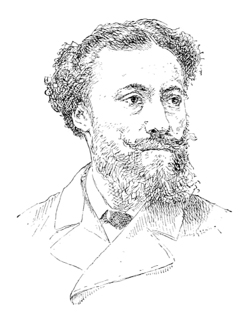
There is one conjurer more modern than Delille, more ingenious than Robert Houdin, who has carried the art of white magic to a state of perfection unknown before. This is M. de Kolta.
This extraordinary man takes a sheet of paper, rolls it up like a cornucopia, and from this horn of plenty he immediately pours an avalanche of roses into a crystal cup. [p103]
The spectator is bewildered.
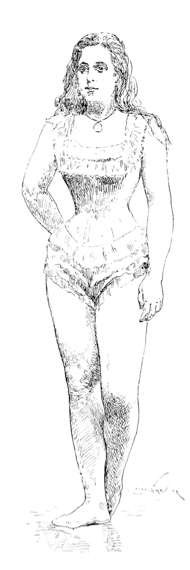
“Where do these roses come from?” he asks. Apparently they had been in some way concealed in the waistcoat of the thaumaturgist; but how did they get into the horn? what pushed them? what secret spring made them flow forth? [p104]
We must own that no one knows.
M. de Kolta then removes his coat and takes a cage containing a live bird into his hands. One, two, three!
The cage and the bird are gone; nothing is left! The clever ones will gravely tell you that the cage was jointed; by pressing some secret spring it unjoints, closes or elongates itself. Most probably it assumes the shape of a narrow cylinder, in the midst of which the bird is imprisoned but not hurt.
That is all very well, but what becomes of the cylinder? The magician has no accomplice; he performs the trick alone, before the eyes of the public. It seems impossible that any movement could escape that watchful gaze.
Lastly, M. de Kolta is not satisfied with making a bird disappear, he causes a woman to vanish—his wife, so they say; and although he chose one so frail, so tiny, so nearly related to the elves, that she looks as though she might run across a meadow without bending a blade of grass, still she is a woman of flesh and blood, who could not be forced into the sheath of a sword.
M. de Kolta, who is cleverer than you are, spreads a newspaper upon the floor and places a chair on the paper. Madame de Kolta seats herself upon the chair, and her husband covers the little parcel of lace with a red and black veil; then rapidly takes the veil off again.
The woman has gone!
Evidently the woman disappeared through a trap; but yet, whilst she went through it, the veil never moved, and the newspaper is still intact, though it is much larger than the [p105] edges of the veil. We feel humiliated at being the victims of such an illusion, although we were forewarned. And we ask ourselves with some alarm, what is, then, the value of the feeble organs of knowledge we call our senses, in which we so blindly place our trust?
But through this uneasiness, this distrust of our judgment, which conjuring leaves, this entertainment becomes an excellent school of wisdom. You may believe M. Jules Lemaître on this point, for he first discovered the philosophical side of these performances. “M. de Kolta,” he said, “should be a happy man. He is a true sorcerer. He forces us to see with our eyes things which we cannot see, and not to see things which we do see, and this is solely through the marvellous skill of his agile fingers. In his place, I would go to the mysterious and credulous East, where I would found a new religion based upon miracles. M. Renan would provide a dogma suited to the requirements of those far-distant souls, and M. de Kolta would work the miracles. He would be a prophet during his life, a saint, perhaps a god, after his death. . . . But one sorrowful reflection tempers the pleasure which this idea gives me. The miracles worked by M. de Kolta are practically injurious. Since we do not believe in the false miracles he performs—since nothing distinguishes them from real ones, and we have only the magician’s word to assure us they are false, what, then, should we do if real miracles were worked in our presence? We should say, We know all about them; it’s only conjuring! And thus the small remnant of faith which we may still retain in the supernatural is insidiously destroyed. [p106] When the prophet Elijah returns to earth at the end of time he will meet other De Koltas here; he will himself be sent to the Eden or to the Folies Bergères. And that is how the last men will lose their souls—just like the first, however.”
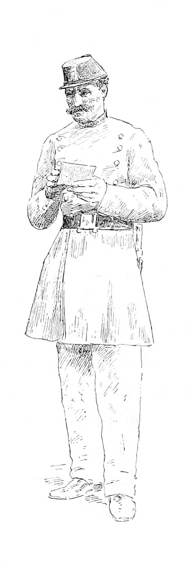
“She is dead, the mummer gay,
With the powder on her face,
On her lips a merry lay,
Flowers nestling in her lace.
In her “caravan” she lies
Twixt empty bottles and wax lights,
Her mother decks her, rouge applies,
As though it were for her ‘first nights.’
She waits, until they raise the trap,
Three knocks, the rising curtain hails,
She waits . . . alas! I hear them tap,
But ’tis upon the heads of nails.”
[5] Jules Lemaître, Impressions de Théâtre, Second Series.
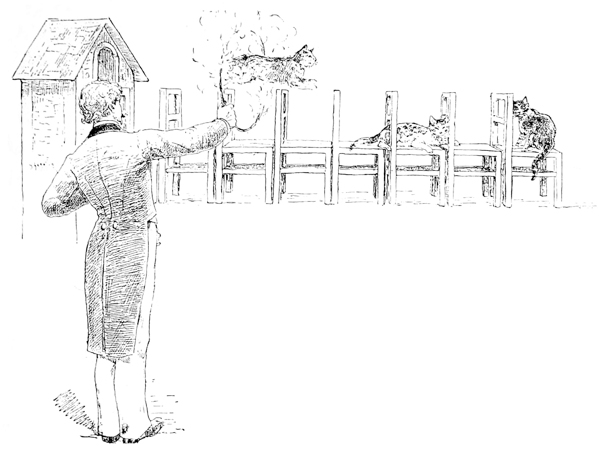
It is difficult to see how man would have fared if he had not compelled the animals to serve him. The science of animal-training must therefore date back to the earliest stages of the world’s history; and we may believe that artistic training is almost as old. The dwellers in caves had not yet invented the game of fox and geese, and they must have found some difficulty in amusing themselves in the long winter evenings; they therefore probably taught their dumb companions the art of leaping and showing off.
Now that animal-training has become a lucrative profession, competition has forced the trainers to rival each other, and their skill has obtained wonderful results. All the inmates of Noah’s Ark have passed under the whip, from minute insects to Jumbo himself. Men have tamed serpents, birds, cats, dogs, goats, monkeys, seals, and pigs. In their desire to grasp and conquer increasing difficulties, they have even [p108] taken the fleas from the animals they were training, have bridled the fleas themselves, and taught them to draw a carriage. Do you remember Virgil’s lines upon a stallion for the first time subject to the yoke? The poet dwells with rapture upon the vigorous bounds which wrench the plough from the furrows. What would he have said of the spring of a flea, which, at liberty, jumps one hundred and forty times its own height?
If you wish to know all the mysteries of animal-training, an art based upon definite rules which vary very little in their application to the instincts of the different pupils, I recommend you to read a book which will surprise you. It was written by Professor G. J. Romanes, secretary of the London Zoological Linnean Society, and has been translated into French for the “International Scientific Library.” It is called the Intelligence of Animals. You need only glance at the first volume, which refers to the intelligence of molluscs, ants, termites, white ants, spiders, scorpions, and the lower articulated animals. But you should carefully study the chapters in the second volume devoted to birds, the cat, dog, baboons, and elephant. I fancy that if any of you are partisans of the Cartesian doctrine, and hitherto only regarded animals as clocks with better regulated machinery than our own, you will leave off reading considerably shaken in your assurance.
The saltimbanque, who is not a creator of systems à priori, but whose philosophy is purely experimental, has, for a long time, observed the regularity with which animals follow the same habits. Upon this observation he has based his method of training them. [p109]
Whatever the animal may be which he wishes to train, he commences by watching it closely, endeavouring to discover not only the usual habits of the race, but the personal disposition of the individual in question. One specimen raises itself naturally upon its hind legs, another is born with a talent for jumping. . . . And this axiom prevails in every case under training: “Animals are never forced to execute, at the command and will of others, any movements which are not natural to them in a free state.” Monkeys love to swing in the tropical creepers: they are placed on a trapèze; a goat seeks for pointed rocks—he is a natural equilibrist: so he is taught to balance himself on the neck of a bottle; a dog instinctively rises on his hind legs to seize a morsel of sugar held out to him. He must learn to maintain himself in the same position.

[p110]
Guided by these remarks, a trainer enters upon his task. He will attain his end if he judiciously uses the triple forces of fear, greediness, and habit.
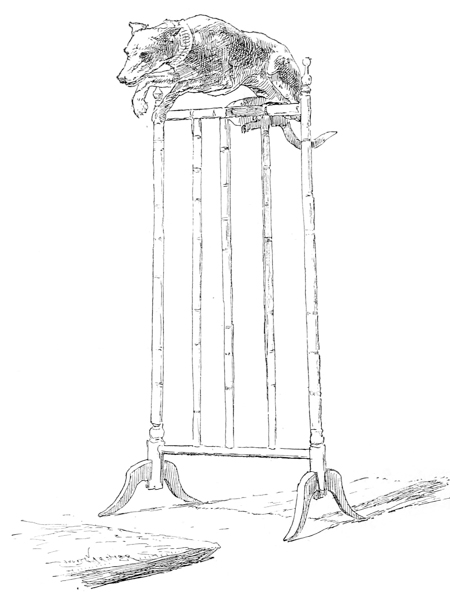
The first time that you make a dog stand on its hind legs you have to contend with the indolence which makes the animal wish to revert to its usual position. Practise the [p111] lesson every day, and each time reward the pupil with a lump of sugar. An association of ideas will be soon formed in the dog’s mind: the disagreeable sensation of walking on its hind legs will be inseparably linked in its memory with the pleasure of crunching sugar. And since the frequent repetition of the same movement lessens the fatigue of maintaining a vertical position, the dog will at last willingly perform the feat which it at first disliked. On the other hand, it must be remembered that the whip is always ready to punish any obstinacy or awkwardness, and you will readily understand that a poodle, finding itself in the dilemma of either walking upon its hind legs and receiving a dainty, or of not walking and receiving a blow, at once chooses the polka.
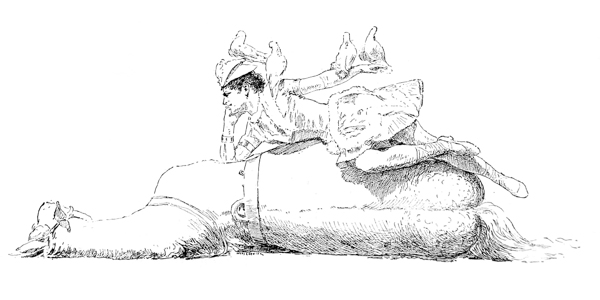
And here, in its simplicity, lies the whole secret of training animals. Patience and regularity from the man, habit and greediness in the animal. There is no other talisman. You have all seen a pigeon-charmer on foot or on horseback; it is [p112] one of the prettiest performances exhibited. A young woman is carried round the arena at full gallop by her steed; she raises herself or crouches down in graceful attitudes which show off the suppleness of her figure. Behind her, like a mantle streaming in the wind, the white flight of pigeons follows her movements. They alight on the arms, neck, and shoulders of their mistress, who recalls one of the young priestesses in the groves of Gnide, offering her rosy lips and soft white throat to the caresses of her doves.
Now would you like to know the secret of her charm? It is explained in an amusing vaudeville of the old style—Le Sourd, ou l’Auberge pleine.
“Would you like,” one of the characters in this farce remarks to his companion, “Would you like me to tell you an infallible method of catching birds? Well then, listen! You must strew some corn on your window-sill—the little birds will come and eat it. Put it there a second time—the little birds will come again. On the eighth day you need not put any. The birds will come open mouthed . . . and they will be caught.”
This is the whole secret of the pigeon-charmer. For seven days she strewed corn in the folds of her mantle. The eighth day the pigeons were charmed.
This is an almost mechanical movement; the certainty of success arises from the strength of instinct and the weakness of intelligence.
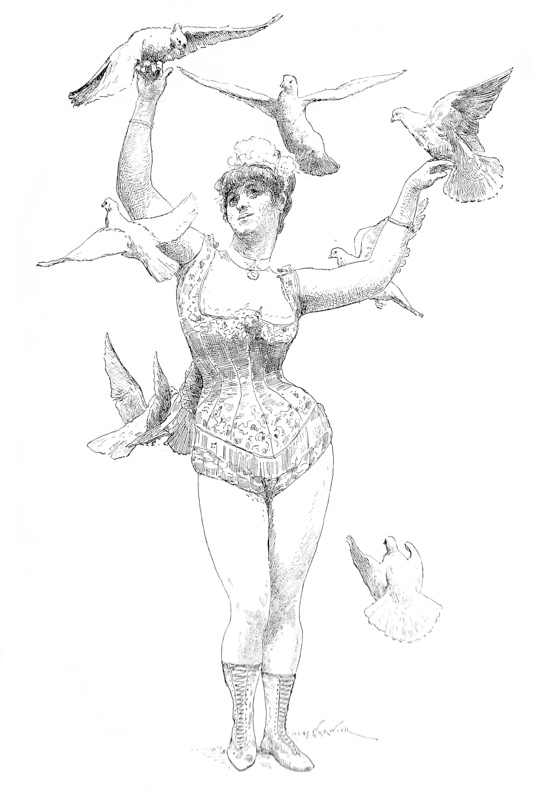
With superior animals like the dog, the chances of failure are much more numerous; but the same individual intelligence which renders obedience more doubtful, authorizes the trainer to exact an effort that surpasses intelligence from [p113] those picked performers which he selects from amongst the pack. And Munito, who played dominoes with his master, seems to have as much chance of being remembered by posterity as Archimedes the Syracusian. One of his companions, an unlucky mongrel, born in a gutter, caused all Paris to throng to the Folies Bergères last year. Amongst his compeers he had created the rôle of the clown Auguste.

This clever dog-clown would reach the springing-board at a gallop, then stop short before the bar, pass under the chairs when the hoop was held out to him, feign a sound and sonorous sleep when he was told to perform. But all this was only shamming, intended to evoke laughter from the audience. Suddenly the Merry-Andrew would free himself from his collar, bound upon the board, and cleave the air [p114] with such a wonderful spring that the greyhounds refused to follow him, and it was necessary to catch him on a mattress to prevent him from breaking his paws. Some months later he broke his back in London in a still more dangerous performance. The best doctors were sent for, but nothing could be done; he died after a short struggle of sobs and howls. I met his master some months afterwards, and spoke to him about his loss. He still wept when he mentioned the poor clown, whom he had cherished with human friendship. I listened to all his regrets, and his words reawakened a sympathetic pang in my own heart.
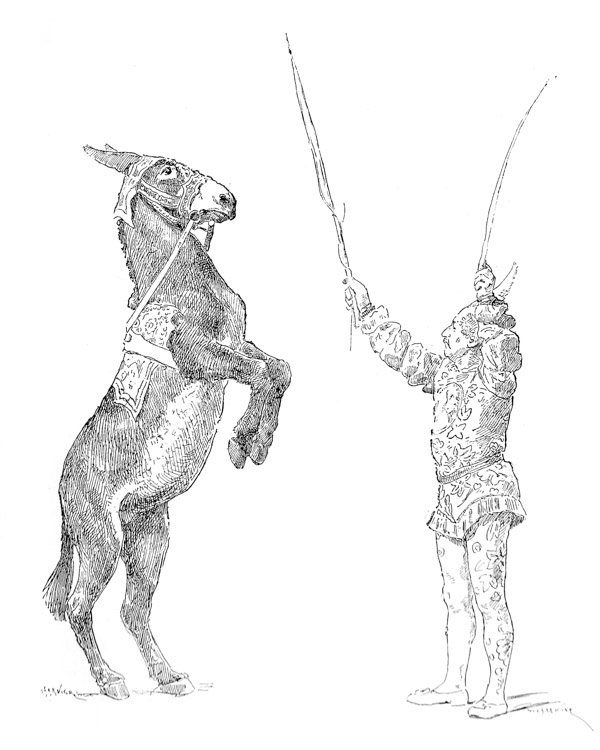
My lost favourite—a black poodle—was called Miette. She was not clever, for she never even learnt to stand on her hind legs, but we loved each other. At that time I lived on the banks of the Marne, between Nogent and Joinville-le-Pont, a terribly deserted and solitary district in winter. If Miette found that I did not return home by the last train, she would break her chain and go and wait for me near Reuilly, in the moats of Vincennes. She wished to escort me through the woods, which, she felt, were by night full of possible attacks and hidden peril. One day she was bitten by a mad dog. I did not suspect the nature of the illness that followed, and endeavoured to open her mouth and give her some medicine. She looked at me with mad, supplicating eyes, seeming to say, “Leave me, my master, I do not want to bite you.” When I knew what was the matter, I would not leave the task of killing her to a veterinary surgeon, who might have done it awkwardly perhaps. I led her into a thicket in that forest of Vincennes which we had so frequently crossed together on fine, silent, [p115] frosty nights, lighted only by the brilliance of the stars. My heart ached with the agony of a man about to commit a crime, who has led his friend into the corner of a wood [p116] intending to perpetrate a cowardly murder. But it was necessary that she should die. I made her lie down, put my revolver to her ear, and fired.
Oh, my poor Miette! the long reproachful look you gave me ere your eyes closed for ever—your loving, childlike eyes! I dug a hole and gently laid you in the grave. I took off your collar—it still lies in the drawer of my writing-table, my hand often touches it when I turn over the confusion of papers. The little curb rings like halfpence in a purse. And then I fancy that my poor Miette is moving round me; that I hear her clumsy gallop on the wooden staircase; that in a moment she will be scratching at the door.
Is there a better world, a paradise for these faithful servants of mankind? I dare not assert that I believe so, and yet, in Dauphiné, I once knew a dog who certainly cherished the hope of it. He was a small curious-looking yellow mastiff, a dog of a divine race which the Emperor of China had given as a choice present to a French diplomat. He resembled a beast in heraldry, or one of those strange monsters that we see writhing and baying on painted vases and reliefs in bronze. Transported into France, the Chinese had crossed with every breed of dogs for ten leagues round, and had created a race of fantastic-looking animals which showed the curious type of the father blended with every variation of the canine form. Towards the end of his life, when I made his acquaintance, he had become a dreamer. He spent whole days with his head resting upon his paws, his eyes fixed, lost in his recollections. One autumn evening we went out upon a terrace to enjoy the brilliant night; we found him immovable upon a flagstone; his head was raised [p117] towards the sky, his eyes, shining like carbuncles, seemed to pierce the heavens, gazing upon a definite point beyond. His master was puzzled, and called him three times:
“Kiang! Kiang! Kiang!”
But he remained motionless, like a bronze chimera, soaring far above us in his ecstasy.
On the morrow he was found dead in his kennel.

I have often thought since that he had some presentiment of his approaching death, and that he heard the distant baying of Sirius’s hounds—of those dogs, sons of heaven, who hunt the Bear, and through all eternity assuage their divine thirst in the fountains of the Milky Way.
Although the grimaces of the monkey may be amusing, the dog’s capacity for affection has won a higher place in my esteem. I am wrong; for if a poodle be very near to us by its heart and its delicacy of feeling, a monkey is more closely akin to humanity through its gestures and form. Darwin has written very cleverly on this subject. A baby of four years old, whom I took to the Corvi Theatre the other day, [p118] and who had not read Darwin, cried out, when the dishonest cook appeared:
“Look! it’s a little negro!”
You all know the popular performance of The Roman Orgie by Couture. Behind a table well provided with biscuits and nuts, a company of baboons, ourang-outangs, and brown monks is seated. They are dressed like Peruvian generals, and each has a napkin tucked into his collar. A poor little monkey, tricked out in a town-crier’s old clothes, with a white cap and apron, waits upon his comrades, gambolling round the table. In his right hand he holds a lighted candle; in the left a basket, which he dances by its handle. Ah! yes, that head cook! he dances it by the handle morally and materially.6 You see, he is weighing his provisions on the sly, and seizing a mouthful whenever M. Corvi is not looking.
The same entertainment has gone on ever since our childhood, and since the infancy of your father and grandfather. And, as it would be difficult to believe that the head cook is a sexagenarian, we must conclude that a whole generation of actors have worn the apron and carried the candle without our remarking any change.
To satisfy myself on this point, I questioned M. Corvi himself on the subject.
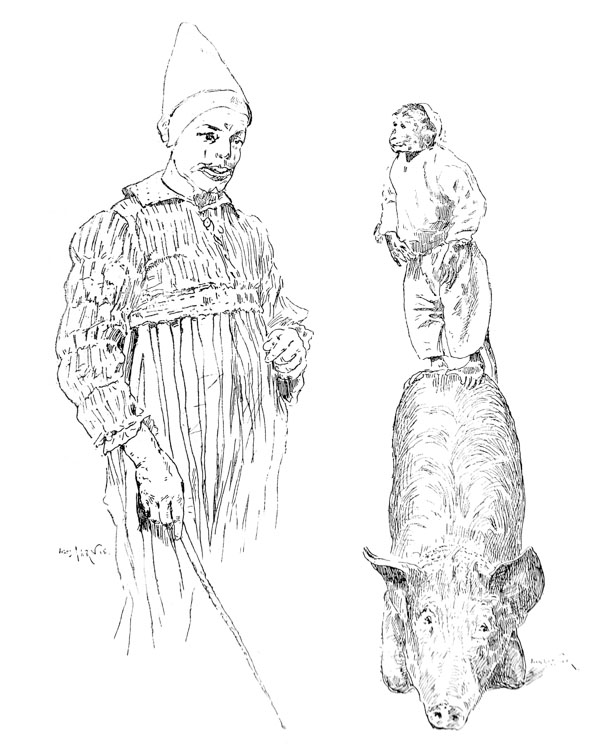
“My show,” he kindly answered, “is really a permanent entertainment. As it entirely consists of scenes in which goats, monkeys, poodles, and ponies are the sole actors, I keep a reserve staff, behind the scenes, of understudies of [p119] every part. In the pantomime called The Deserter, you will no longer find one single artist belonging to the original caste. I have already replaced the judge, the gendarmes, the [p120] prisoner, and the gravediggers, just as consumption or gout made vacancies in my troupe. The actors pass, the play remains. No one here is absolutely necessary. If I lost my first leading gentleman to-morrow—he is a baboon named Coquelin aîné—the play would not be interrupted for one single day. We should replace him by his understudy—she is called Coquelin cadet—and neither the nurses nor the babies, who are our subscribers for Tuesdays, would ever discover the change of performer.”
M. Corvi is one of the last representatives of the old-fashioned trainers, who wore evening dress or a frock-coat, like M. Loyal, when they exhibited their pupils in the arena. Modern trainers prefer a clown’s dress, and their intentionally grotesque appearance is very effective when accompanied by ridiculous animals like the pig and the donkey.
The terrible Onos, compared by Homer to the divine Ajax, the ass himself, is now drawn by the ears into the arena by a clown. Perhaps you already know that the male ass is a dangerous animal. He may be chosen from a small race, but his bite will still be formidable, and therefore the halter, which only seems to decorate his head, is really a strong muzzle, and his hoofs are never shod. In spite of these precautions the clown must be very agile to evade the kicks showered full at his chest, and must be careful not to miss his spring over the bench when Master Aliboron charges at him across the arena like a bull rushing at a picador.
The appearance even of the pig has the power of delighting the crowd, and who can resist laughing when the clown approaches his pupil and shouts:
“Come here, pig!” [p121]
“Eh?” asks M. Loyal.
“I’m not talking to you.”
Although the training of the pig may still seem imperfect, the education of this animal requires extreme patience from its teacher. An Irish proverb quoted to me by Billy Hayden says: “Beat your wife with a cudgel and your pig with a straw.” And, truly, the pig’s bristling skin is so sensitive that the least touch of the whip covers it with blisters, and disgusts the animal with all work for ever. Only coaxing and kindness must be used.
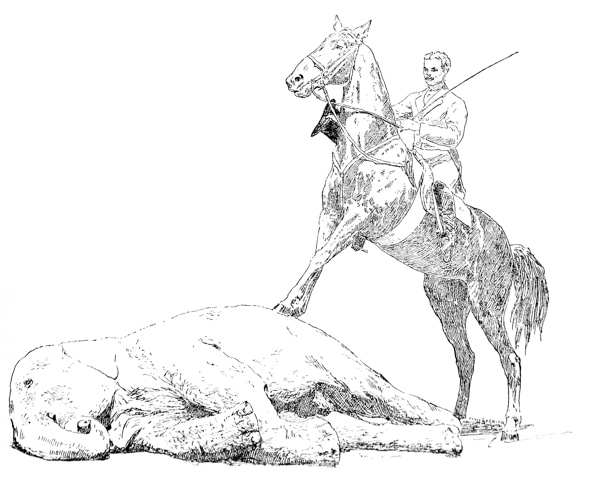
The elephant is, perhaps, the only beast yet stricter than the pig in regard to politeness. [p122]
This animal, which the trainer Corradini at the Hippodrome, and the brothers Lockhart in most places have exhibited with so much success, possesses all the passions and all the feelings of man.
I quite agree with you that some of the stories quoted to us about elephants require confirmation, and I always feel some distrust in reading the anecdote, related by Plutarch (De Solert. Anim. cap. xii.), of an elephant which had been punished for dancing badly, and was afterwards discovered practising its steps alone in the moonlight.
But there is scientific evidence of the magnanimity of the elephant, of its deep sense of duty and self-respect.
Griffiths, whose good faith cannot be doubted, quotes one very characteristic incident proving this self-respect. At the siege of Bhurtpore, after the English had been encamped for some time before the walls of the city, the dry winds set in and soon evaporated all the water in the reserved ponds; this led to great competition round the last well which contained any. One day two drivers were at the edge of the well with their elephants; one of the beasts, which was of remarkable size, seeing its companion use a pail to draw up the water, forcibly wrenched it away. Whilst the two keepers were joking, the victim, though conscious of the injury, restrained its resentment. But when the thief bent over the edge of the well to reach the water, the smaller elephant made a terrible spring, and throwing itself with lowered head upon its enemy, sent it rolling into the cistern.

This pride, when once overcome, is of great assistance to the trainer, but it sometimes produces a tragedy. When elephants are tamed, the presence of the monitor elephants [p123] can usually be dispensed with at the end of two months, and the prisoner is afterwards ridden by its keeper. At the end of three or four months it is sufficiently docile to work, but there is some danger in subjecting it to this ordeal too abruptly, for it frequently happens that an adult and perfectly [p124] healthy elephant will lie down and die after it has worn harness for the first time. The natives then say that it died of a broken heart; in any case, the death is not caused by either illness or wounds. (Sir E. Tennent, loc. cit. p. 216.)
I have also found, amongst the Memoirs of the actor, Charles Young, published by his son, the Rev. Julius Young, an anecdote which well illustrates the sagacity and affectionate sensibility of these huge pachyderms.
The newspapers had announced the arrival in England of the largest elephant that had ever been seen. Henry Harris, the manager of Covent Garden Theatre, at once purchased Chung—that was the animal’s name—for exhibition in a pantomime entitled Harlequin, which he had mounted very expensively. Harris paid 900 guineas for the beast. Mrs. Henry Johnston was to ride it, and Miss Parker was to act as columbine. But at the general rehearsal, when Chung reached a bridge over a cascade which he was expected to cross, he refused to step upon it, distrusting its solidity, and not without reason. In vain the angry keeper punished him by pricking him behind the ear with an iron goad. With lowered eyes and pendent ears, the enormous animal stood in a pool of blood, motionless as a wall.
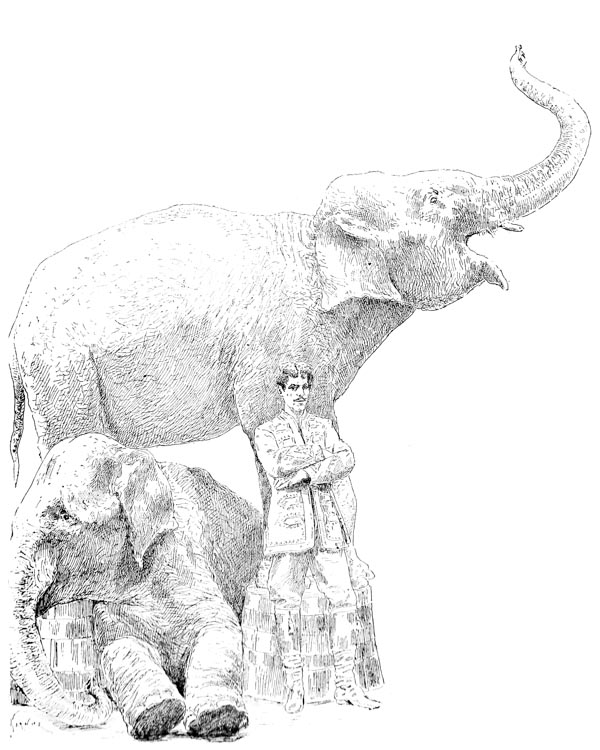
The captain of the vessel which had brought Chung over, came in during the contest between the man and the elephant. He had become fond of the beast, and often fed it with dainties. The animal had scarcely recognized its friend when it approached him with a supplicating air, gently took his hand in its trunk and placed it in the bleeding wound, then held the hand up to the captain’s eyes. The gesture [p126] said as clearly as words: “See how they have made me suffer!”
Poor Chung appeared so unhappy that every one was touched, even the cruel keeper. To win pardon the man ran out and bought some apples, which he offered to the elephant. But Chung disdainfully threw them away. The captain, who had also fetched some fruit from Covent Garden Market, came back immediately afterwards and held it out to Chung. He willingly accepted it, and after eating it, coiled his trunk gently round his protector’s waist.
Since no one has yet succeeded in exhibiting a learned whale, the elephant is the largest animal that has been taught obedience to man. Chung’s adventures would therefore seem a fitting close to this monograph on training.
Yet I wish to crown this chapter by an account of the training of an animal of very different size—the cat. And although this sequence may seem curious to you, it is chosen for at least two reasons; first, that the appearance of a trained domestic cat is the latest achievement of the trainer’s art; and secondly, that I am not sure whether the conquest of the cat is a triumph of training or of taming. There is, in fact, as much ground for regarding the cat as a wild beast, as for considering it a domestic animal.
Hitherto we have believed, on the authority of M. de Buffon, the systematic detractor of the cat, that it was an untamable animal. The great naturalist states that “it will not allow any one to influence its idle, thieving instincts.”
The cat has waited for nearly a century, but at last this slander can be refuted; its falsehood is clearly proved.
Nearly twenty years ago a child was born in a Dutch [p127] village, who, from an early age, showed unusual skill in taming and training animals.
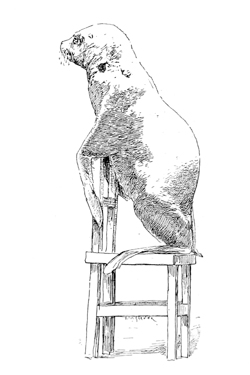
When the youth was seventeen—his name is Bonnetty—he introduced learned rabbits, hares, and guinea pigs, into the arena, so wonderfully trained that even the Dutch, who are not, as a rule, easy to move, were much astonished. However Bonnetty was not going to stop yet. Tempted by the great difficulty of the feat, he determined to prove that M. de Buffon was unjust to the cat, and with rare patience he devoted himself to the education of that animal.
He chose two subjects, both Dutch, like himself, cats from Hooren—M. Bonnetty had remarked, after much [p128] observation, that the cats from that district are particularly docile—and he spent some months in training them; then one by one he added comrades to them, until he had twenty; the instinct of imitation assisted the later recruits to learn more rapidly.
The first exercise consisted in making the cat jump at the word of command.
“Vooruit!” cries M. Bonnetty, who speaks nothing but Dutch.
The cat does not vooruit all at once. It pauses undecided; very often it does not understand. But Bonnetty never loses patience. With a gentle hand, which resembles velvet in its touch, he softly caresses the cat’s spine, quite determined not to be angry, yet equally decided not to yield the point. At last the cat realizes what is required of it, and jumps.
This first step gained, the after-work of education proceeds more quickly. The animal gets used to walking on the backs of chairs and the necks of bottles, or to leaping over flaming circles. But there is one decisive trial to pass through—that of appearing before the public.
M. Bonnetty has had some cats, perfectly obedient in rehearsal, which could not be induced to perform to the sound of music before a crowd of spectators. They coiled themselves up in a corner of their little house, returning suddenly to a wild state.
“I cannot treat them as I would dogs,” M. Bonnetty observed to me, “by interpreting my wishes through a whip. All violence is useless with them; I can only count upon what it pleases them to do; and my cats and I always treat each other with the utmost courtesy.” [p129]
And in a moment of effusion his eyes suddenly filled with tears, and the cat-tamer related to me the story of an incomparable cat that he had lost in Brussels last May.
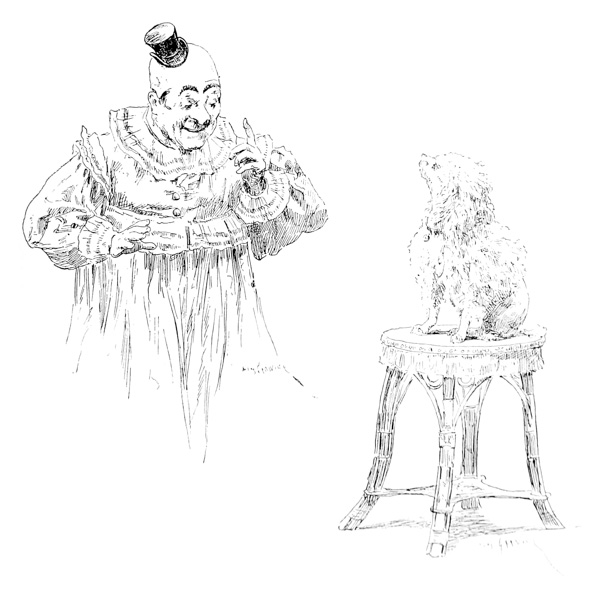
“Ah! monsieur, he was a cat that I can never replace. He would leap over fourteen chairs with one bound, at more than a yard and a half high.
“But you know what artists are: great children, all of them. On the very evening that we reached Brussels, I went to see my animals an hour before the performance. I found that Thommech had made his escape. The poor fellow was high on the tiles rushing after a Brussels cat that had turned his head. He tried to leap from one roof to another on the opposite side of the [p130] street. He fell, and when I picked him up from the pavement he was dying.
“Since then, monsieur,” continued M. Bonnetty, after a moment’s sorrowful silence, “I have made one great resolution: I have now only sultanas in my troupe, and the keepers of the harem.”
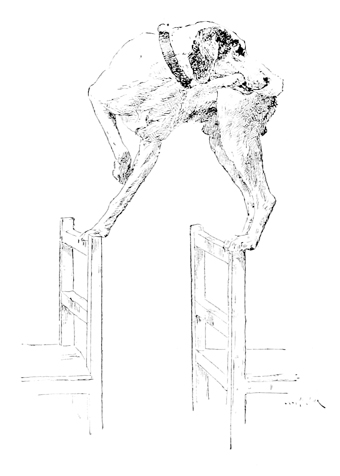
Like Bidel, who introduced a sheep into the cage with his lions, M. Bonnetty has forced his cats to live in harmony with mice and birds.

A flock of Dutch canaries is perched upon a cord stretched across the circus; near them some white mice and dappled grey rats are quietly resting. The tamer then opens the door of the cats’ palace, and in Indian file all the band of artists, Thiber, Jano, Moor, Edward, Paris, Brussel, Boulanger, Djeh, Brutus, and César, march slowly out [p131] striding over the rodents and birds, some of which fly off and fearlessly return, alighting on the heads of the cats.
The first interviews between a new rat and a new cat are really amusing. M. Bonnetty delicately holds each of his pupils by the skin of the neck, and forces them to look at each other, at first holding them at a respectful distance, but afterwards gradually drawing them nearer together, until at last they can touch each other’s nose.
“This proves,” M. Bonnetty said to me, “that the worst enemies are always interested in knowing each other.”
I remember that we parted after this philosophic reflection.
I went home and found my own cat lying before the smouldering fire. He was asleep, crouched in his usual sphinx-like attitude. I approached him gently and said:
“My friend, hitherto I have misunderstood you. I beg your pardon.
“The friendship of so many great men who, from Théophile Gautier to Sylvestre Bonnard, have venerated you as a god, might have warned me that I was wrong to distrust you.
“Forgive me. Bonnetty has proved to me that you are neither indocile nor cruel; henceforth I will live with you in greater intimacy, on terms of confidential affection.”
And whilst pussy purred loudly in the warmth of the dying embers, I bent over him and softly murmured, like a religious invocation, the beautiful sonnet written by Jules Lemaître, the gentle friend of cats and of myself: [p132]
Mon chat, hôte sacré de ma vieille maison,
De ton dos électrique arrondis la souplesse,
Viens te pelotonner sur mes genoux, et laisse
Que je plonge mes doigts dans ta chaude toison.
Ferme à demi, les reins émus d’un long frisson,
Ton œil vert qui me raille et pourtant me caresse,
Ton œil vert semé d’or qui, chargé de paresse,
M’observe d’ironique et bénigne façon.
Tu n’as jamais connu, philosophe, ô vieux frère,
La fidélité sotte et bruyante du chien;
Tu m’aimes cependant, et mon cœur le sent bien.
Ton amour clairvoyant et peut-être éphémère
Me plaît; et je salue en toi, calme penseur,
Deux exquises vertus: scepticisme et douceur.
My cat, the sacred guest of my old home,
Thy sleek electric back now curve for me.
Come nestle on my knee and let my fingers roam
In the warm glossy fur that clotheth thee.
Half closed, now thou hast ended that long yawn,
Thine emerald eye, half scornful its caress,
Thine emerald eye, gleaming with golden rays
That idly kind, yet mocking o’er me plays.
Philosopher, old brother, thou hast not known
The faithful, noisy friendship of the dog,
Yet my heart feels the love that thou hast shown.
Thy clear seeing, perhaps ephemeral affection,
Contents me; and in thee calm sage I greet
Scepticism and meekness, virtues exquisite.
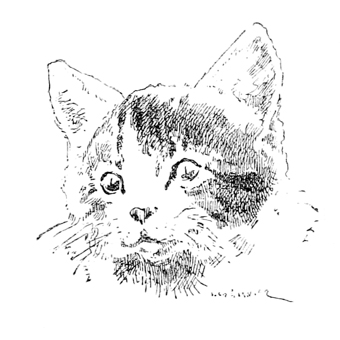
[6] To “dance the basket” is the French idiom for the pilfering of the cook.
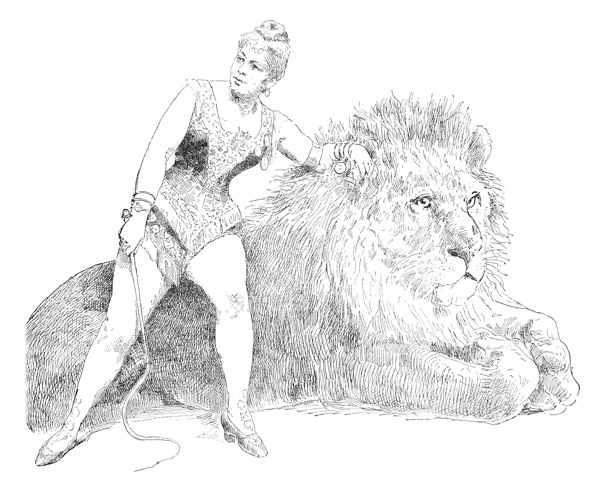
The tamer’s performance is certainly one of those exhibitions which give the most valuable evidence of the superiority of man over animals.
Some morose spirits have put forth the lion’s claims to royalty in rivalry to the supremacy of Adam. In the [p134] menagerie the two candidates meet each other. The lion has formidable jaws and claws; the man has only a pair of boots and a whip. Yet it is the lion that obeys! The great feline’s spring through a paper hoop settles the disputed question in favour of humanity. One leaves the theatre with uplifted head and heart swollen with pride.
And besides this philosophic satisfaction, a visit to a menagerie is one of the most delightful amusements you can choose. You enter a dark booth, impregnated with a strong odour of carrion. At first the eyes can scarcely distinguish the strange sphinx-like forms extended behind the iron bars of the cages, crouching in dreamy, sleepy attitudes. Suddenly the gas-burner is lighted. Two keepers enter, covered with blood like the headsman’s assistants; they bear a handbarrow laden with great quarters of horseflesh; a third person accompanies them carrying a hook.
“The animals are now to be fed,” he cries in a showman’s voice. “The supper consists of more than 600 lbs. of meat. Those persons who wish to see the food distributed are begged to stand a little to the right.”
You follow the hook, the barrow, and the people.
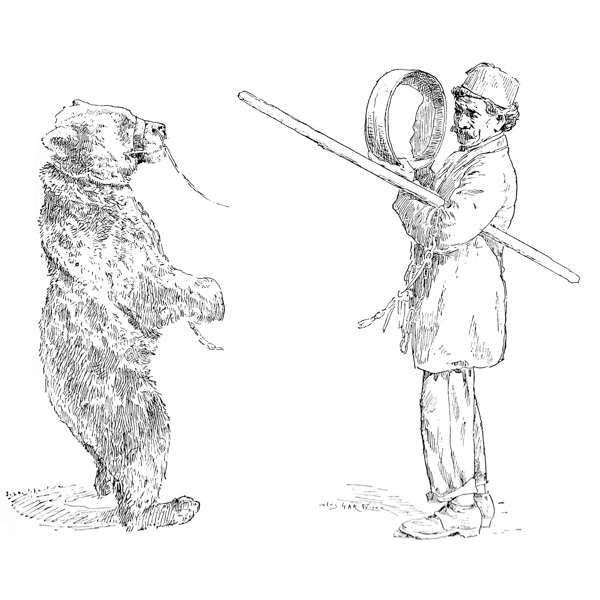
Apparently some whisper of rebellion has passed through the menagerie, but just now resting and sleepy. A howl is raised, which echoes every note of the desert. The keepers add to the animals’ excitement by holding out the empty hook; the lions savagely throw themselves upon it, not seeing that they are deceived. With the gestures of a cat, they glide their paws between the bars to seize their prey, and crush their muzzles and their manes against them. As they pant with rage, their breath rises in clouds of smoke, [p135] scattering the sawdust of their litter. They roar and dribble with hunger. At last the meat is within their reach, and they drag the huge pieces towards their jaws, too large to pass through the bars at first, there is a moment’s struggle, and then the great lumps are triumphantly drawn in. When the booty is held, before rending it, the beasts lie down upon it, with little spasmodic rattles—the expression of satisfaction after rage. [p136]
By the side of the lions the wolf is dancing, uttering lamentable howls. The tigers prowl to and fro in their agitation like phantoms with lapiz gleams in their eyes. The bear waits for his piece of bread in silence. And as the growls of enjoyment slowly, gradually subside, the menagerie resumes its usual quiet aspect, and the beasts lie drowsily on their sawdust beds, lazily licking their jaws with sighs of repletion.
This is the time selected by the tamers to enter the dens.
The women go in with bare arms and necks; the men hesitate between a gentleman’s evening-dress and the red uniform of the Horse Guards.
As the emotions of the audience must be gradually and skilfully roused, the performance usually opens by the exercises with the white bear. An attendant with a hook slips back the protecting partition. The tamer receives the creature, whip in hand.
“Come in, Pierrot.” (Every white bear has been called Pierrot ever since the North Pole was invented.) “Come, you lazy fellow, jump! Show yourself off! That’s right! Once more! A bar for Pierrot! Well! I am waiting for you! Higher, Pierrot, higher!” (The strange creature sways its serpent-like neck and gives a sudden spring.) “Very well done! Now, Pierrot, we are going to see if you are a coward. Ready! Fire!” (The tamer fires a pistol. The bear moves its head uneasily.) “That will do, my friend; you can go. Ladies and gentlemen, there is only one thing which Pierrot cannot endure, that is the smell of powder.” [p137]
Now it is the turn of Sarah the hyena, which comes in with its hobbling step and the suspicious glances of the birds of darkness. It smells the master’s boots, and takes a piece of sugar in its teeth. It soon retires into a corner, whilst Mignonne the panther appears. Mignonne performs with all the grace of a ballet-dancer. She passes from right to left, over the back of the tamer; allows him to raise her from the ground by the ears, and kisses her master’s throat near the nape of the neck.
But this is all child’s play, trifles to commence with; the appearance of the lion is the event of the evening that we are all waiting for.
He enters with all the dignity of the leading performer, almost openly impatient to show himself. His mate follows him. The couple must have been worth seeing in their African solitude in their wild courtship.
Now it is accepted slavery. Rebellion and hope are both over. The lion looks at his master; he seems to say—“What do you want me to do? Show my claws? Here they are then. Feign to be dead? Would to God I were really so! You lie down upon me as though I were a bed; you invite Aïda to come and share your rest. Sleep side by side. When I was free I tore a black-maned lion to pieces for prowling round our den. And now do as you like, whether in darkness or in light. Fire your pistol, your barrel of sparks. I do not dread fire now any more than I feared a battle before my loins were broken in the snare in which I was caught for you.”
Since it is absolutely necessary to raise some laughter and vary this tragic monologue, the lion-tamer calls his usual [p138] buffoon, a poor little Savoyard bear, the delight of nurses and children.
The proximity of the lion is unendurable to the bear. It is willing to dance, to say yes or no, to carry arms, but it shrinks from an interview with the desert king, who has a fancy for receiving it with a loud roar. But we have plenty of time to observe its caution and to ascertain its tastes.
The tamer, already impatient at its delay, calls and scolds it.
“Come in, then, your highness; come in, my little friend. You are always the first after all the others. Look a little more lively then, a little more amiable. You are in society. We have been looking forward to your visit. Here is your comrade Sultan, who wishes for nothing better than to play with you a little.” (Here the tamer takes the bear by the ear and drags it towards the lion, who paws the ground with threatening claws.) “Eh, but what is the matter then? Your highness beginning to tremble? Don’t be frightened, my good fellow. See how well behaved Sultan is; he is always smiling.”
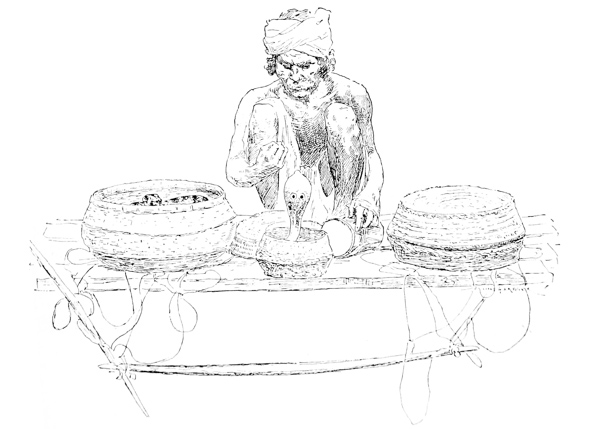
I sincerely pity those persons who are not amused by this comical bear. I, who thoroughly appreciate the delicacy of its performance, can assert that I have never passed a menagerie without entering the office. This is why I am now on such good terms with all the lion-tamers—Bidel, Pezon, Nouma-Hava, and Co. It is already two or three years since I made the acquaintance of Pezon. It was at the wedding of one of his daughters with a young man whose name I cannot recollect, but who had already received his [p139] baptism of blood in the cages. The marriage-dinner was held at Saint Mandé, in the Salon des Familles. All the tamers in the kingdom, male and female, had been invited to this festival. They had not felt it a duty—and I secretly regretted the fact—to wear either their trunk-hose or their riding-boots, but were all in evening dress and lavender kid gloves. We sat down, thirty to dinner, including myself. On my right was a very dark man with a moustache like that of Victor Emmanuel; he has since been eaten in a fair in the south of France. I can affirm that this lion-tamer, as well as his comrades, had an excellent appetite, and I should not have cared to find myself between his teeth. [p140]
Neither leg of bear nor chaud-froid of lion was served at the wedding feast, but the wine flowed abundantly, and, at dessert, all tongues were liberated.
I had, therefore, an excellent opportunity of proving that these powerful men are in domestic life the most amiable of mankind. I never received so many fraternal embraces in my life as at this wedding, where the guests followed the example of Homer’s heroes and heroines, whose last representatives they certainly are.
Judge for yourself:
Besides a bag of gold crowns that glittered brilliantly in the sunshine, the youthful bride entered the new menagerie—I beg pardon, the new home—with a dowry of four lions. A friend of the family had offered her a small panther from Java as a wedding present.
Her godfather had given her two rattlesnakes, and the bridegroom’s brother had added to these gifts an adult rabbit without any hair, a curiosity never met with before.
. . . You, who seek for some means of securing eternal youth in your limbs, should devote a little time to lion-taming, the foam of their rage must be the real fountain of eternal youth.
Look at Jean-Baptiste Pezon: he is more than sixty-three years old, and yet one would say that roots, knotty oak roots, started from his boots and fastened him to the ground, enabling him to stand so firmly on his sturdy hips. And not one single grey hair is to be found in the curious black tresses which fall to his shoulders, worn in the same fashion as that of his contemporary Cladel, whom Jean-Baptiste somewhat resembles. Yet the mask of the lion-tamer is cast in quite [p141] a different mould from that of the literary man. At most Cladel has the appearance of a shepherd; whilst Pezon looks like a wolf-driver.

In fact Jean-Baptiste commenced his life of adventure in that capacity. Born in Lozère, he worked in the mines during his childhood, and was there initiated in rude muscular labour at a very early age: but he cherished the dream of [p142] leading a wandering life. He longed for unlimited space before his sturdy legs, the heavens for roof over his head. He therefore quitted his subterranean employment and became a plough-boy. For some years he was celebrated through all the country side as a tamer of savage animals; dangerous cows, horses, and bulls were submissive in his hands, and he forced the beasts to obey him as much by his audacity as by his strength. He was also a hunter. One day he snared a living wolf, and it suddenly occurred to him to leave his servile employment and travel through the world with this strange companion. The wolf learnt to “carry arms,” to walk on its hind legs, and to carry a wooden bowl round to the audience. When enough money had been acquired by these collections, Jean-Baptiste obtained another wolf, then a bear, and a bull, which he harnessed to his cart; and with this equipage he made—to quote his own words—“the tour of France and the great powers.”
A little later the tamer bought his first lion at Bordeaux. It was an animal with a superb mane, but his hind quarters had been injured by the trap that caught him. At three o’clock in the morning Jean-Baptiste appeared on board the vessel belonging to the captain from whom he had bought the lion, to take possession of his new acquisition.
“But how will you take it away?” asked the sailor, slipping his two hundred louis into his pocket. “You have not brought a cage?”
“I have a collar and a chain,” replied Pezon.
He shackled the beast like a small Savoyard bear, and led him home with a leash. [p143]
Now Pezon owns at least thirty lions—as many adults as cubs. He has built a good house at Montreuil, and is thinking of giving his farewell performance.
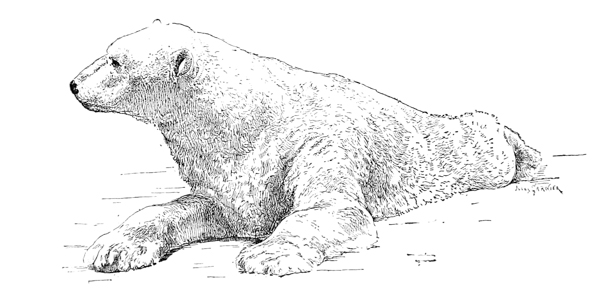
The success of M. Bidel, Pezon’s comrade and rival, was even more rapidly attained. At fifty years old he had reached the summit of wealth and honour. His visiting card, now lying before me, recapitulates the series of lucky events which have placed the tamer in this unique position much better than I could do:
And in the left corner of the card, where you would put your address, the single word Propriétaire (house-owner).
Do not smile at this; Bidel has the right to be proud of his villa at Asnières. To him, after so many years spent in [p144] moving round the world, the word propriétaire signifies the anchor dropped, the harbour won. It is a genuine certificate of bourgeoisie.

Bidel is not only one of the richest bourgeois of Asnières; he might be called the lord of the manor. Behind his gilded iron gate, ornamented with lions’ heads, with the porter’s lodge to the left, the stables to the right, and a fine expanse of turf, the red and white villa looks like a small castle. The dining-room is decorated with panels, on which Rosa Bonheur has painted some lions; but this is the only detail which could [p145] lead any one to suppose—unless previously warned—that he was visiting the house of a tamer of wild beasts.
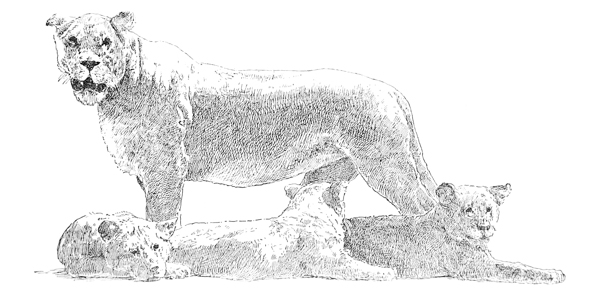
I am sure, good people, that you would picture to yourselves a Bidel ending his life in a room encumbered with the spoils of the lion of Nemæa and Indian tigers. But you are far from the truth. Do you not know that an ironical law governs all the wishes of man, the wishes of lion-tamers as well as our own? It is called the law of contrasts. In virtue of this rule M. François Bidel has furnished his drawing-room in the purest Louis XV., and the ceiling, panels, and seats are covered with pastoral designs of shepherds; idylls and love flourish in all the four corners of the pretty room.
Mdlle. Bidel’s piano is the sole object bearing a different date.
Perhaps you may have seen this charming young girl with her mother in the ticket office on the day of some great performance. She has just enough romanichel blood in her [p146] veins to give a slightly exotic brilliancy to her brunette beauty. Naturally, this pretty girl is an heiress. Her education and accomplishments are perfect, and she has passed her examinations at the Hôtel de Ville.
“Of course our daughter has no intention of teaching,” Madame Bidel observed to me casually, “but her success was a satisfaction for her father.”
All this comfort and luxury have not been won without some dangerous encounters with the lions. Bidel, like Pezon, has passed under the mill of their claws, and they can both show the scars of serious wounds to those sceptics who may be inclined to deny the risk of their performances.
A number of chimerical stories are current about the lion-tamer’s secret. Here is one of them: that it is usual to mix narcotics with the animals’ food, or even to teach them those bad habits which led the celebrated Charlot to a premature death.
The truth is that a certain number—a very small percentage—of the wild beasts in a menagerie are considerably stupefied. Guy de Maupassant told me that in Rouen a tamer having lost his keeper, engaged a willing man from the port, to whom he confided the duty of cleaning the cages. On the morrow, when he went into the menagerie, the master paused aghast. His new servant had quietly entered the cage as though it were a stall, and was giving the lion some heavy blows with his broom handle to clean between his paws.
At the Folies Bergère a lioness was at one time exhibited by Colonel Bone, who was taking her round the world. This animal was so savage that it was necessary to chain her into [p147] the cage with an iron collar. When the colonel merely passed near the den she would fling herself against the bars with such fury that the whole car trembled. But one day one of the managers of the theatre was inspecting the side scenes and witnessed the following incident: the colonel’s servant was installed in the cage, quietly painting a background of savannah on a canvas stretched over the floor. The lioness was unchained and watched him as a dog watches a fisherman, stealthily licking the green paint from time to time; the result being an attack of colic which nearly sent her to roar in another world.
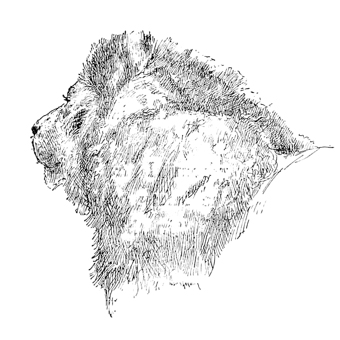
I, who now address you, have entered a black-maned lion’s cage quite recently. Oh! do not exclaim at my heroism. A great many people have visited this captive king of the desert; first, Tartarin, then all the Marseillais, then Mademoiselle Roselia Rousseil, who on a similar occasion dedicated a poem to Bidel, entitled, La Mort du Lion, ou le Dompteur [p148] par Amour (The Lion’s Death; or, The Tamer by Love), which commenced with these lines:
C’est un vaillant dompteur, jamais il ne recule.
Son corps semble pétri par les dieux; l’on croit voir
La grâce d’Apollon dans la force d’Hercule.
Pour moi, j’aime surtout son grand œil doux si noir.7
I did not visit the lion in order to write verses to him. I merely wished to be introduced to him because I knew that I should have to mention him to you. It was a scruple of professional honesty on my part.
Here is a true account of the interview without any embellishment.
The lion-tamer, with whom I had a short previous conference, answered for the safety of the attempt.
“You must wait,” he said, “in the entrance to the door until I call you.”
He then entered the cage in a familiar way, and as the lion was asleep, he pulled it by the ears. When the beast, who at first grumbled a little, was sitting up and seemed composed again, my companion called to me:
“Come in, now!”
I went in cautiously at the back, taking two steps forward, so that I might still be nearer to the door than to the lion. I must own that the desert king did not honour me by even turning his head. He was talking to his tamer. The two gentlemen left me standing, and I looked rather like a bootmaker waiting for orders from a nobleman. [p149]
Man is a coward. The lion’s contempt gave me courage. I advanced a step so that I could touch the leg of the beast.

“Oh!” I said, “how silky it is!”
It was not silky at all, it was abominably harsh.
Since then I have reflected upon the feeling which could have induced me to utter this falsehood, and the result of this self-examination is so humiliating that I will confide it [p150] to you as a penance. In fact “how silky it is” was prompted by an instinct of base flattery—a courtier’s compliment—the toadyism of a coward who felt himself nearer to the lion than to the door.
The boldest individuals, who put their heads two or three times a day into the lion’s mouth, have told me that the best way to withdraw it from the gulf is, first of all, not to open the acquaintanceship with this experiment; and, secondly, to perform it with great nerve.
Nerve, that is the great secret of the lion-tamer, the sole cause of his authority over his beasts. When he has studied a subject for some time, endeavouring to master its character—and amongst the higher animals the character is very individual, very accentuated—one morning the man quietly walks into the cage. He must astonish the beast and over-awe him at once. As to the training, it consists—and here I quote the words of an expert in such matters—in commanding the lion to perform the exercises which please him; that is to say, to make him execute from fear of the whip those leaps which he would naturally take in his wild state.
There is one fact which no one would suspect—that it is easier to train an adult lion taken in a snare than an animal born in a menagerie. The lion of the booth is in the same position as sporting dogs which play much with children; they are soon spoilt for work. Pezon possesses five or six lions which he has brought up by hand. As a rule they live with the staff of the menagerie on terms of perfect familiarity, but this frequently leads to tragic accidents. [p151]
Lions, even lions in a fair, will devour a man in fine style.
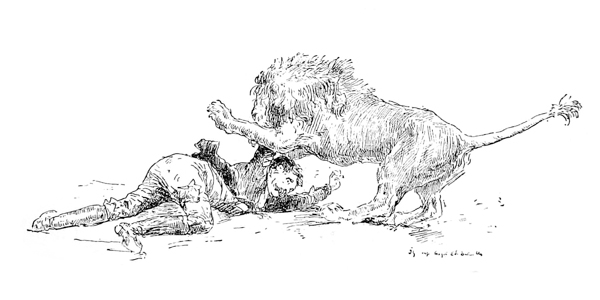
Can I say that the fear of such an accident is ever sufficiently strong to make me pause on the threshold of a menagerie? No. I cherish, and, like me, you also cherish, the hope that some day perhaps we may see a lion-tamer eaten. This contingency sometimes occurs, in fact more often than is usually supposed. For instance, without leaving the Pezon menagerie, it is not a year since the proprietor narrowly escaped being devoured by his bear Groom at Chalons-sur-Marne. He would have perished if his son Adrian Pezon had not thrown himself, sabre in hand, between the two combatants and killed the bear on the spot.8
This act of heroism has been celebrated by the poet Constant Robert in some remarkable Alexandrines, which deserve to be handed down to posterity:— [p152]
L’assistance appelait au secours, et l’horreur
Qui s’empara soudain de chaque spectateur
Ne saurait se décrire! On était dans l’attente,
Sans pouvoir l’éviter, d’une mort imminente!
Lorsqu’au moment critique, intrépide, haletant,
Un lion apparaît sous les traits d’un enfant!
Son fils et son élève! . . . Adrien! Oui, lui-même!9
As to Bidel, every one recollects that in July, 1886, at the fair de Neuilly, a lion mangled all one side of his neck.
Two of my friends were amongst the spectators of this duel—the painter, Edouard Detaille, and my dear comrade Paul Hervieu.
When Detaille reached home, on the same evening, he made a rapid sketch of the conflict between the man and the lion whilst the impression was still fresh in his memory. He has kindly authorized me to reproduce it here. The effect is of a cat playing with a bird. Bidel’s coat was torn into fine shreds by the scratching of the claws from the collar to the waist, showing the flesh underneath. On his side, Paul Hervieu was good enough to send me the valuable notes which you are about to read. He addressed them to me in the form of a letter, which has been published in the Monde Illustre.
“The accident took place on one evening in July, 1886, at the Neuilly fair. The weather was heavy and stormy, and the lion-tamer had one foot bandaged for gout.
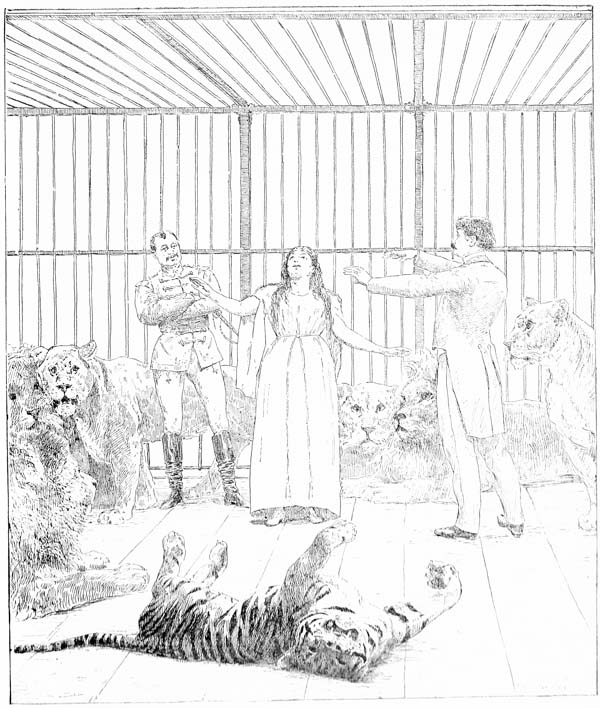
[p153]
“However, the performance was nearly over, and it seemed as though everything would soon be safely ended, in spite of the unusually refractory voice and attitudes of Sultan, a fine dark-maned lion (for the lionesses, although I believe they are all blonde like Eve, can choose between dark-or light-coloured manes amongst their large-headed lords).
“Suddenly Bidel fell, having caught himself in his blunt two-pronged iron spear, and in some way tripped over it. Every one present uttered a brief cry. Then, a deadly silence fell upon the huge tent—a silence so intense that the hissing of the gas-lights could be heard.
“I shall never forget the man’s face at the moment he lost his balance. I still see his starting eyes, the white balls vividly contrasting with his features, congested by gout and by his previous efforts. It was the expression of one who feels that he is lost, who is sinking into an abyss. Now the tamer was lying upon the floor of the cage like an inert mass, without a gesture or a cry for help. He never attempted to raise himself, probably through some tactic dictated by his experience, but apparently he had the time to do it in, for the lion still remained crouched a few yards away.

“Perhaps, my dear Le Roux, you have some wish that I should define the nature of the emotion which seizes an eye-witness under these circumstances? This emotion is certainly multiform. Thus, for my own part, you may feel sure that I was distressed, horrified—that I regretted being present on that fatal evening. . . . On the other hand, if you do not object, I will tell you that I was accompanied by a friend, a kind of inseparable, who is very curious about rare sensations.
“Now this friend has since confessed to me that whilst the lion remained immovable he was conscious of one idea . . . . how can I express it? . . . . In short, it was like a ferocious wish that something unexpected should happen, like a monstrous impatience. . . . .
“And, in excuse for my friend, I try to convince myself that he was not alone in feeling an abominable and vague desire; to me it seemed to have imprinted a fugitive expression upon all the blanched faces that rise before me even now: for instance, that of a small, freckled, red-haired woman [p154] clinging to her husband’s arm, who gnawed her lower lip and mercilessly climbed upon my feet—mercilessly, at all events, for my feet.

“At last the lion raised himself upon his four paws, and without advancing, gazed at his inert master with extreme distrust of the mass armed with a whip, ‘who was saying nothing worth hearing.’ One second passed in this way, or one century, I could not be sure which. Then Sultan made, towards what he began to consider a possible prey, two small furtive steps . . . . two cat-like steps, prudent and stealthy . . . . and again, two little steps. Then he laid one of his heavy paws upon his tamer’s shoulder, still not maliciously, rather as a caution, as we should place one hand upon a sheet of paper in danger of blowing away.
“In thus interpreting the ideas passing ‘through the darkness a lion has for soul,’ to quote a line from Victor Hugo, I have at least the satisfaction of knowing that my impressions harmonize with the picture that Edouard Detaille seized with the eye of a great painter.
“But oh, my dear Hugues Le Roux, no pencil of the illustrious artist can depict, all the resources of the pen are powerless to describe, the frightful tumult which, in the hitherto silent theatre, greeted this first act after the gloomy prologue—an infernal din, the noise of falling chairs, of shouts, of screams! . . . .
“If I ventured to write an essay on the physiology of modern wild beasts [p155] in the course of the reflections which I should be forced to devote to the accidents of the show, I should not fail to mention these axioms:—
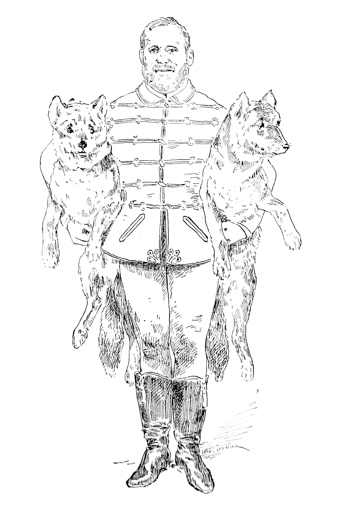
“1. A female spectator never faints until there is nothing more to see . . . .
“2. The audience in the second places is only waiting for an opportunity to rush into the first seats . . . .
“And, in fact, without a moment’s interval, all the barriers were scaled. Round the cage women were eagerly pushing men aside in their efforts to get a better view. And shrieks!—but the shrieks!
“When the clamour first arose Sultan turned his head towards the multitude, [p156] which he looked at with really sublime tranquillity for an amateur, as my friend pointed out to me. No doubt it was the vivid light and the movement of the crowd which made the lion wink—yes, his eyes twinkled. And in itself that gave a shadow of indulgence to his strength. But now he returned to his captive, tormenting, teasing, mumbling, rather than biting him. It was like the play of a pupil who emancipates himself, but is yet conscious of his fault. But then it was lion’s play! Sultan moved in small jumps, all four paws together, turning his hind quarters to the gallery, tossing his jaws, full of no one knew what . . . . perhaps a human head!
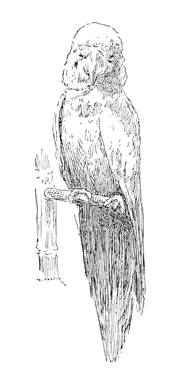
“Here I can guarantee, my dear Le Roux, that those who at first shared my friend’s infamous and fortunately indefinite wish, must, like him, have found themselves almost fainting before such a realization of carnage. . . . It was frightful and senseless. One felt scarcely alive, and no longer heard oneself howl. Suddenly the lion relinquished his prey and steadily watched the back of the cage, behind which he must have caught the sound of some noise only perceptible to a feline ear in the tumult of this bloody orgie. In the midst of the excitement the door was abruptly opened and two men appeared, presenting like bayonets two simple iron bars. [p157]
“When he saw them Sultan timidly drew back like a guilty schoolboy who has failed in respect towards his master, and who is recalled to his duty by the entrance of the monitors. He was already in retreat, backing into the neighbouring cage, spurred on by the vibrations of the partition which the men were handling.
“Already, too, Bidel had been raised, and his first energetic movement was to rush towards the lion, who, now separated from his enemy, watched him through the railing, rather jeeringly moving his head from right to left. A thunder of ‘Bravos’ and shouts of ‘Enough! enough!’ stopped the lion-tamer, who had one half of his neck laid open. From his forehead, just between the eyes, a red strip hung down. The linen showed everywhere beneath the holes in the cloth. The skin on his knees was bare, yet intact.
“After this scene, whilst the wounded man received the first dressing to his wounds in his travelling-van, the general attention was drawn towards Sultan, who had returned to the society of his comrade Nero, the blonde lion, who was languidly stretched out, digesting his daily rations of meat and blows. But the dark-haired lion did not lie down; he restlessly prowled up and down in suppressed excitement, his haughty nostrils sniffing the scent of blood in the air. His tail lashed his sides alternately. And each time that he passed Nero’s jaws, the latter soothingly licked a purple curdled spot, which the taster of human blood still retained upon one of his great toes.
“At this moment a harsh voice in the crowd murmured close to my ear—
“‘Moâ, j’étais pértisan du lione!’ (‘I was for the lion.’)
“Turning round, I found myself facing an emaciated being, tall as a pole, beardless, wrinkled, without any visible marks of age, and very dirty. In the nervous state in which I found myself, a superstitious influence at first led me to believe that I had met the Englishman who makes it his profession to follow lion-tamers about the world until there is not a joint of them left.
“But now I believe that the speaker had no connection with the legendary lord. And the lione of which he was pértisan must have been the most respectable acquaintance that he could hang on to. I have, in fact, met this individual again in the bookmakers’ corner of the racecourse at Longchamps, and this was his trade: imagine a start of six horses; he would go up to six greenhorns, and successively murmur in their ears, as quickly as possible, the name of a different winner to each man. After the race he went up to the individual whom luck had favoured and claimed a reward.
“Let us, then, my dear Hugues Le Roux, distrust all the new acquaintances we may meet, even under the patronage of a lion, and let us rely upon old friendships, such as I feel for you.
“Paul Hervieu.” [p158]
I have quoted, almost as it was written, this letter from an artist, who, like the lion possesses a good eye and velvet paws, first, because I felt sure that it would interest you deeply; secondly, because it delighted me; and thirdly, because it is a good proof that there was some danger in approaching the lion, whom I interviewed in his cage for your satisfaction. I do not wish to pose before you as a Tarasconese hero, but I do not wish either that you should take me for the pantaloon of Italian comedy.
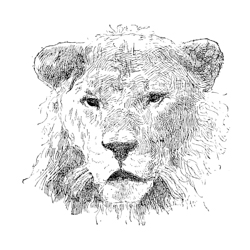
He is a valiant tamer, he never recedes.
His shape combines the gods, in it one seems to see
Apollo’s divine grace, with the strength of Hercules.
But, above all, his soft, dark eyes, are dear to me.
[8] In this summer of 1889 another son, Edmond Pezon, has been twice injured by the lion Brutus.
[9] The audience screamed for help; the great terror Which seized the heart of every spectator No words can picture. Breathless all present wait, Helpless to rescue the man from impending fate, When, at the vital moment, fearless, yet panting, A lion appeared, in guise of a stripling, His son and his pupil! Yes, Adrian himself!

I retain amongst the recollections of my provincial childhood, the remembrance of an annual festival, in itself noisy and marvellous, and even now, when I close my eyes, I can recall the brightness of its lamps.
Every year, at Saint Michel, in the month when the clear heaven is spotted with kites, in one square of the old city, by the side of the paved road by which the Paris coaches formerly passed with sonorous smacking of the whip, a palace of new planks would rise in a few days as light as a house of cards. Enormous placards on every wall announced the arrival of a grand circus consisting of fifty horses and one hundred and fifty artists.
For some weeks beforehand our boyish hearts were seriously disturbed. Every day, after school-hours, with [p160] books under our arms, walking like truant schoolboys, we went to enjoy, through the half-open doors of the stables, the intoxicating smell of horses, blended with the scent of fresh sawdust and that perfume of musk which turns the brains of men. And then, peeping through the chinks between the badly fitting planks, we could watch, in the half light of the circus, the rehearsals of the beautiful equestrians for whom our youthful hearts were beating, as naïve and courageous as those of their own horses.
At last some fine morning the passers by would see on the placards the announcement of a gala performance. “The professors of the college and MM. the pupils of the Lycée will honour this entertainment by their presence.”
It was on one of these evenings, now almost twenty years ago, that I first saw and loved poor Émilie Loisset, before her success in Paris and Vienna, when she made her début in the haute école, and played in a pantomime disguised as Prince Charming, with her sister Clotilde, now an Hungarian princess. Her touching story has been related by Philippe Daryl in his charming novel La Petite Lambton. At that time Émilie was not more than eighteen years old, and she was the most charming creature in the world. Still her eyes and her face wore a curiously melancholy expression. I learnt afterwards that the most flattering success could never dispel the instinctive distrust of life, the romantic fancy for gloomy subjects which afterwards led her to take a house exactly opposite the little cemetery of Maisons-Laffitte.
She was buried in it two days after she had been carried from the circus mutilated and crushed by the fall of her horse, which, in refusing a jump, had fallen upon her. [p161]
Forgive me for opening this chapter by evoking the melancholy smile of one who is no more. But I owe this tribute to Émilie Loisset; for it is through her, that, as a child, I received the first revelation of the beauty of a woman on horseback, of the artistic union of the two most perfect curvilineal forms in creation—the horse adding height to the woman by the majesty of its stature, the woman daringly poised on the animal like a wing.
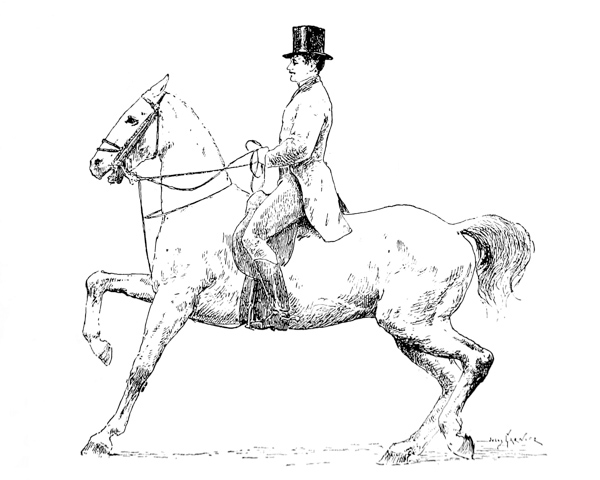
But long and serious work, both for the equestrian and the horse, has preceded this harmonious union. Although the woman and the animal have acquired the habit of conquering difficulties together, and have even attained perfect unison of will and obedience, yet they have each studied alone, slowly [p162] reaching that perfection, that confidence in their own powers, which produce the success of their alliance.
It is important that the various phases of this education should be defined at once. The studies of the equestrians of the haute école, the highest form of training for horse and rider, differ completely from those of the pad equestrian, whilst the lessons given to performing horses differ equally from those of the haute école.
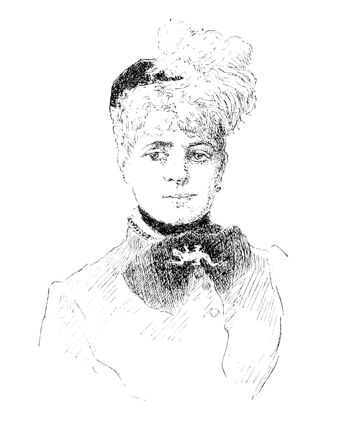
France possesses the legendary trainer of performing horses, M. Loyal. For thirty-five years he has introduced his pupils to the public. M. Franconi possesses an old mare—la mère Tulipe—twenty-two years old, who was trained under his whip. Every year M. Loyal undertakes some new [p163] pupils, and enlarges the sphere of his conquests. He is so certain of his own pre-eminence that he takes no trouble to conceal his method. He has often invited me to his rehearsals, and I have met fellow-workers there who had gone, like myself, to learn from him. One day M. Loyal even gave one of us a short essay on the subject of his work, which has since been published.
 [p164]
[p164]The horse, in the opinion of the celebrated trainer, is one of the dullest animals created; it has but one faculty, memory. On this account it must be forced to learn its tricks by the aid of the curb and whip; they are imprinted in its memory by the whip if it resist, and by presents of carrots if it obey. On these terms every horse can be trained, but it is well understood that certain breeds, such as Arabian and German horses from Old Prussia, are easier to teach than any others, and also that the animal’s age is of great importance. It must not be either too young or too old; the best educations are given between five and seven years old. Before that age the horse is too excitable, too nervous; he gets confused. Later than that his muscles are not sufficiently flexible.
The A B C of education consists in rendering the horse familiar with the arena, making it go round regularly and stop at a given signal. To teach it this first lesson, M. Loyal leads the creature into the circus and places it close to the palisade, whilst he goes into the centre of the ring. In his left hand he holds a long leash, which has been passed through the curb or cavesson—every one knows that this is a semicircle of iron armed with a sharp point, which is placed upon the nose of the horse. In his right hand he holds a long whip, whilst an assistant, armed with a strong riding-whip, is concealed behind the animal. In this position the trainer utters a call, then lightly pulling the horse, forces it to walk. If it resist the assistant gives it a blow with the whip, if it obey it receives a carrot from its master as a reward, after three or four turns round the arena. To make it stop, the trainer suddenly cracks the whip in his pupil’s face, whilst the assistant throws himself in front of it. [p165]
The same method is used in teaching a horse to leap. It is placed in front of a barrier, and is encouraged to jump over it by voice and gesture; if it refuse, the assistant gives it a volley of blows on the croup with his whip. If it jump, the ever ready carrot is its reward.

To make it point, the ring-master has simply to place [p166] himself squarely in front of the horse, to shake his riding-whip with the left hand, whilst he cracks his long whip with the right.
But although the horse learns these tricks with comparative facility, a great effort is required before it can be taught to kneel. The trainer is obliged to resort to surprise. A bracelet is attached to the two fore pasterns just above the hoof, and a cord is attached to it by one end, the other being held by the trainer. Suddenly M. Loyal attracts the attention of the horse by a sharp cry; at the same time he shakes its confidence by a pull at the cord and a vigorous blow on its shoulder. In a short time the horse kneels down at the master’s call without being tripped or coerced in any way.
Next to this achievement, the most difficult feat is teaching a horse the trick of changing feet. This requires fully a year of patience. The animal is led into the arena and commences its usual exercise round it. The trainer allows it to settle quietly into its stride, then abruptly, with a touch of the whip cleverly applied, he tries to break its pace; that is to say, to make it change step. If this result is obtained, the horse is allowed to gallop round the ring once or twice, then it is checked again to make it return to its former step. When the animal understands what it ought to do at the touch of the whip, instead of completing the turn round the ring on one foot, it is forced to change at the half round. Afterwards it is only allowed a quarter turn, then only three or four steps without changing, and lastly only two. The horse thus appears to dance the polka when it performs to music, which accompanies and follows its movements.
The ring-master usually chooses a well-bred horse from [p167] amongst the animals trained in this way, and already broken, for initiation into the haute école.

No one will expect me to discuss here the principles of this training, nor even the theories of circus horsemanship. [p168] I refer the reader to the special treatises written upon the subject by men in the profession, particularly to the fine book which the historian of sport, Baron de Vaux, has published under the title of Les Hommes de Cheval.10 I especially recommend the perusal of the chapter consecrated to the Franconi family. It contains an account of how Laurence Franconi taught the present manager of the two circuses the principles of the School of Versailles, whilst freeing good horsemanship from the superfluities in use in the time of Pluvinel. Laurence Franconi wished for a less formal, less studied style of horsemanship. The introduction into France of English horses trained in the hunting-field and on the race-course, and the re-organization of the cavalry, had demonstrated the necessity of preparing horses for greater freedom of action. It was realized that good riding did not consist merely in forcing a horse to show off and tire itself uselessly in obtaining a striking effect, but in well calculating the strength of the steed, in husbanding its forces, and regulating its paces. It was at last recognized that the ideal horse of the haute école should be easy in its balance and in its artificial paces under the guidance of its rider, and that on his side the rider should only use the force necessary to maintain this balance, and to secure the execution of the airs of the haute école.
On these principles Laurence Franconi trained Blanche, Norma, and Hector; Victor Franconi, his son, trained Frisette, Ajax, Waverley, and Brillante; and Charles Franconi, his grandson, educated Régent and Moscou. [p169]
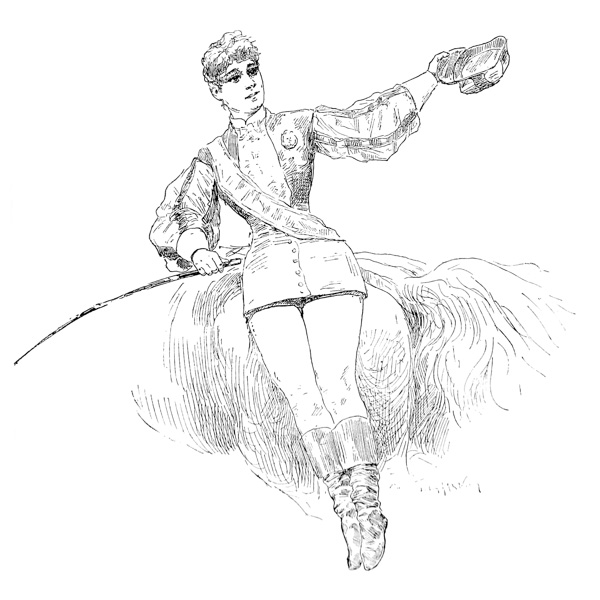
I remember being present at the Cirque d’Été during one of Moscou’s rehearsals, ridden by Mdlle. Marguerite Dudlay. The little empty circus was illumined by a red light, the reflection of the April sun upon the velvet of the benches. Charles Franconi was watching the work of the equestrian and her horse. It was a Russian stallion, beautifully shaped and very elegant; in its veins it showed the vigour of the [p170] Slav-blood, full of revolt, excitement, passion, and violence, veiled by affected gentleness, lost in compliance with its rider’s will.
A ring-master, armed with a whip, held the horse in front of a barrier which he gradually raised. Without any apparent effort Mdlle. Dudlay lifted the grand quivering beast over the bar. The young girl was bareheaded, and her hair had fallen down with the shock. She was a charming picture in her dangerous leaps, with her long wavy hair flowing over her shoulders.
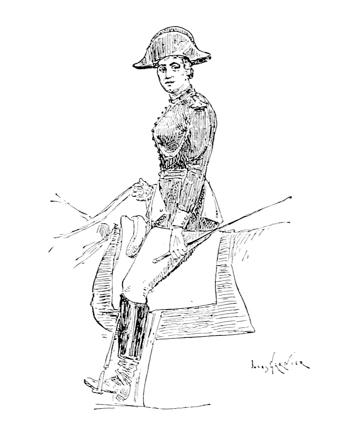
After the rehearsal I went up to her to speak about her horses. She was very fond of them, and would not allow them to be scolded. They were her friends.
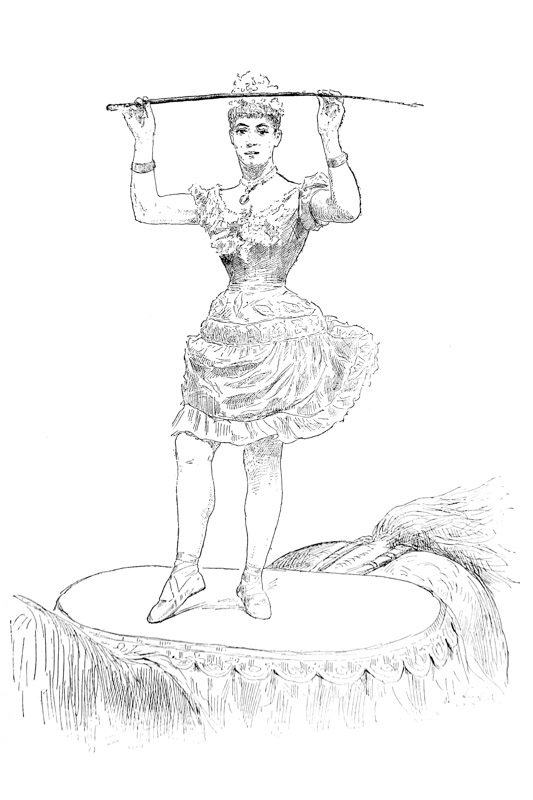
“Moscou is so gentlemanly!” she said, showing me the [p172] horse, which an attendant was leading away covered with foam. “He has such good manners!”
And in a low tone she owned to me that she preferred him to Regent, a grey of classic beauty, much more reliable than his comrade—loyal, vigorous, and brave; but he replaced coaxing by a military deportment, the correct stiffness of an officer.
“No doubt I am unjust,” said Mdlle. Dudlay, “but how can I help it? Moscou and I love each other.”
That is the secret of the haute école as well as of everything else. Habit and skill are insufficient—love is necessary too. It is through love of the little hands which caress their necks that these great horses throw all their energies into leaps which exhaust them; it is through love that they humiliate themselves, that they kneel down. For my own part, I know no grander spectacle, no more spiritual combination, no triumph more admirable of mental over physical force.
It is almost unnecessary to add that these instances of perfect harmony are the exception, not the rule. The little “mashers” in white ties and dress-coats who encumber the entrance to the ring, and surround the equestrian as she mounts her saddle, crying “Bravo!” and “Très chic!” at every movement she makes, hope by their eagerness, by these exclamations, to pose as horsey men in the eyes of the crowd; but they never imagine the duplicity of which they are the victims nineteen times out of twenty.

There are, in fact, two very different categories of equestrians of the haute école; first the wives, daughters, and sisters of the circus managers, who are placed on a horse [p173] trained in the establishment at an early age. Let us softly add that these subjects are nearly always, to quote an expression of M. Molier, “Les fruits secs du panneau.”11 It sometimes occurs also that a well-to-do manager, who thinks of marrying his daughter in the bourgeoisie—or even in the aristocracy—hesitates to exhibit the young girl in the semi-nudity of tights. He is afraid of alarming the future husband. This has happened with several accomplished equestrians like the late Émilie Loisset, and, at the present moment, Mdlle. Renz.
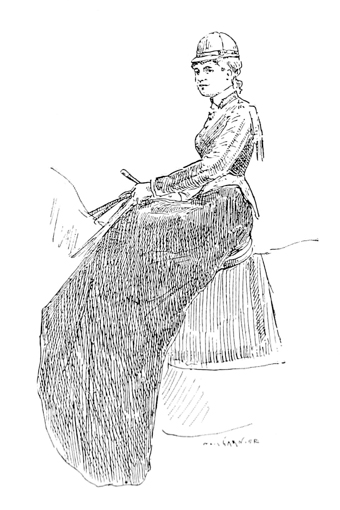

As a rule, the equestrian of the haute école is a pretty girl who wishes to appear in a circus, and who has found some one [p174] to minister to her vanity. This “some one” must be rich—very rich. The horsewoman in question must take with her three trained horses—two of the haute école, and one leaper. This trio of horses costs a great deal. It is only in a circus that they can be obtained ready to work [p175] with a woman, and the trade in them is a speciality of German circuses. Old horses trained in the haute école, regular as clocks in their movements, may be found there for sale at from 10,000 to 15,000 francs each. The value of the horse sometimes even rises to 20,000 francs if it has a good tail.
A few weeks’ work suffice to “adapt”—another expression of M. Molier, to whom I owe the revelation of all these secrets—a very mediocre equestrian to one of these mechanical horses. The animal, annoyed by its bad rider, who shuffles on her saddle, does not perform one-half of the work which the man has taught him. But the public does not know this, and the would-be sportsmen who adorn the entrance to the ring open admiring eyes when the pretty girl assures them, from the superior height of her saddle, that she trained the horse herself.
These frank explanations will probably make many pretty enemies for me; but, at least, they ought to assure you of the sincerity of the admiration and respect which I profess for the pad equestrians or standing equestrians.
Apparently, in a circus, a woman’s virtue is in inverse proportion to the length of her skirts; the riding-habit is suspected, whilst muslin petticoats soar above all scandalous aspersions.
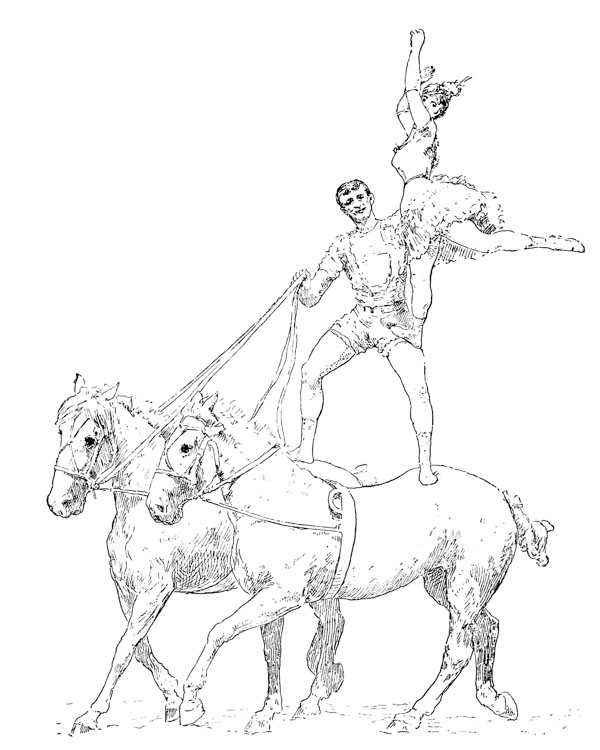
The “standing” equestrian is usually married to a circus artiste whilst still very young; she is an excellent housewife and a model mother. As long as maternity does not interfere with her profession, she shares her husband’s dangerous performances during her youth. With him she dislocates herself, and bravely fractures her arms and legs. She has [p176] scarcely recovered before she recommences her work. Her circus education is complete. She was placed on a horse at six years old, and besides her standing-up performances—the [p177] most difficult of all—she has learnt the mimic art, the slack wire, juggling, gymnastics, sometimes even the “carpet.” I am not alluding to the haute école. An equestrian who can ride standing is so sure of her balance, and so much accustomed to her horse, that she can ride on a side saddle with very little instruction. She can therefore appear as an equestrian of the haute école with only a few days’ rehearsal.
But amongst all the necessary studies that form part of the education of a pad equestrian, there is one fundamental and primary one to which she devotes as much time as to the riding-school; this is the art of dancing. The equestrian follows the same classes as a ballet girl. Dancing lessons make her turn her feet and knees out, teach her to carry her arms and head well, and give her equilibrium and grace. There are some instances of dancers who, having injured themselves in the exercise of their art, have learnt to ride standing in less than a year.

The horse ridden by a pad equestrian should be a reliable animal, with smooth even paces. The regularity of its movements is so important that now the most popular equestrians possess their own horses, and insist upon the manager of the circus engaging them too. This is a wise precaution. I remember one day at the Cirque d’Été seeing Mdlle. Adèle Rossi contend with a fine piebald horse which replaced her usual steed. She appeared as a jockey, standing and booted, in a vaulting performance in which she was charmingly jaunty and graceful. She made her spring in the ring, and alighted standing upon the galloping horse. Each time she leaped the animal was startled and changed [p179] its foot; this produced an abrupt movement of the shoulder, which sent Mdlle. Rossi back into the arena. The young girl was obliged to recommence her performance a dozen times before she succeeded in it, amidst the applause of the audience.
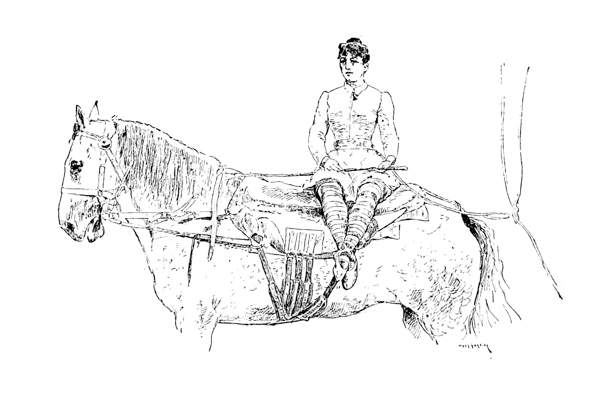
This wonderful equilibrium is only acquired by great practice and much patience. You may now see an amusing performance at the Nouveau Cirque styled a “Riding Lesson” on the programme. The stablemen place a large gibbet, which moves on its own axis, in the centre of the arena. From the arm of this apparatus a ring, attached to a cord, hangs above the ring-master, who is on horseback. The other end of the cord is attached to the pupil’s waist. You will at once realize the amusement which is derived from the awkward movements of the gibbet. The man in the black coat, who wished to take a riding-lesson, is left swimming in the air, whilst the horse gallops on the other side of the [p180] arena. But at the rehearsals of an artist, the gibbet manœuvres with more circumspection, and it has very generally replaced the cord, which was formerly fastened on one side to the pupil’s waist-belt and held by the riding-master at the other end, whilst it passed in the middle through a ring hanging from the ceiling.
The first time that an equestrian, supported in this manner, takes a lesson on the pad, she is made to gallop in a sitting posture until she is thoroughly accustomed to the movements of the horse. Then she raises herself upon one knee before she stands upright, her shoulder turned inside the ring, between the horse and the master. The equestrian then gradually rises to her feet, and performs upon the pad all the steps that she has acquired in the dancing academy. The man who has followed the same classes with her, now adds to her work the attitudes and movements of an acrobat; together they perform the pas de deux and the vaulting acts which amateurs delight in.
But although these vaulting acts, this springing through hoops, may charm the public, they are a violent, ungraceful performance, which can rouse the admiration of the ignorant only. Ask the real artists, like Jenny O’Brien, what they think of these acrobatic exercises. They will not hesitate to tell you that if these leaps are a sure way of winning applause, they are the worst method of satisfying the conscience of an artist.
At the same time, if it be true that danger defied adds some dignity to the effort made, then the warmest expressions of public sympathy are due to pad equestrians. Perhaps no one will be surprised to learn that, according to statistics, [p181] circus-riders are more frequently killed than even gymnasts. The reason is that an accident is not produced by an unfortunate physical cause only, or by the distraction of one second: a mistake of the horse may kill the man who is riding it.
During the years that I have frequented the Parisian circuses, I was once present at a cruel accident.
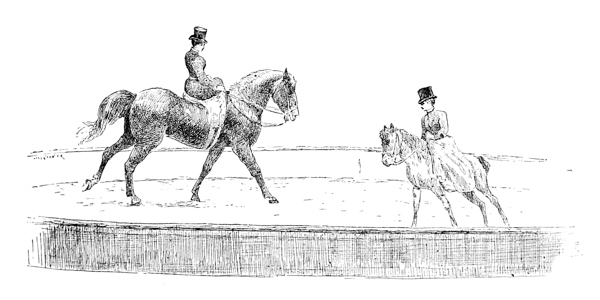
An equestrian, named Prince, was performing at the Cirque d’Été a vaulting act on two horses, which were leaping fixed bars. Suddenly one of the animals fell on its knees, and the man was thrown forward upon his head. The assistants at once rushed towards him and covered the body with a mantle. It was carried out, and M. Loyal, in a choked voice, but with a smile on his lips, came forward and said:
“It is nothing, ladies and gentlemen—a slight accident. M. Prince begs that the public will excuse him.”
The truth was that the rider had been killed on the [p182] spot—he had broken his neck. And whilst a number of clowns tumbled into the ring, reassuring the public by their jokes, Prince’s wife and children were weeping over his body in the great whitewashed room, where the reins of the performing donkeys were hanging on the walls side by side with clowns’ wigs, training whips, and spangled tights.
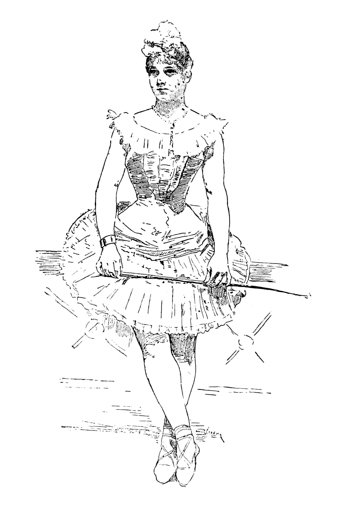

The re-opening of the Hippodrome and the first performance of its pantomime are a great event in each year; a festival for “society,” which for this occasion makes a large outlay in spring toilettes, and a festival for the Parisians of the “fifth floor” and the shop parlour too.
The number of those who cannot escape to the sea or the country during the heat of the dog-days, of those whom work and economy hold prisoners, is greater than one usually feigns to believe. During the whole summer these people have no other oasis of refreshment within a walk than the great hall with its movable glass roof, which gives the Hippodrome a ceiling of stars. It is important to those Parisians who from July to September will go at least once a week to the Hippodrome, to know that each time they will see the new pantomime with renewed pleasure. [p184]
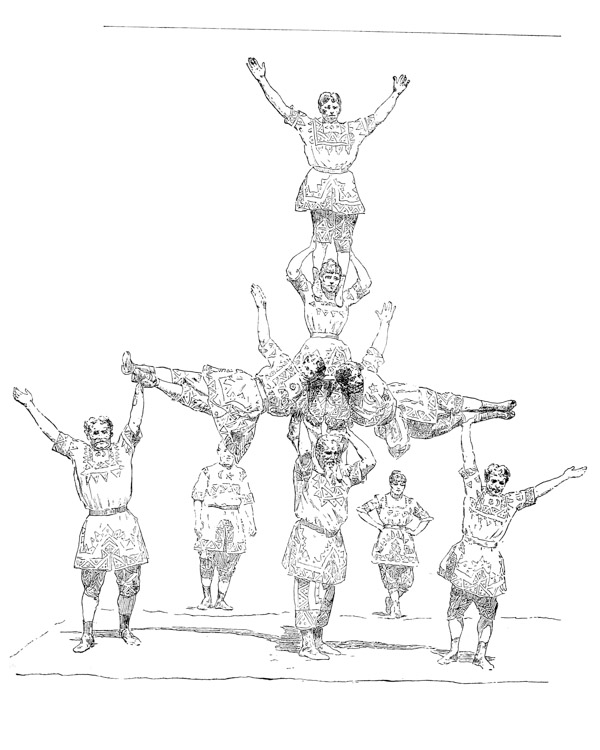
I have frequently overheard the following definition given by very superficial people: [p185]
“The Hippodrome is a circus, of larger size than the others . . .”
There are some degrees of ignorance which should be sent back to learn A B C D. On the other hand, some amateurs may be found who are convinced they are right because they do not quite know what difference exists between the two.
A circus is a circular arena of fourteen yards nine inches in diameter, surrounded by benches. Travel with a yard measure, measure the diameter of the Cirque d’Hiver, of the Cirque d’Été, and of the Nouveau Cirque. Cross the sea towards America, follow Barnum and measure across his arena, continue your journey round the world by exploring Australia and Asia; lastly, return to Europe by the Caucasus, raise the canvas of one of the numerous travelling circuses which erect their tents at Astrakan in the fair time—you will not discover the difference of a fraction of an inch from the rule of fourteen yards nine inches in diameter. Fourteen yards nine inches is the regulation size.
A superstition, perhaps?
Do not believe it.
The unvarying dimensions of the arena respond to a double necessity: the exigency of the man and the exigency of the animal.
You already know that the banquiste is instinctively nomad, both through disposition and interest. It is therefore most important that, although he continually changes his locality he should find the scene of his performance unvaried.
This rule is extremely convenient for men, but it is indispensable for animals. A performing horse must find, in whatever spot he appears before the public, a ring of fourteen [p186] yards nine inches sanded to a depth of three inches and a quarter, surrounded by a palisade opening in two places only, and low enough to enable it to walk round it, with the fore hoofs on the red cushion and the hind legs in the arena.

The Hippodrome is not restricted to these dimensions. Its arena is an elastic parallelogram, rounded at the four angles to assist the horses in turning. Its shape excludes all acts of equestrian vaulting, based upon the support given by the centrifugal force to circus acrobats.
It is not only the name but the principles of art which the Hippodrome has borrowed from Greece. No doubt the circus gives us an opportunity of admiring the human body, after the education of the ancients has restored it to the forms chosen by them for the eternal life of marble; but the purest lessons in Greek æsthetics are to be found at the Hippodrome. [p187]
You know that one of the most important differences which distinguish our conception of human beauty from that formed by Greek art lies in this principle: the subordination of the body to the head.
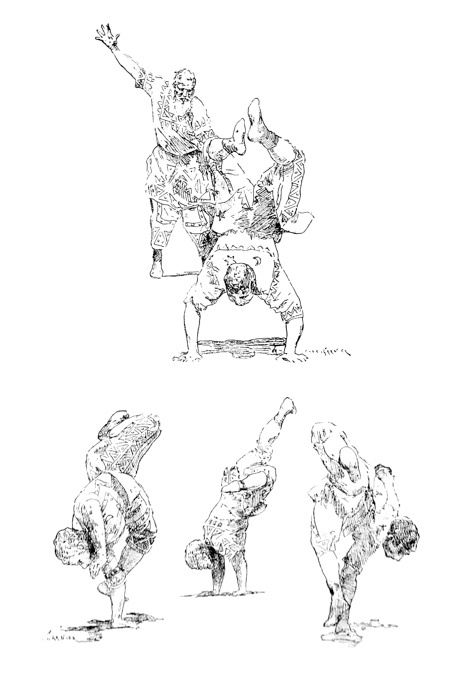
Christian civilization has taught us that we must seize [p188] every opportunity of mortifying and humiliating the flesh to secure the predominance of the superior and spiritual principle—the soul. No doubt the passions and emotions of this soul manifest themselves by gesture to some extent; but they are chiefly revealed in the expression of the face, of the mouth and eyes. Hence the preponderance given to the head, which, at the first appearance of Christianity, when the art of the ancients escaped from the Byzantine bonds, led the early painters to represent hydrocephalic Christs and angels, with the enormous eyes of batrachians, and emaciated, anchylosis, meagre bodies. Hence also the habit that we all have at the present time of judging beauty—and particularly feminine beauty, which is more expressive than the other—from the features of the face.
Greece never despised corporeal beauty in this way. She taught that if the soul be divine, the body is the temple of a god. And on the same principle that she decorated the houses of the Olympians, so that it might please them to dwell therein, she also commanded the body, the habitation of the soul, to be embellished by gymnastics. She placed the musikè, the tutor of the soul, and the gumnastikè, the tutor of the body, on the same level in the practical education of her heroes.
This is why the artists who embodied her ideal of beauty did not give more expression to the face than to the torso. Suppose that the Venus had lost her head instead of an arm; she would not appear more mutilated. One of the most beautiful legacies that Greek sculpture has bequeathed to us is a headless Victory.
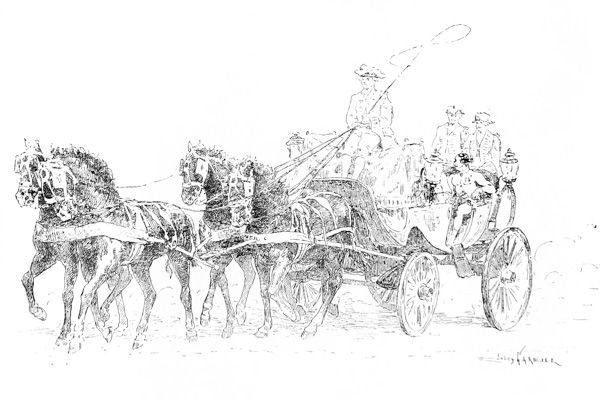
The immense extent of the Hippodrome prevents the [p189] spectator from seeing the details of the features, and transfers his habitual attention to the observation of the whole figure. I noticed this effect a short time ago, when watching the classic poses of a group of young Italian girls—the sisters Chiesi. To increase their resemblance to statues, and to produce as far as possible the illusion of nudes in marble, these young models wear tights whitened with flour. Thus moulded, the Chiesi mount upon each other, and pause in bold yet classic attitudes, which combine the poses of the acrobat and the academy. I did not for one second dream of looking at the beauty of their faces, not even when they were triumphantly driven round the ring under my eyes in the gilded carriage of the late Duke of Brunswick.
[p190]
This is an exceptional case. But given equal talent, we always prefer a woman’s performance to that of a man. It gives us, besides the peculiar pleasure which acrobatic feats always produce, the general pleasure which the exhibition of a perfectly-formed woman never fails to excite. And to us moderns this is not merely an intellectual and moral enjoyment; in it there mingles a little voluptuous emotion. . .
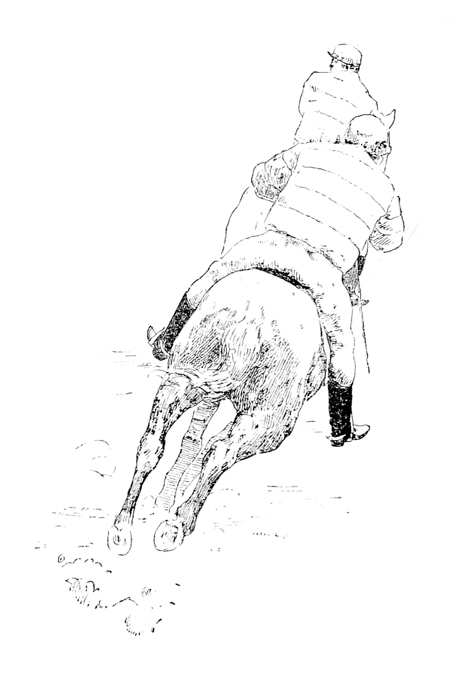
This fascination, which Greek art knew nothing of, does not affect us at the Hippodrome. The latent sentiment is [p191] in abeyance, like the pity which the Spaniards never feel at their bull-fights, probably because the arenas are too vast. A true pagan would probably congratulate himself upon the freedom from emotion which, at the Hippodrome, leaves him free to enjoy the essence of beauty. But we cannot all raise ourselves to the level of this Olympian indifference; we do not care to be cured of the pleasure we enjoy—contenting ourselves with deploring, like Théophile Gauthier, “d’être si fort corrompus de Christianisme.”
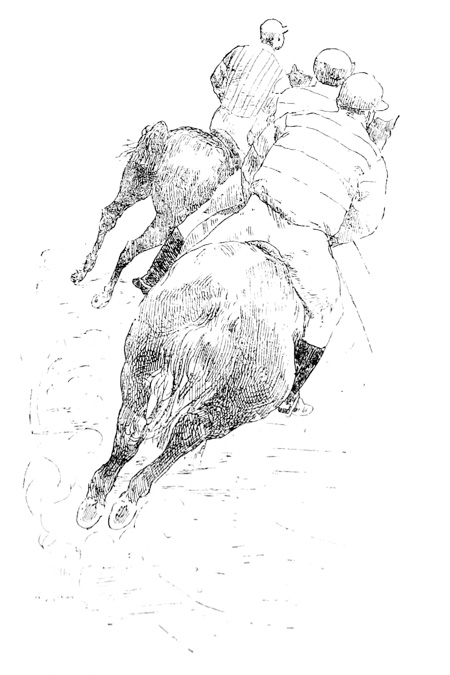
[p192]
The Hippodrome regains all its advantages when it leaves to the circus the exhibition of “expressive novelties,” which must be seen close at hand, and contents itself with its speciality of races: foot and horse races, chariot races, “Berberini races,” processions, and pantomimes.
The race of riderless horses is one of the most attractive spectacles one can possibly see, and it is easily understood why the Italians with their artistic genius elected to close the festivities of their carnival by this exciting contest.
Every one has read some descriptions of this hippique fête which so greatly delighted papal Rome. For a fortnight before the race the horses which were entered for it were led out every morning to accustom them to the course, and corn was given to them at the end of the Corso, near the winning post.
On the day of the race, at four o’clock in the afternoon, two cannon shots gave the signal. All the carriages at once turned out of the road, the spectators fell back into two lines, and a detachment of dragoons cleared the Corso at a rapid gallop. The murmur of the crowd died away into a profound silence.
The horses chosen for the race were held in a line behind a cord stretched towards the column of the People’s Gate. Their foreheads were decorated with plumes, which worried their eyes by waving in front of them; golden spangles were plaited into their tails and manes. Small copper plates and leaden balls armed with steel points were attached to their flanks and croups to goad them on their way; and the effort to frighten them even led to light sheets of tin and stiff paper being fastened on their backs, which, rustling and quivering, [p193] produced the discomfort of a rider without the drawback of weight.
Before the cord fell, the animals, impatient to start, excited by the crowd, uttered loud neighs, pranced about, and produced a clamour which filled the Corso. It frequently happened that one of them would knock its groom down and rush amongst the crowd.
At last the senator of Rome gave the signal. A trumpet sounded, the cord fell, the half-maddened horses started wildly, urged on by the applause of the people as though by whips. Usually the “Berberies” traversed the 800 fathoms of the course in two minutes twenty-one seconds, that is to say that they ran thirty-seven feet per second. In the confusion, if one horse could overtake the competitor which preceded it, it would bite it, kick it, and use every artifice to impede its progress. The arrival of the horses was announced by firing two cannon; to stop them carpets were extended across the end of the street.
In later years the Corso was only a speculation of the horsedealers. The Hippodrome revives the best days of this Roman institution; the epoch when the first families of Rome, the Barberini, the Santa-Croce, the Colonna, and the Borghese entered their horses for the race, the champions of their rivalries and of their colours. Since the managers of the Hippodrome object to injuring the valuable beasts they place in the arena, they have abandoned the practice of harnessing them with spurs and spangles. It is really bare-backed horses, free from all carnival disguise, which they produce in the lists.
The animals have been trained for a long time, placed [p194] before the barriers with a whip to urge them to jump, guided all round the ring by sentinels, who punished any deviation from the course.
Now they know what they are expected to do, and as soon as the bell rings they all start. They reach the barrier, their manes flowing in the wind, their hoofs flying, terrible as the tide, white as the surge which rises on the waves. Ἵππος μετέωρος, said Pindar, describing a horse rearing. It is a brilliant meteor which flies over the barrier, but it is also a crest of foam.

And the pleasure of watching these riderless races is augmented by the good faith, the honesty of the beast, which cannot be suspected of corruption, which strives for victory only. Neither crime nor death can stop them. M. Houcke has told me that he has known some horses to be killed in the [p195] ring by their jealous rivals, and others after the victory have died from fits of apoplexy when they had gone back to the stables.

If the riderless horse is superb, it is certain that the chariot, the ancient Greek chariot, immortalized by Homer, is the most æsthetic frame for it. The other day I read a commonplace remark from Madame Dacier, who has only, and quite justly, seized the meaning of words in Greek. “I do not understand,” she said, “why the Greeks, who were so wise, should have used the chariot for so long a time—why they did not see its great inconvenience. I am not speaking of the difficulty of managing a chariot, although it is far greater than of managing a horse; nor of the space occupied by it: I only say that there were two men to each chariot. These two men were important individuals, both fit for war. Yet only one of them could fight. Moreover, some chariots required not only two, but even three or four horses for a single warrior—another loss which merits attention.”
[p196]
The excellent Madame Dacier has forgotten one thing, that the Greeks were devoted to beauty before everything else. They liked the chariot, because the quadriga was a superbly æsthetic picture—a moving pedestal for the hero. So that the chariot was not only an engine of war in their eyes; it was an object of luxurious pleasure. Do you remember the beautiful descriptions of chariot-races which fill the literature of Greece, and particularly the plays of Sophocles?
Do you remember, amongst others, the account of the tutor of Orestes? For my own part, I never witness one of these heroic displays without the lines of the divine poet recurring to my memory.
“At sunrise the chariot-races took place. Orestes appeared, and with him many charioteers. One was Achean, another from Sparta; two came from Lybia, true masters of the reins. Orestes was fifth, with mares from Thessaly. The sixth brought light chestnuts from Etolia. The seventh was from Magnesia. The eighth, a son of Enia, advanced with white horses. The divine Athene had sent the ninth. Lastly, a Beotian mounted the tenth chariot.
“The heroes were standing, and when the lots had been drawn and their places were assigned to them, they sprang forward at the blast of the brazen trumpets. All together they raised the beasts; they shook the reins; the arena was full of the roll of their ringing chariots. And all mingled, confused, lavished the whip to pass by the axle of some opponent. And the breath of the horses, covered with foam, the backs of the drivers, and the wheels of the chariots. [p197]
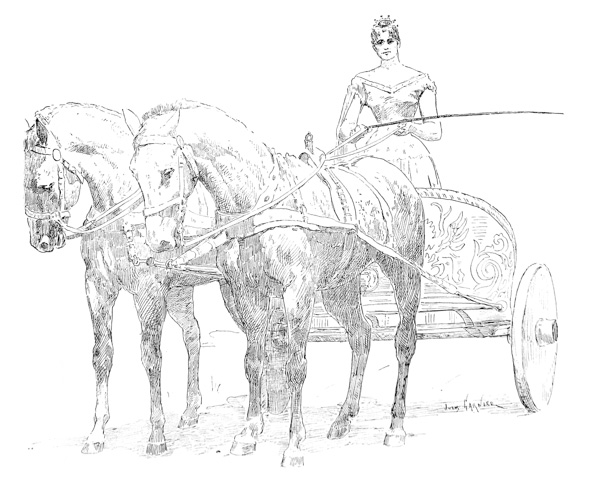
“When they reached the last post Orestes grazed it slightly with his axle. He slackened the reins, and gave the wheeler his head. With his right hand he restrained the other. . . . He was preparing for the finish of the race. But when he saw that only the Athenian was left, he made his [p198] whip whistle round the ears of his steeds, and sprang forward behind his rival. The two chariots rolled on in front. Alternately they passed and re-passed each other by the length of a head. Upright in his uninjured chariot, Orestes had successfully run in every race; but in giving the left rein to the horse rounding the post, he struck the column. His axle was broken; from the height of his chariot he rolled entangled in the reins, whilst the frightened horses tumultuously rushed into the arena.”
Pantomime—another ancient amusement—is the glory of the Hippodrome as well as the races. All who saw it will still remember the splendours of the Chasse. It seemed difficult to find anything more brilliant, for there are not many subjects which can be used for these grand spectacular shows. When a Roman Triumph has been displayed, a Nero with chariot races, a Fête amongst the Rajahs with rivulets of precious stones, an Arab Fantasia, a fairy piece, and a genuine Congo, the management must fall back upon military pieces. But we live upon former triumphs, and the Hippodrome dare no longer produce old-fashioned effects from its storehouses.
The embarrassment of M. Houcke the manager, who arranges his own plays, was therefore very great. The resources of a large place like the Hippodrome vary from one season to the other. Sometimes acrobats form the great novelty, sometimes a troupe of vaulting clowns is the central attraction. Lastly, the horses were there to be exhibited, so that the director found himself obliged to select a military pantomime.
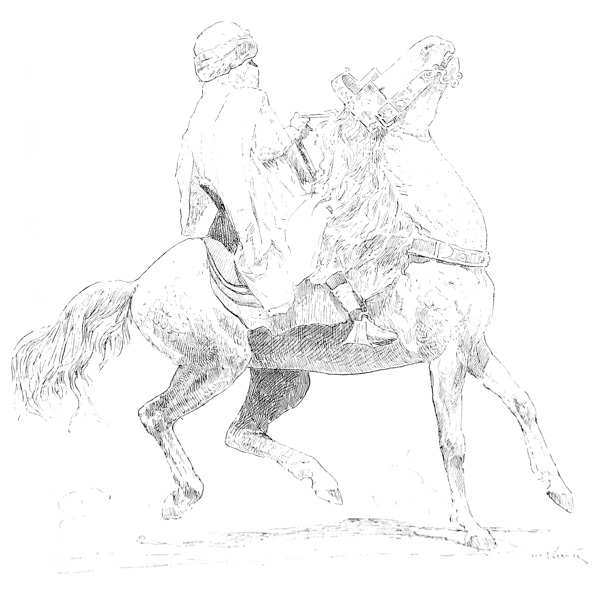
M. Houcke is a type, a true child of the stage. He has [p199] five or six brothers scattered through the world, all managers of riding establishments. His father, under the name of Leonard, was formerly proprietor of the Deux-Cirques before the Franconi. He has taken M. Loyal’s place in the ring in Russia, Germany, and Scandinavia. This will tell you, if [p200] heredity is not an empty word, that he is gifted with a large amount of professional genius.
Moreover—and this does not spoil it—Houcke is very knowing. His choice of the name of Skobelef, as the hero of his last military fête, appears to me an excellent proof of this acuteness. You may vainly search contemporary history without finding the name of any other victorious general who would command the sympathy of the Parisians. . . .
Skobelef and Plevna, the Russians and the Turks! Houcke had grasped his pantomime. The chief outlines of the plot were quickly arranged, and M. Thomas, the former decorator of the Théâtre Français and the Opera Comique, Houcke’s right hand man left for Russia, with a great deal of money in his pockets to buy weapons, costumes, sledges, moujiks, drovskies, and snow.
He returned with all Russia in his trunks.
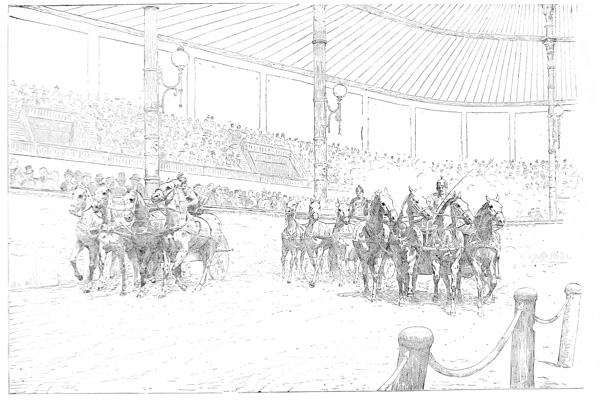
Picture to yourself, from one end of the arena to the other, a parquet floor laid down, over which sledges and skaters glided as though upon the Neva. In the first tableau the parqueterie represented a high road, a post-station in the steppe. The orchestra, which had reinforced its musicians by a choir of genuine moujiks, was suspended above the buildings of the Isba. The good people sang with those deep voices which Agrenieff had already enabled us to hear, in their national songs, some years previously at the Trocadero. They were placed in a suitably decorated gallery, and when, accompanied by bells, the moujiks chanted their national hymn—
Bojé tsara krani
Silni der jarni
Stsar stvouyna slavouna, slavounam. . . .
one [p201] really felt carried far away on the wings of the music. During the singing I looked over towards the third places, filled with the poorer people, who are less sceptical than the others. Many of them were quite touched, their eyes were glistening, their breasts heaving. . . .
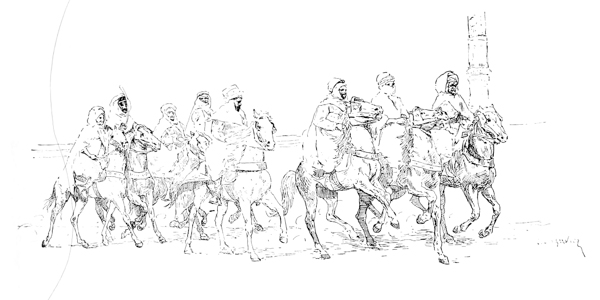
Whilst the bells and the moujiks were singing in unison, the processions commenced to pass over the road. First came the singers and wandering dancers, who followed the army to the scene of war; then groups of officers, convoys of prisoners, the fantastic gallop of an orderly; then, with a bustle, a troïka, containing a tall man enveloped in a grey pelisse. This was Skobelef, who had arrived to take command of the army.
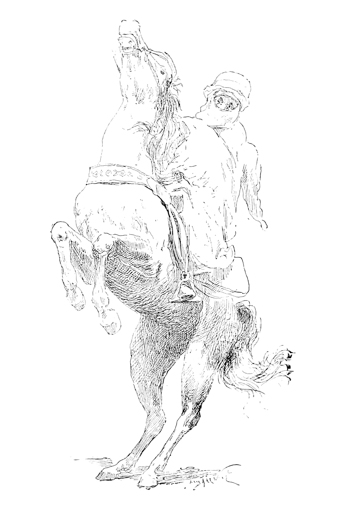
Then we were transported before Plevna. The country people were taking refuge in the town, carrying all their wealth in their carts. They were just in time! the Russian soldiers were at their heels! But they are only scouts. The Turkish sentinels have seen them from the walls of Plevna. [p202] The alarm is given. A sortie is made, and they are surrounded. Their case is not quite clear; their reconnaissance has a fatal look of spying. The Turks prepare to shoot them, when a thundering gallop shakes the floor. The Cossacks have arrived at furious speed to rescue the prisoners. Ah, the brave men! I always thought that a candle diet developed heroism. With the thrust of a lance, the [p203] Turks are properly settled; a few of them run away in great style, and succeed in re-entering the town. They merely postpone the moment of surrender, for the whole Russian army is advancing. It rushes to the assault of the practicable places in the fort. In the midst of the engagement and smoke the whole end of the Hippodrome becomes [p204] illumined with the lurid light of fire. Vive Skobelef! vive Ruggieri! Plevna is burning! Plevna is burnt!
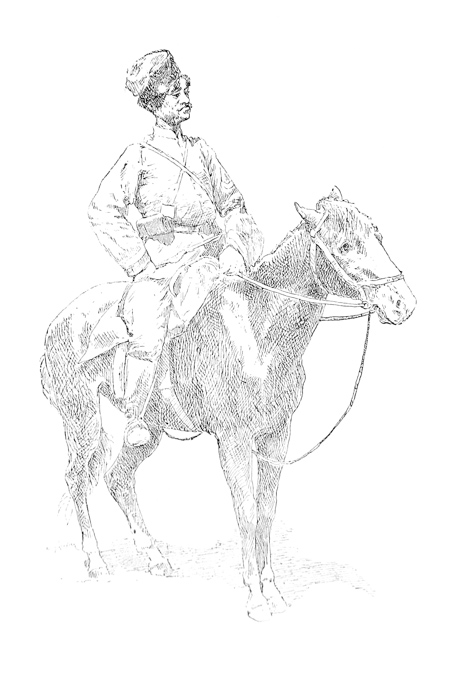
And the victors have nothing to do but rejoice!
In a moment a painted canvas has been unrolled round the arena, which represents St. Petersburg in perspective; the parqueterie has changed into the frozen Neva. The whole town has come out to greet the victorious soldiers!
A fine evening for skaters!
With the point of their skates, on the ice, in English, in Italics, in Gothic, they write the name of Skobelef. Lamps suspended to the arches reproduce the glorious word. The sound of the clarions and fifes playing the triumphal march is already heard.
The moment has come!
The leader of the orchestra lowers his baton.
One, two, three!
And as though the whole army, the whole people had been stopped spellbound at this signal, the cannon thundered, the orchestra bellowed, the fireworks, are let off, the bells ring, and high above all the clamour the national hymn rises for the last time—
BOJÉ TSARA KRANI.
Although Buffalo Bill’s company has not appeared at the Hippodrome, this seems to be a fitting place in which to chronicle the magnificent equestrian spectacle with which they have delighted the Parisians during the Exhibition.
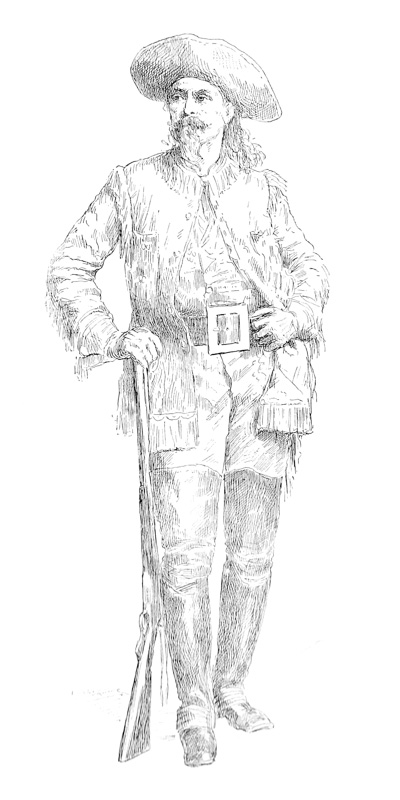
The innumerable readers of Cooper’s American novels have seen the prairie of the Sioux transported, with its actors and its decorative accessories, to the Porte Maillot. All were there: the Red Skins—genuine Red Skins, the mustangs, [p206] buffaloes, cowboys, vaqueros, waggons, tents, bows, arrows, rifles, dogs, squaws, and papooses.
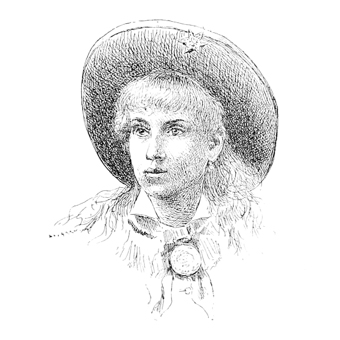
This extraordinary troupe was taken to Paris by Nael Salsbury, a manager who is celebrated in every English-speaking country. It is commanded by an extraordinary man, Colonel W. F. Cody. Picture to yourself the most perfect type of trapper that you can imagine after reading The Spy and The Mohicans. Born on the frontier, brought up on horseback, of chimerical courage, and unequalled skill in the management of horses and firearms, Colonel Cody is six feet high, and this fine body is crowned by the head of a stage musketeer. His curling hair falls upon his shoulders, and he has the moustache of an Aramis beneath the straight classical nose of an American.
Colonel Cody’s warrior troupe has its female star, Miss Annie Oakley, called the “infallible little shot.” She is also a child of the frontier, where her name is as much feared as her bullet. And in fact she has accomplished wonders. One [p207] day at Tiffin (Ohio) she hit a fifty-centime piece held between a man’s finger and thumb at a distance of thirty feet.
In February, 1885, she fired at 5,000 glass balls, which three projectiles threw up for her fifteen yards high; she broke 4,772 of them in nine hours, although loading the guns herself.
Miss Oakley manages a horse quite as well as a gun.
At a New Jersey fair she won four races out of five.
“And Miss Oakley is rendered still more interesting,” says a biography from which I am copying, “by the fact that she is short, and only weighs 106 lbs.”
Not one word more.
The young girl is still unmarried.
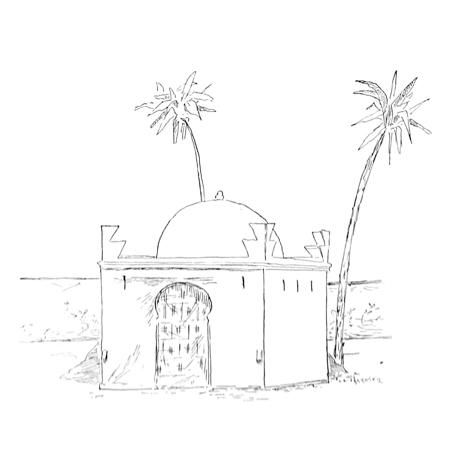
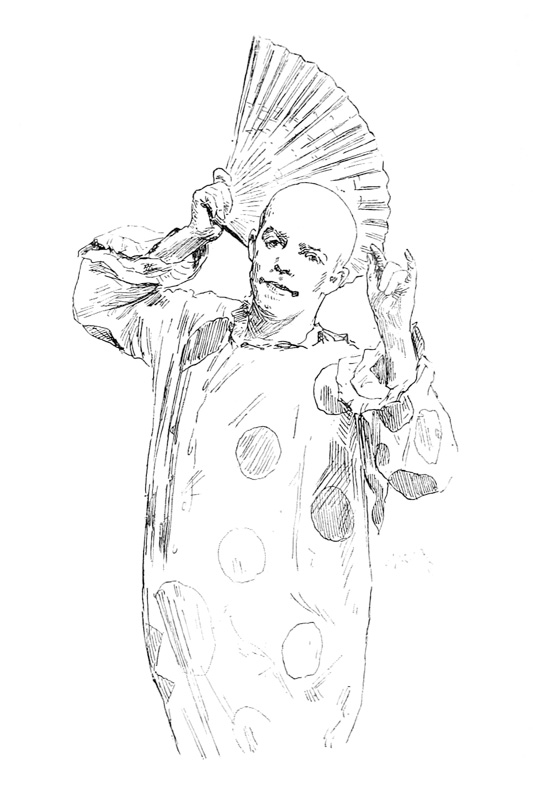
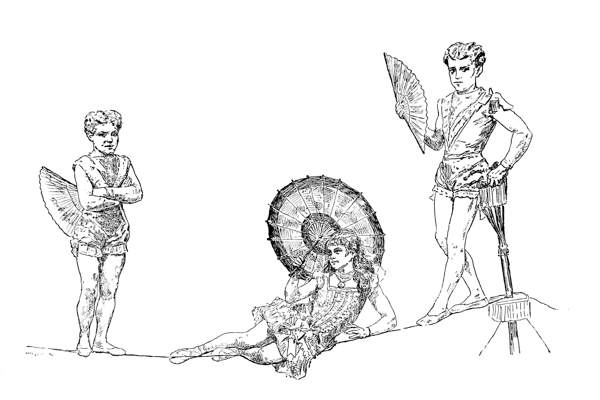
The equilibrists are the most artistic acrobats, the true Olympians.
The gymnast excites our admiration by the marvellous development of his thorax and limbs, and by the epic relief of his muscles. The equilibrist does not require the same effort in his work. The beauty of the performance lies in the delicacy, variety, facility, and grace of the artist’s movements, and on this account women excel as equilibrists, for men cannot reconcile themselves to the suppression of their [p210] strength in the feats they achieve, and therefore take a second rank in equilibrium.
They prefer special branches of the art, and are usually jugglers, bicyclists, or antipodeans. . . .
A proverb is current behind the scenes of the circus, to the effect that love destroys the centre of gravity in tight-rope dancers, and as a rule equilibrists—that is to say the true artists, not the pretty girls who use the cord as a springing-board—might rank with the Roman vestals. Their reputation is their fortune, and they are carefully guarded by their parents. It is not only a question of averting the danger of maternity, which ends the artistic career of an equilibrist. No risk must be encountered of anything that could damage the artist’s health; and, therefore, those who are particular on these points can enjoy the performance of an equilibrist without any uneasiness about her private life.
The children of acrobats are equilibrists and jugglers from their birth. Stroll into a circus some morning during rehearsal, you will see all the corners filled with boys and girls, who, on every tightened rope and round the iron bars, are imitating the paternal exercises for their own amusement. I remember, one day in London, witnessing a curious scene in a seventh-floor garret. Under the roof two cords were stretched across the attic; a young boy was practising walking on one of them without a balance; on the other a monkey was faithfully copying the gestures of his companion. The professor had probably gone out to buy some tobacco; in his absence the two dancers silently continued their parallel work. I can tell you that acrobats learnt the value of mutual instruction before the schoolmasters! [p211]
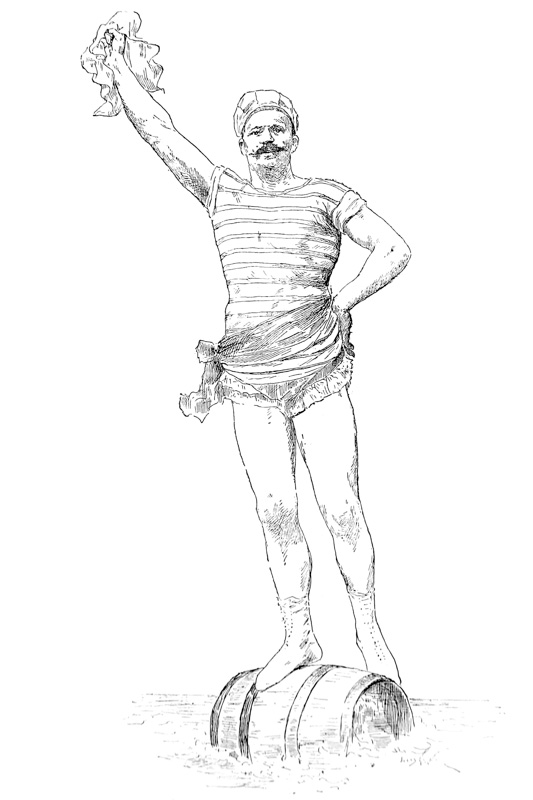
The lowest step of equilibrist art is the globe performance. Walking upon the rolling ball, forward or backward, vaulting [p212] and dancing upon it, are the A B C of the profession. This old-fashioned accomplishment is, therefore, never used, unless some new invention is added to increase the difficulty.
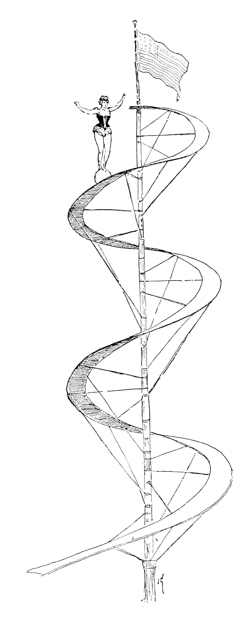
This has happened with Lady Alphonsine and the Russian Frankloff, whom we saw walking upon the water at the Neuilly fête, standing upon a ballast-tub, which he rapidly turned round with his feet. Lady Alphonsine ascended a small spiral upon her globe. It resembled the winding turn upon a screw, and was twisted round a mast fifteen or eighteen feet high. The ascension is not so bad, but I assure you that the descent gives you some trouble. It is necessary to restrain the enormous wooden ball, always on the verge of escaping, and the feet patter frantically, vibrating like the sounding-board of a mandoline. Here the effect produced is out of proportion to the exertion forced upon the artist; and this performance has another inconvenience: if [p213] it be continued for too long it spoils the shape of the leg by undue development of the calf—two reasons why the globe should not be reinstated in the esteem of the public.
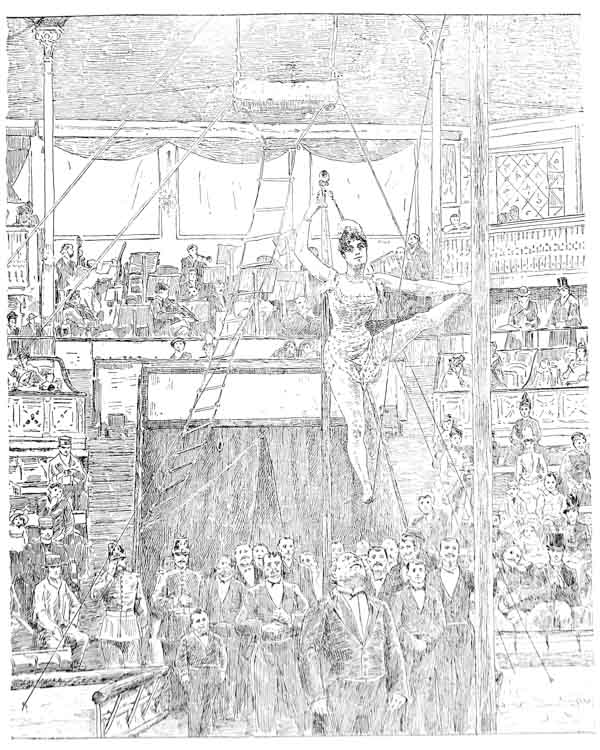
However, here as elsewhere, fashion rules the world, and tight-rope dancing, after falling into abeyance for a time, is now apparently returning to favour.
If, some fine morning, we may find ourselves globe spiral ascensionists with little previous exertion, no one can become a tight-rope dancer without much patient labour. You see how easily the rope-dancer runs across her narrow path, and may feel tempted to say, “Really, it only requires nerve to do as much.” But it is a pity that, for your own edification, you were not present at the artist’s first experiments.
All the strength of the dancer lies in the back and in the rigidity of the legs. On this account children cannot be placed upon the cord before they are ten years old. The apparatus used in these performances is very simple, and has not changed since antiquity. The cord is raised upon “croisés,” two crossed sticks, at each end, which form two ╳ of different size. The ╳ at the back is the highest, so that it may support the back of the dancer during the intervals of rest. The second ╳, or “croisé de face” which bears the “guidon” or object of sight, from which the dancer never moves his eyes, is not higher than the cord, which is attached at each end by cross bars of flexible wood. In Europe we use the ash, but the Americans use a still more pliant wood, the ixry.
The whole apparatus is fixed by an arrangement called a “cadrolle” of pulleys. The first time the dancer attempts to cross the cord he is supported by straps on either side. [p214] With the balancing-pole carefully held in both hands, his eyes fixed upon the point of sight, he endeavours to turn his feet out as much as possible, treading first on the heel and then upon the great toe. After a few months’ practice he can dance the “sabotière” which does not wound his still tender feet. The other exercises which he must slowly acquire are the walk forward, the walk backward, the dangerous spring forward, the dangerous spring backward the horse spring, and the art of springing from one foot to the other.
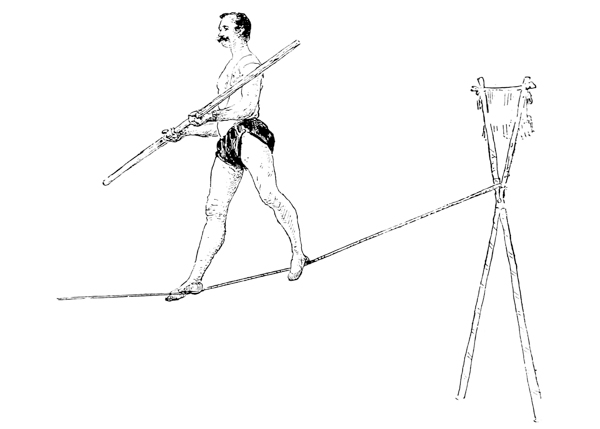
This is the classic series of exercises. When the dancer has once mastered them his own imagination must aid his performance. He must attempt some new feat upon the cord that no one else has yet tried, and this “novelty” is [p215] more difficult to find than you would suppose. Artists like Ada Blanche, who inherit the talents of Madame Saqui and Blondin, have a right to repeat La Bruyère’s melancholy words, “We have come too late.”
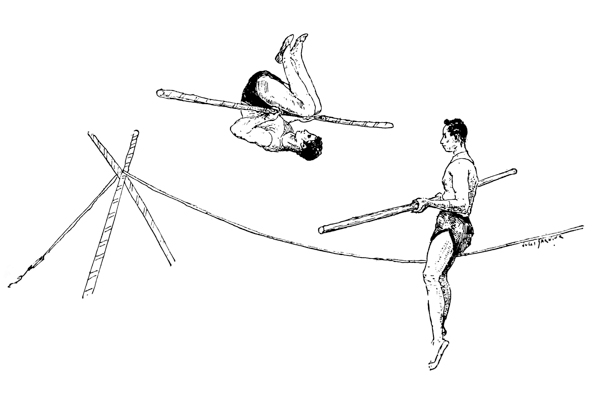
I have purposely given very little space in this book to former artists. The skill of our living gymnasts, acrobats, equestrians, and clowns, prevents our regretting the dead; but amongst the arts practised in the circus, that of the equilibrist has been in vogue longer than any other, and it is also the most limited in its resources.
It is therefore expedient, Saqui, to place your charming picture in this place, who forced the Great Emperor to raise his eyes to watch your aerial exploits, whom he called his enragée, whose chimerical daring he secretly admired for its [p216] resemblance to his own audacity. The astronomers of our time, less gallant than the ancient poets, have not yet placed you amidst the stars; yet, on the other hand, I fear that you have not been received into Paradise: for, little pagan, you once desecrated the sacred towers of Notre Dame with your little sabots. May this sin be remitted some day! I know, in one corner of Paris, an old centenarian Italian woman, who still has masses said for the repose of your restless soul, and believes that in expiation of your pride you are condemned to wander for two hundred years between heaven and earth, without any amusement except that of playing with the rainbow as a hoop when there is no storm.
The pleasant memory of this peri is closely allied with the name of Émile Gravelet, called Blondin. Is there any place in the world where the famous crossing of Niagara has not been spoken of? The two Americas hastened to see the feat, and every day Blondin added some novelty to his performance. Sometimes, seated on a little chair, he would cook an omelet upon his cord, and eat it amidst shouts of applause. Sometimes he took his son on his back and ran from one bank to the other. One day Blondin caught sight of the Prince of Wales amongst the spectators. He was presented to him, and proposed that the Prince should make the journey across the Falls with him. His Royal Highness alleged that his rank obliged him to remain on the bank.
This offer was one of Blondin’s favourite jokes.
Pierre Véron told me that on the day that the rope-dancer crossed the Seine he suggested to Cham, who had come to make a sketch, that he should cross with him. [p217]
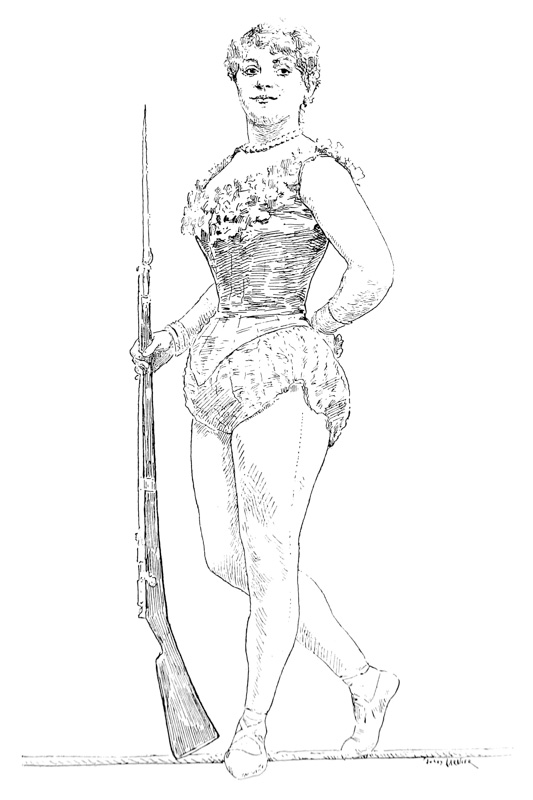
“I am perfectly willing,” replied the caricaturist, “but I will carry you on my back.”
“Nonsense! Monsieur Cham, you cannot think of doing that!” [p218]
“You see you are the one to refuse,” coolly answered the unsmiling jester.

The sudden discredit into which rope-dancing has fallen during the last few years dates from the appearance of Oceana.
This young woman, anxious to adopt a “novelty” which [p219] would exhibit her beauty without too much exertion, chose a wire, which, hanging slacker than the cord, enabled her, with a little oscillation, to assume the attitude of reclining in a hammock, the voluptuous indolent postures of Sarah la baigneuse. But the genuine rope-dancers at once determined to reproduce all the exercises of the cord upon the wire, which Oceana had so easily brought into fashion, and, with the exception of the horse-spring, they can all be performed upon it. The difficulty of preserving the equilibrium on a support that is even more unstable than the cord delighted the equilibrists.
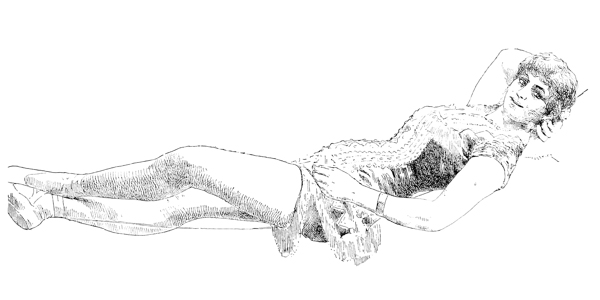
A young Oriental, Lady Ibrahim, in the winter of 1888, at the Folies Bergère, showed us the advantages a clever equilibrist could derive from the flexibility of the wire.
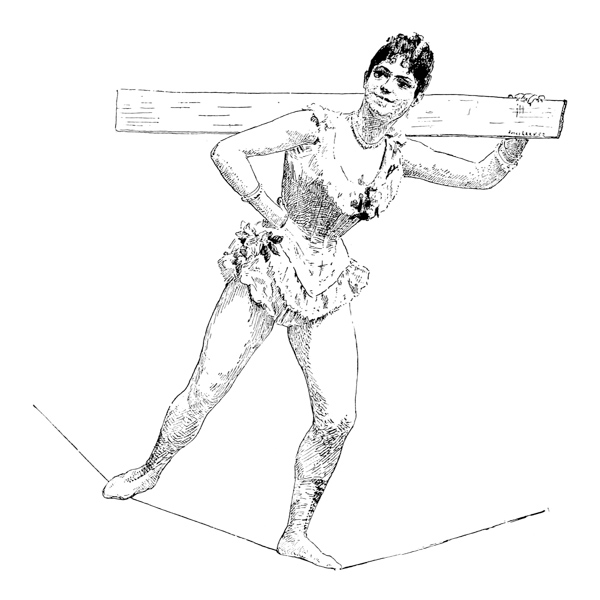
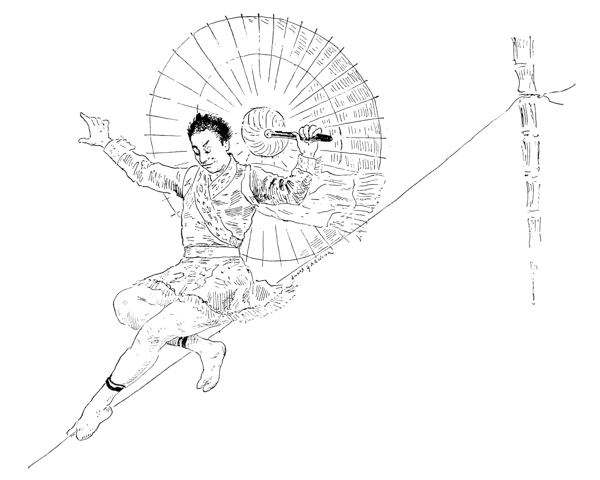
A little too tall, with the almost thin arms of a dancer, she allowed herself to be raised by one hand to a rather high platform, from which she started, far above all heads. Once there, she opened a Chinese parasol, which she used as a balance; then, with a very serious expression, an anxious [p220] rigidity of the whole face, her eagle eyes fixed on the point of sight, she stepped upon the wire, which, brilliantly plated with nickel, looked like the slippery floor of a skating-rink under her feet. When she reached the centre of her wire, Lady Ibrahim caught a steel hoop in its flight; for one second she placed it behind her head; it was the starlit night: then she slipped it over her head, and slowly, with graceful precautions, she made it glide down the whole length of her [p221] body to her feet. Some flags arranged in a small wheel, so that their folds waved as she moved, afterwards replaced the parasol in her hand, and then, suspended between the draperies of undulating silk, Lady Ibrahim violently swung herself from right to left on one leg; suddenly she closed her feet, raised herself in the air on the points of her toes, turned, and went towards the back croisé. The performance was crowned by a promenade on a plank balanced on the wire. Lady Ibrahim repeated upon the plank the various exercises that I have already described, until at last, amidst loud [p222] applause, she picked it up and carried it off upon her shoulder.
The wish to conquer increasing difficulties has raised the equilibrists from the slack wire to the trapeze. The danger of this work lies in the instability of the support. The slack wire and cord are less steady than the ball; the trapeze, although weighted by lumps of lead at the ends of the two cords, oscillates perceptibly more than the cord.
It is like a thoroughbred, a nervous, supple, and rebellious horse, which must be mounted with infinite care and delicacy of movement. Therefore the equilibrists who have once tried the trapeze will never abandon it. Through the meshes of their net they disdainfully look down upon the poor slack wire-dancers, who are with difficulty raised two yards above the sand of the arena by the croisés.
Globe, cord, slack wire, trapeze—this is the complete cycle, and we have already seen that these graceful exercises are performed chiefly by women. A man has not the same æsthetic reasons for exhibiting his body in a work which provides no use for his masculine strength, and he therefore rarely leaves the “carpet;” he is a juggler or an antipodean. All the banquistes juggle, and all their children too. It is their leisure work between the exercises that exhaust their strength. They sit in a corner, pick up whatever is near their hands—a key, an orange, a stone—and throw them into the air. But daily practice is necessary before they can surpass the average skill and attain the dexterity which excites our wonder on the stage.
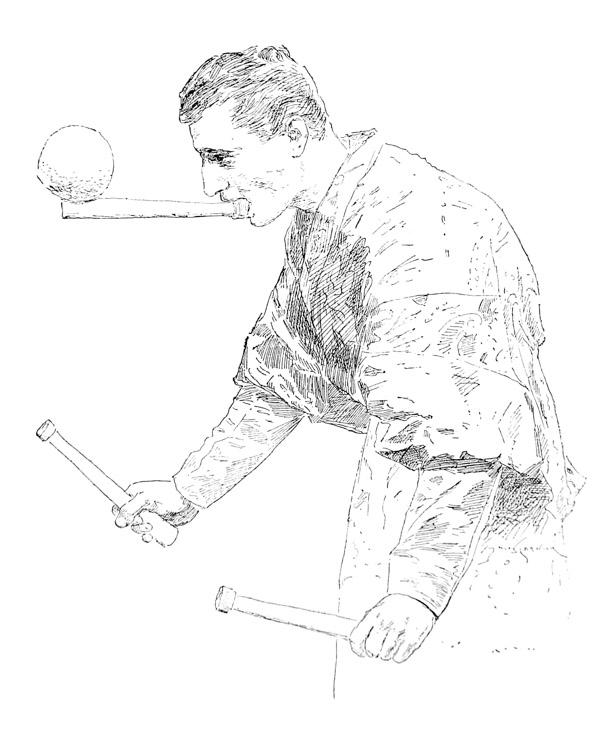
The true juggler, who is usually left-handed, never juggles on horseback, nor on a cord or trapeze; he performs with [p223] balls standing on the ground. This is a speciality of the Japanese. One was seen this winter in drawing-room performances whose dexterity approached sorcery. He only used a large white ball and a small red one, but in his hands they seemed like living things. They ran over his face, up [p224] and down his arms, and stopped on his nose or the tip of a finger.
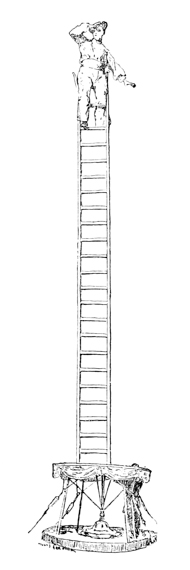
Our friend Agoust was celebrated in America as a juggler before he became a comic clown and manager of the Nouveau Cirque. I have seen him juggle simultaneously with an egg, a ball, and a bottle of champagne; and this is a miraculous feat, through the difference in the muscular effort required in throwing back each object as it falls into the juggler’s hand.
The Dane Sévérus is also one of the present celebrities of carpet equilibrism. He appears on the stage like Hamlet, in a black velvet tunic. One expects him to commence the monologue spoken on the terrace of Elsinor. No. He orders a small velvet chair to be brought to him, and perches himself upon it head downwards, feet in air. But he has first balanced a lighted lamp, with its glass and globe, upon the nape of his neck. He then moves it forward upon his skull by tiny jerks of the skin of the hair. It reaches his forehead; from there it travels down his profile, and finally descends to his chest.
This Sévérus has made a speciality of juggling with fragile objects. He replaces balls and knives by basins, salad-bowls, lamp-glasses, and plates of all sizes. [p225] Whilst seeing his performance one cannot but regret having left the cook at home, instead of giving her one good lesson in the art of skilfully handling a dinner-service.
Sévérus has a remarkable iron arm. The biceps of the arm develop very strongly in jugglers, and the crural muscles attain an extraordinary expansion and strength in the antipodeans.
The banquistes use this term for the jugglers who work with their legs. For instance, the Japanese Yotshitaro and the Mexican Frank Maura.
I have seen Maura perform one of the most extraordinary bounds that I ever witnessed on the stage. It did not excite much applause from the audience, who little suspected the immense force of the exertion. Frank Maura knelt at the edge of the stage, seated himself upon his heels and crossed his arms, then, without assisting himself by one movement of the bust, by one effort of the loins he threw his body into the air, and did not return to the ground until he had completed the revolution of a dangerous somersault.
After seeing the performance of this antipodean, one can understand the wonderful vigour of his muscles.
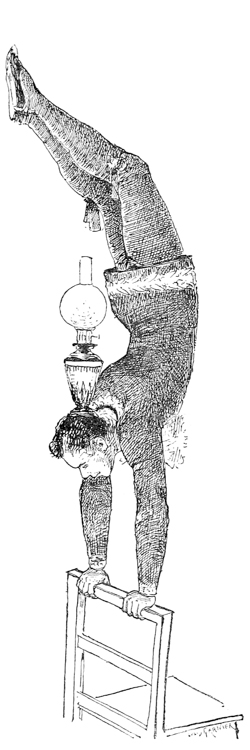
Frank Maura places in the middle of the theatre a metal handle about two yards high, which supports a small saddle. The equilibrist balances his shoulders and nape upon it, and then raises both legs at a right angle. An assistant throws to him successively three enormous balls, a barrel, and a bench long enough to seat six persons. Maura catches these objects, throws them into the air, recatches them, passes them from his hands to his feet, turns them violently round and then suddenly stops their rotation from time to time. [p226] With this extraordinary strength the faculty of “prehension” is so curiously developed amongst antipodeans, that many of them can pick up a ball or an orange with their feet, and throw these objects, like a projectile, towards a given mark.
We must add to the group of equilibrists two classes of acrobats, whose appearance in the Hippodrome dates from the grand spectacular pantomimes which rendered it necessary to cover the arena with a parqueterie floor. These new comers are bicyclists and skaters.
The bar used to guide the bicycle was certain to attract the attention of the equilibrists sooner or later, and we can understand how the idea suggested itself of reproducing upon this unsteady support some of the exercises which the gymnast performs upon the fixed bar. Since the number of these borrowed “acts” is necessarily very restricted, the wish to introduce variety into his “novelty act” led the bicyclist to add a companion to his [p228] performance, who springs upon his shoulders whilst he is in motion, and executes there some of the acrobatic feats which the pad equestrians perform in the pas de deux.
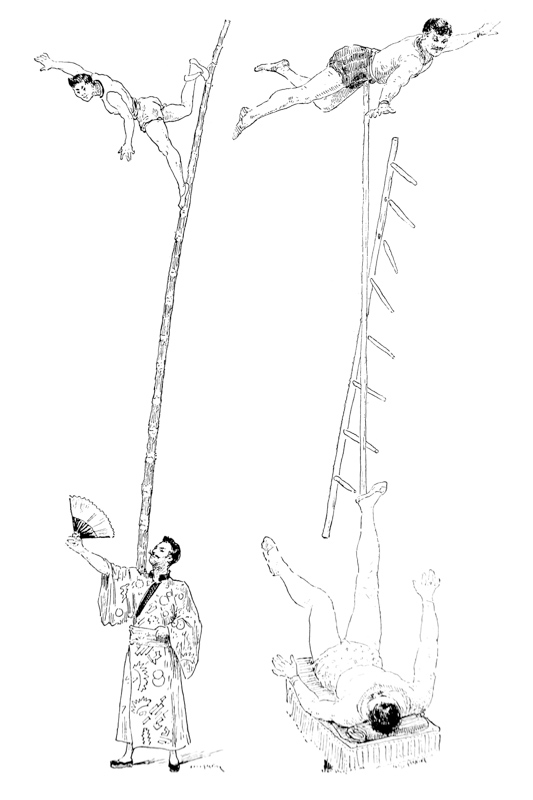
The summit of the limited performance possible on a bicycle is attained when the artists attempt on a monocycle the exercises which are now frequently seen on the two wheels.
As for the skaters, they appear upon the parqueterie in order to provoke laughter by their falls; their performance belongs to comic acrobatics.
You who in former days have tested the asphalte of the Skating Rink in the Rue Blanche, with your shoulders, back, and knees, are well acquainted with the horrible sprains which followed your attempts.
The clown-skaters have found means of avoiding those inconveniences by the suppleness of complete dislocation. At the same time they make great capital out of the natural perversity which impels us to laugh at our neighbours’ falls. I shall not astonish you when I tell you that these comic equilibrists are looked down upon by “professionals.” They are held a little aloof, and are regarded as entertainers rather than artists. For they have not been forced to conquer an enemy in whose defeat lies all the glory of an equilibrist—the vertigo.
Can we say that the equilibrist is really victorious over the vertigo? After much observation I am convinced that it would be more accurate to write that the vertigo conquers the equilibrist.
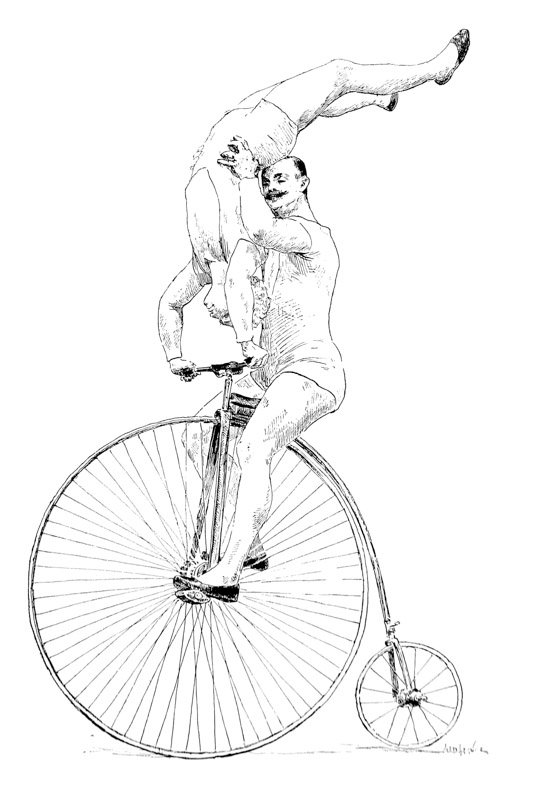
You all know the experiment which plunges a hen into a state of immobility and renders it more or less completely [p230] insensible by placing its beak upon the ground and drawing a straight chalk line towards which its eyes forcibly converge. In the same way, if any one take a brilliant object between two fingers and hold it a few inches from the eyes and a little above the forehead of a somewhat nervous person, first engaging him to look at it fixedly and to concentrate his attention on what follows, there is every chance of sending the person who is victim of the experiment into an hypnotic sleep.
The series of phenomena which then take place are familiar to all:
First, the eyes water a little through the fixed gaze, the pupils dilate and contract alternately, the members become extended, rigid, in some degree cataleptic. . .
Now recall the succession of acts which the equilibrist accomplishes in his work. He too, fixedly, obstinately gazes upon a single spot—the point of sight. All those who perform upon the cord have acknowledged that the same peculiar phenomena are produced at the end of the first seconds of this intense gaze; the equilibrist feels a sensation of absolute isolation, and at the same time a curious attrahent feeling towards the point of sight. In this nervous state the muscles assume a species of rigidity which assists the acrobat in his work.
Must we then conclude that the phenomena found here border upon hypnotism? This is a delicate question. I know that it will soon be laid before the Académie de Médecine by two clever savants of the Faculty of Montpellier. I commend these remarks to their attention, for they may feel some interest in them, owing to the difficulty which impedes close [p231] observation of these wandering artists, whose confidence is so hard to win.
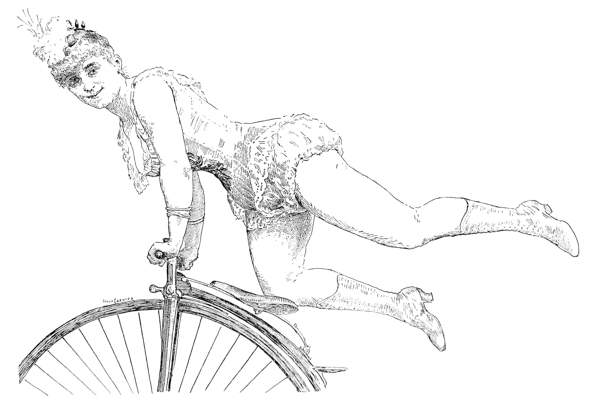
Those who study this question of hypnotism amongst equilibrists should notice:
1. That as a rule they are female subjects,
2. That the most skilful equilibrists come to us from the land of the fakirs, from India, Japan, the East;
3. That all the European subjects that attain exceptional dexterity are at least neurolopathic. [p232]
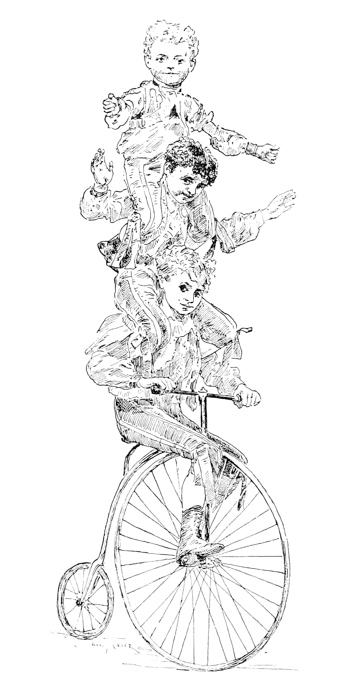
To quote but one instance: Erminia Chelli, the queen of equilibrists upon the trapeze, is a natural somnambulist.
From May till July, 1887, Paris possessed this charming [p233] young girl at the Cirque d’Été, and her departure has left us inconsolable.
I shall never forget the emotion which her performance caused me at our first meeting.
I at once begged M. Franconi to introduce me to her father.
M. Chelli and I exchanged cards.
I have copied the document here as an extraordinary monument of acrobatic and paternal pride:
The wife’s card said “Madame Mère.”
Erminia Chelli is not more than nineteen; she is a Venetian, and by lengthening her legs in the trapeze she has acquired the supreme grace in walking, the elegant proportions, which are usually rather lacking in Italians The bust is youthful yet charming, the neck delicate; the little dark head is proudly carried upon shoulders which the trapeze has rendered supple without unduly developing the shoulder blades. Since the appearance of Oceana no one of such perfect proportions has been seen in either of the circuses or the Hippodrome. The beauty of Oceana was, perhaps, a little more individual and original; but Erminia is better bred and more typical. [p234]
“She is her father’s pupil,” Madame Chelli, her mother informed me, as she assisted Erminia in putting on a large pelisse. “She began to appear in public when she was quite a little girl. . . .”
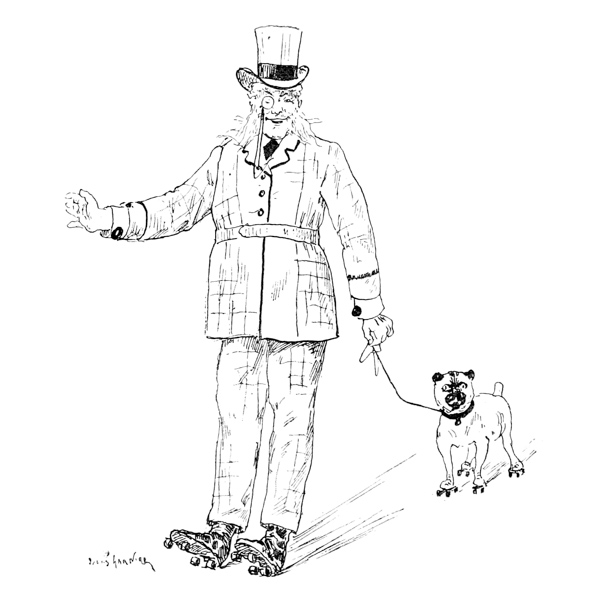
As she spoke an equestrian came in to tell them that the net was being prepared for Mademoiselle Chelli’s performance.
Erminia threw off her mantle, and with the caressing tones [p235] of a young girl, a little seriously and gravely, she went up to her mother and put her arms round her neck:
“Addio, mamma,” she said, kissing her.
A little surprised, I inquired:
“Is this a superstition, Madame Chelli?”
“No one knows,” the mother answered. “It has been her custom since childhood.”
Truly, in spite of the net extended beneath her, she might well be excused, poor little girl, for having one moment’s uneasiness whenever she was fetched for her dizzy work on the trapeze.
For one whole month I strained my neck watching her extraordinary performance in the friezes. Without the assistance of her hands, which she used as a counterpoise, she bent low enough to pick up with her teeth a handkerchief laid upon the trapeze. She mounted a ladder which was only poised upon the round oscillating piece of wood. Lastly, she balanced an immense ball still upon this frail support, and then, without leaning upon anything, she mounted upon it. And thus, lost in space, the globe beneath her feet, she seemed, the little acrobat, so beautiful, so unconscious of danger, like a goddess travelling through the air with the earth for a movable pedestal.
The enthusiasm with which I had praised the beauty and talents of Erminia Chelli in several newspapers procured for me at that time the letter which I reproduce here with great pleasure. It is from a literary man, and throws a genuine light upon the customs of some of those acrobats who as a class are so misunderstood by the public. [p236]
“Sir,
“The article in which you allude to Mademoiselle Chelli recalls to me a souvenir which I have much pleasure in relating to you.
“Three or four years ago the Chelli family came to Vichy and took part in the performances at the Eden Theatre. The father went through some acts of strength and equilibrium; the daughter was commencing on the flying trapeze the work for which she is now distinguished. The mother watched them both, admired them, and trembled.
“At that time the child, who might have been fourteen years old, already placed a ball upon a movable trapeze, steadied it as far as possible with her feet whilst holding by the cords, then loosening her grasp of the cords, she rose, bowed, stood upon one foot, and threw kisses to the crowd, visibly directing some of them towards her mother, who usually occupied the second chair in the second row of the orchestra stalls; the first chair being reserved for the child, who came back to her mother as soon as her performance was over.
“My usual place was in the first chair in the first row. I soon began to talk to the mother and her daughter, whose modest manners and childish affection for her parent were perfectly free from all affectation, and attracted me immensely.
“One evening I ordered a bouquet to be thrown to Erminia as she left the trapeze. On the following day I asked her mother if this attention, which the audience warmly applauded, had pleased her daughter.
“‘Oh! yes,’ she said, ‘and this morning Erminia carried it to the Virgin’s chapel.’ [p237]
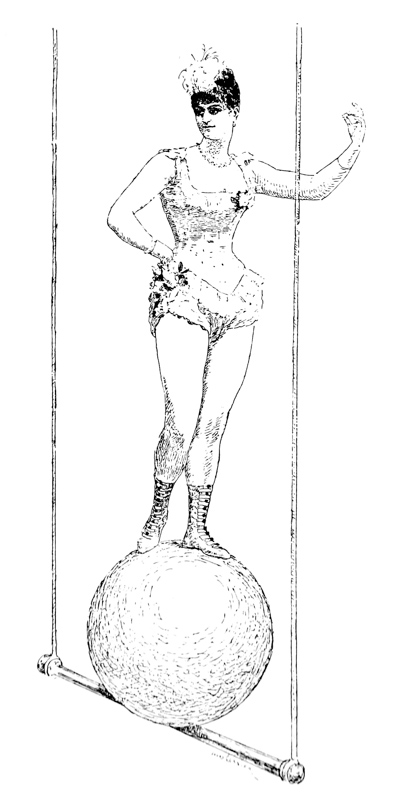
“‘She is pious, then?’
“‘Certainly; it is only a fortnight since she received the communion; she often communicates.’ [p238]
“I will not point out the contrast which presents itself to the mind. There are some facts like the drop of water, in which, as Mademoiselle de Gournay has already said, the whole sun is reflected.
“Poor child! has she travelled so far in safety on the rough voyage of the life which she leads? I hope so; it is the sincere wish of an old and unknown friend.
“C. Livet.”
The “old and unknown friend” of Erminia Chelli may feel reassured. I have eaten macaroni in the society of Mademoiselle Erminia and her family, and since her departure from France we live in the friendly intercourse of letters: the pretty equilibrist is still just the same as when he knew her. The horse filled the thoughts of poor Émilie Loisset, and so the trapeze fills the whole life of Erminia Chelli. It is her vocation; when quite small she would go under the table and swing her dolls upon a trapeze made of a hairpin and the elastic from her hair net. And, on the other hand, whenever she is not in the circus she passes her time in making bonnets for herself and her friends. This talent for millinery replaces Ingres’ violin. One has much more chance of pleasing her by saying, “How becoming your bonnet is, Erminia!” than by complimenting her upon her talent as an equilibrist.
Erminia is likely to amass a very large dowry. Do you know that £120 per month may be earned by walking head downwards upon the ceiling of a circus? In four or five years’ time she will marry. [p239]
“But there is no hurry,” she said, shaking her head, when some one mentioned this contingency to her.

She was right. The sight of her youthful form flying through the friezes is a delight to those pagans who appreciate pure curved lines, and it is also a subject for meditation to those philosophers to whom the little acrobat unconsciously gives a symbolic lesson when she has exhausted in an ascending [p240] scale of difficulties all the most unexpected combinations of equilibrist art, upright upon her globe, supported by the trapeze only, she pauses, and upon this vantage point of unsurpassable perfection, feeling sure that nothing more is possible, she smiles, sends a kiss from the tip of her fingers to her admirers, then abruptly, as though struck by lightning, she falls into the net.
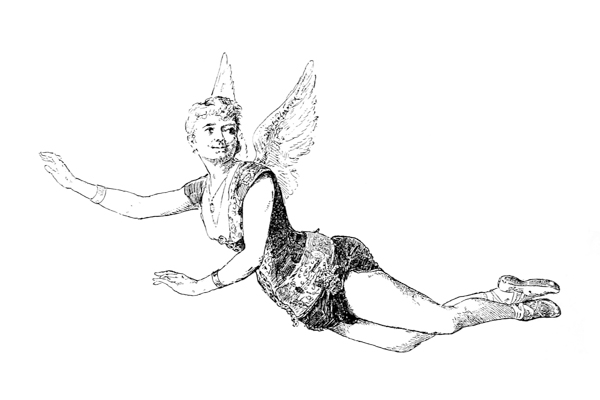

The tragic accident which killed an unfortunate equilibrist, Castagnet, by a fall from his cord in September, 1888, roused great emotion amongst the public. Those persons, even, who wrongfully credit the poor acrobats with practising every vice, cannot restrain their admiration for the marvellous courage which these pariahs display on these terrible occasions. We must take advantage of the intervals thus produced in the contempt usually felt by the public for circus artists, to prove to all lovers of fine physical performances that this great skill is not acquired without the practice of many daily virtues, of which temperance ranks least, and incredible perseverance is the most admirable.
I have now frequented the society of banquistes for many years, and am on confidential terms with them; I cannot assert [p242] too often the very great esteem I feel for them. Their art is wholly traditional, and it preserves habits of respect and obedience in their families which, perhaps, can scarcely be found elsewhere. Of course there are some black sheep in the band, some slave-drivers, like the bully whom Nils Forsberg formerly painted in a picture—Avant la ’Loi Talon—which caused a great sensation in Paris, but the subject of it appeared so cruel that the committee dared not admit it to the Salon. But this is an exceptional case, which is much less common than is usually believed. The “families” whom you see pirouette in the arena, vault over fixed bars, and scale the trapezes, keep, as a rule, to the old patriarchal customs. Rehearsal fills every hour of the day which can be spared from the theatre, and this muscular work produces a healthy physical fatigue, which is the best school of morality.
The first business of a family of acrobats that wishes to succeed in its tour round the world, is to perfect each member of it in some special exercise which suits his natural aptitudes. Some men are born carpet acrobats, others are attracted by the fixed bar, others seem born for vaulting. No mistake must be made at the début of a professional education, for an artist who wishes to acquire fame and fortune must become a specialist from his first teeth.
Whatever branch may be decided upon, the carpet acrobats, the bar experts, and the trapezeist have always commenced by training themselves in a certain number of universal exercises which form the basis of gymnastics, as the scale is the basis of all music.
They consist in learning the innumerable number of somersaults. [p243]
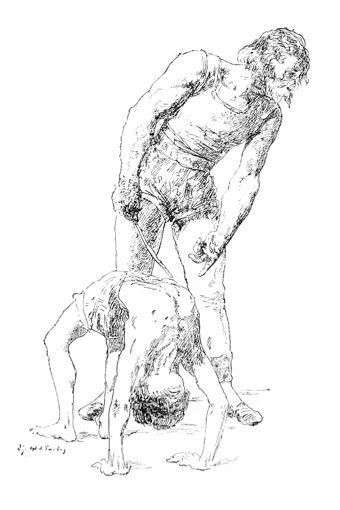
The first attempted with the feet firm, that is to say without springboard or batoude, is the somersault backward. This is much easier to learn than the somersault forward. The neophyte wears a strong tight belt provided with a ring above each hip. Cords are passed through these rings, and are held by two companions in work, enabling them to uphold the gymnast. The latter strives to turn round upon the axis formed by the two cords, gradually decreasing his reliance upon them. At last he can dispense with them entirely.
Before the acrobat attempts the somersault forward, he must go through the whole series of exercises in posturing. [p244] First bending forward or “posturing,” the hands laid flat upon the ground so as to support the body, which is raised with the legs opened, the first time in the form of a Y, the second time in an elongation of I.
Then comes bending backward, in which the body is arched in an inverse sense, the hands on the ground near the heels.
Next follows the curvet, which is performed by throwing the body suddenly backwards until the hands touch the ground. And at the moment they reach the floor a vigorous relaxation of the muscles of the legs makes the acrobat rebound upon his feet.
When any one has mastered these three primeval exercises, he may attempt the somersault forward without the aid of his hands. He must now rely upon combining these various acquirements in “acts” of his own invention that will dazzle and astonish the public.
The classical performance of a carpet acrobat opens by bending backward. It is continued by a monkey’s somersault—a decomposition of the somersault backward, by the rondade—a curvet backwards, and then by a somersault.
But vaulters do not end here; each of them varies in an infinite number of ways by the acts of his invention, the outline of his acrobatic career. He introduces an Arab somersault (a somersault from the side, which is obtained by starting from the ground on one foot only); the lion’s somersault, which is a monkey’s somersault forward; the coward’s leap, in which the acrobat, lying upon his back, raises himself by one effort of the loins; the forward somersault, a lion’s somersault without the hands, which throws the man, legs in air, head downwards upon the nape [p245] of his neck; the carp’s leap, also the sudden spring of an extended acrobat, which raises him to his feet through the relaxation of the muscles of the spine.
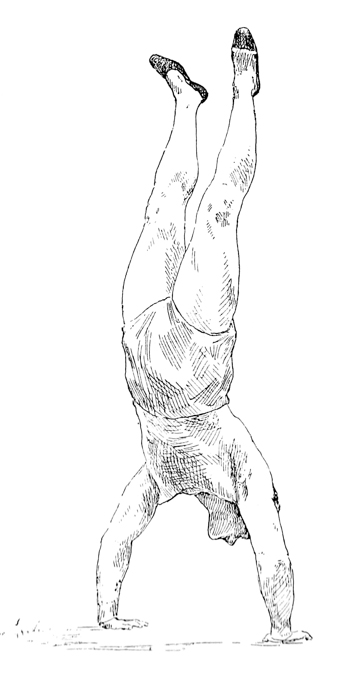
The double somersault cannot be performed from the carpet without assistance; the artist must spring from the shoulders of a companion, or with the aid of the peculiar spring-board which French banquistes call the batoude. With [p246] the batoude Auriol cleared twenty-four bayonets with a flying somersault, ended by a dive—a jump from a great height.12 With the batoude specialists have bounded over twenty-four horses, and at the gymnasium Du Marais, belonging to M. Pascaud, last year an amateur, M. Mars, performed a triple somersault.
This feat is the realization of the highest ambition of those carpet acrobats whom you have so often seen grouped in an apotheosis in one of those human pyramids which rise in a second through the strength of the gymnasts’ biceps, and which fall to pieces like fireworks, in rockets of somersaults.
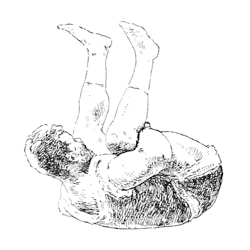
We cannot leave the circus floor without allusion to a series of individuals who exhibit themselves by the side of the genuine acrobats in performances of a special kind.
These are the contortionists, the india-rubber women—all those who were formerly known by the more general name of boneless acrobats. These boneless or dislocated performers are more numerous in the world than one would imagine. [p247]
Ballet-dancers are all dislocated, for their feet, legs, and loins have been disarticulated to obtain beautiful points; the naturalist quadrille-dancers from Mabille, who are now seen at the café concerts, are also dislocated.
There are some naturally disarticulated men. All Parisians will remember in their youth, a beggar who was celebrated as the “humpback of the Pont d’Austerlitz.” This mountebank caused his hump to pass from his back to his chest as he liked. The vertebral column turned without any effort from back to front, and from front to back again. He was found drowned one day between two coal boats, and his skeleton is still shown in the Museum.
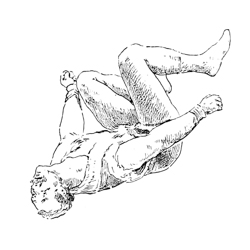
But he was an exception. One must begin early in order to manufacture a dislocated man like the “man in the ball.”
A wooden ball, about one yard in diameter, is rolled into the arena. This huge sphere ascends an inclined plane, and rolls from right to left upon it, then descends and recommences the ascension like a living being. And truly, for it suddenly opens and a dislocated man appears, who, without any semblance of fatigue, bows to the astonished audience. [p248]
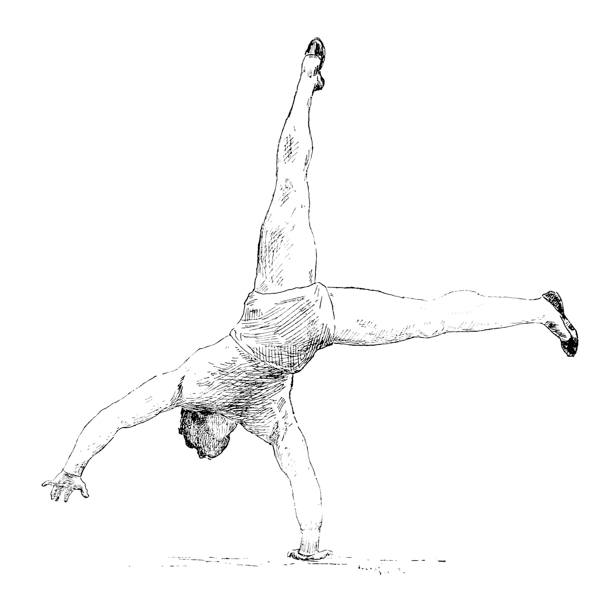
No one has yet guessed the secret which enables this wonderful contortionist to bend and move his body in so small a space. The bones, instead of being joined by articulations, are held together by a fibrous membrane which envelops them like a kind of muff and holds them in their sockets. This membrane, called “a capsule,” is very flexible, [p249] and is capable of great elasticity of tension, during childhood particularly. By preserving and developing this natural disposition, the abnormal movements can be obtained which surprise us amongst acrobats.
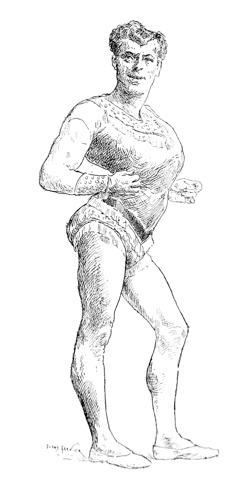
The performances of Walter, called the Serpent-man, are not less extraordinary.
I will not insult you by supposing that you have not seen and applauded this wonderful artist; it is, therefore, for the [p250] inhabitants of hyperborean countries that I shall now describe his work.
J. H. Walter appears in black tights spangled with silver, classic as an Antinoüs, nervous as a stag. He looks as though he could reach the friezes with a bound, and one is quite surprised to find that he does not leave the “carpet.” His performance opens by an important and novel act, in which the bust is reversed, and the head touches the back of the knees, whilst the right hand seizes one of the ankles, and the left is extended in an inverse sense, flat upon the ground. And the startling series of leaps, of movements, of contortions, which follow, end in an alarming pose, which recalls the monstrous gargoyles of Gothic sculpture; for the acrobat drops his feet, knots them under his head, and in this attitude, with starting eyes, and rigid, open lips, he resembles a skull supported on cross-bones.
When we were introduced to each other, I complimented him upon his artistic skill.
J. H. Walter seemed pleased with my praises; his British stiffness thawed, and we chatted familiarly.
I was very curious to know whether this acrobatic monstrosity had attracted much notice from the women. He frankly replied—
“Sir, the chastity which monks do not always observe is forced upon an artist of my class. You will guess that I did not obtain this complete flexibility in one day. On the very morning of my birth my father commenced to bend my joints. I grew up with the idea that I would be the greatest disarticulated artist of the century, or perhaps of all ages. I never had any other ambition. With regard to the point on [p251] which you question me, the greatest reserve is imposed upon me. I have all the appearance of a strong man; my chest is wider than your own, but beneath it I conceal the lungs of a child; they are stunted by the daily pressure of my thoracic cage. Consumption threatens me, and will carry me off very early unless I break my neck in the circus some evening, which I should certainly prefer.”

The acrobat told me all this without any affectation, in so natural and decided a tone that I did not feel justified in pitying his fate. But since I wished to know what sentiment could survive, in a being of such mediocre intellectual culture, his resignation to the sacrifice of life, I said to him with some interest—
“I quite understand; dear Monsieur Walter, that the applause you receive seems to you, whilst it lasts, a sufficient reward for your past sufferings and approaching end. But, tell me, when the fever of the circus has passed away, in your hours of leisure and solitude like this one, do you not curse your destiny?”
The Englishman smiled quietly.
“I have,” he replied, “a specific against ennui—a passion which saves me from reflection. I gamble, sir, gamble madly for whole nights at a time. I stake the thousands of francs which the managers [p252] pay me every month; worse than that, I have staked my skeleton, and lost it!”
The terrace of the café, where we were talking, had become empty through the lateness of the hour; the waiters had already closed the front, and were taking in the chairs.

The Serpent-man rose; and as I stared at him with wonder in my eyes, he added—
“We are driven from here, sir. Will you accompany me to my hotel? I will tell you how it occurred.”
He led me to a family boarding-house in the Rue du Colisée, which has no customers except the acrobats who pass through Paris. J. H. Walter occupied a fairly comfortable room on the first floor. He lighted a lamp, and [p253] when we were seated, facing each other, he continued his story in these words—
“It happened about five years ago I was performing in London, and every evening I played poker in the taverns with an ill luck that would not change. All my savings were lost, and when I had no money left the idea occurred to me to insert an advertisement in The Era (you know that is our professional newspaper), in which I said—
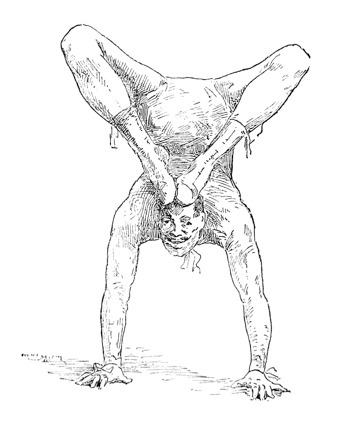
“‘J. H. Walter, the celebrated Serpent-man, will dispose of his skeleton upon his death for one thousand guineas, payable at once.’
“On the following day I received a visit from a celebrated surgeon. He made me undress, carefully examined [p254] my back, felt the vertebræ of my spine, then drawing out a pocket-book, he handed me a cheque for a thousand guineas without a word!
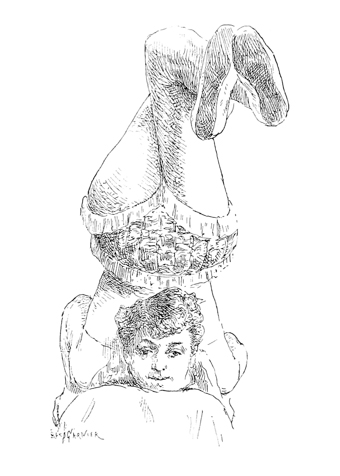
“Alas! my ill-luck still pursued me, and the money soon followed my wages.
“It is now eighteen months since I lost the last guinea of the surgeon’s money on the card-table. But if the treasure has gone, the contract still stands. In obedience to a formal clause in the agreement, I always travel with this. . . .”
The Serpent-man rose, went to his bed, and, stooping down, he drew a long, narrow oak box from under it. An [p255] address was painted in large black letters upon this queer violin-case—
DOCTOR
London.
The acrobat raised the lid, and I saw that the box was empty.
“This,” he said, “is my coffin; I always travel with it. Now, when I break my neck, I shall be hurriedly embalmed and packed into it. You see this paper gummed inside the box? It contains instructions from the doctor himself, written in four languages, for the undertakers, who will lay me out. Look, here are the directions.”
The Serpent-man stooped down with the lamp in his hand; I knelt beside him, and read—
“The persons who place the acrobat, J. H. Walter, in this coffin, are begged to inject a solution of chloride of mercury and acetic acid into his veins, according to the method used by the American, Doctor Ure.
“In default of the above, an injection of about four quarts and a half of sulphate of zinc may be used. The latter is even preferable, if the coffin will be more than forty days on the road.”
“Well,” said the acrobat when I had finished reading, “what do you think of it all?”
“I think, my friend, that you must have been tempted more than once to leave this box in the cloak-room.” [p256]
I smiled as I spoke, hoping to induce the Englishman to speak out; but the Serpent-man replied rather dryly—
“No, sir; such a temptation has never occurred to me: a gentleman keeps his word.”

. . . . The performance of carpet acrobatics is something like a state of larva to gymnasts. They all aspire to take flight.
The first step in this elevation is the “bars.”
The second, the glorious altitude, is “vaulting.”
Any one who has put on the belt of a gymnast, if but for [p257] one trial, has practised on the single bar the following rudimentary exercises:—
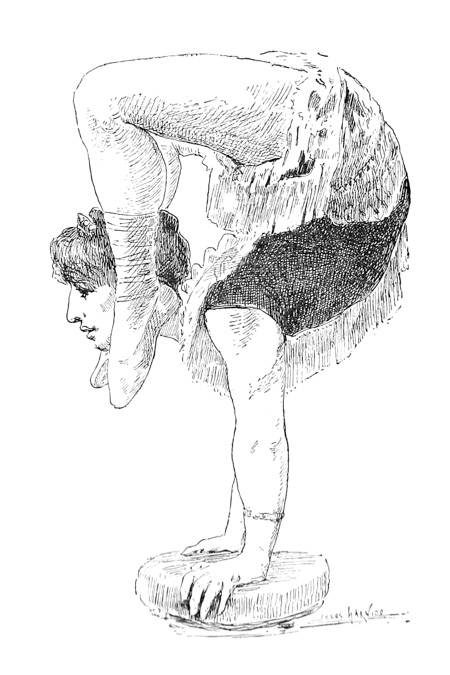
1. Breasting the bar, which consists in gently drawing the body, without jerking it, to the level of the bar, by the contraction of the biceps.
2. Circling the bar—curling the body gently over the bar head forward, holding tightly with the hands.
3. Simultaneous “upstart”—the elevation of the body [p258] above the bar, with both arms through a spring from the back—“temps de reins.”
4. Alternative “upstart”—one arm after the other.
5. Upstart on one leg, which has a corollary called German upstart or swinging.
6. “Cutaway up,” which is obtained by giving a strong spring, which throws the body forward, brings it back again in a natural swing, and is completed by an “upstart.”
7. Long swings or giant swings, forwards and backwards. This is a series of rapid somersaults round the bar, executed with extended arms. At times they are so rapid that the body describes a succession of circles round the bar, like the arms of a windmill.
8. Hough swings. This exercise resembles the preceding one, but the bar is grasped below the kneecaps, without the assistance of the hands.
9. Hands and feet swings. This is performed backwards or forwards; the hands and feet are both placed on the bar, the hands outside, the feet inside.
This is a fairly complete list of the exercises of an amateur, but very few of them practise the whole series. They pause at the “upstarts,” and at once pass to the double bars or parallel bars, which possess the hygienic virtue of widely opening the chest and developing the biceps.
Circus gymnastics usually commence with the triple parallel bars. There are a few acrobats who perform with the single bar and a double “batoude,” but I have only seen one specialist with the parallel bars—Gustave de Penthièvre, who is rarely seen now in the hippodromes.
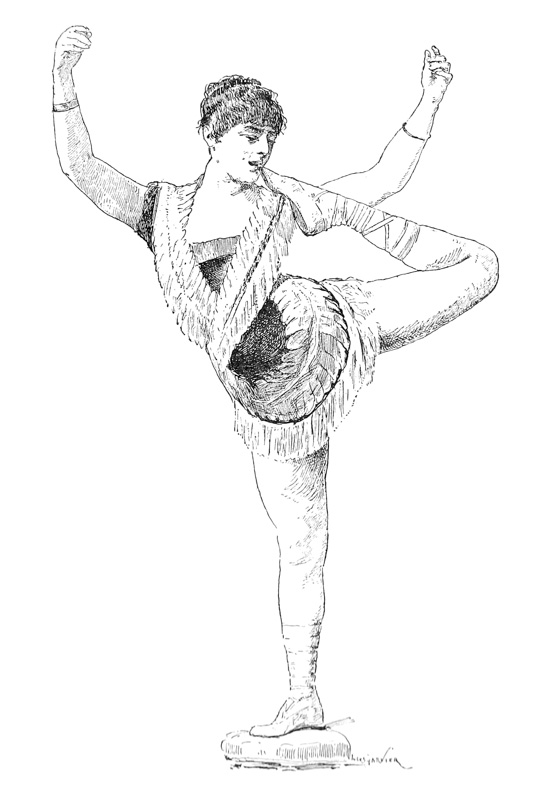
On the other hand, the triple parallel bars offer signal [p259] advantages for acrobats, through the opportunities they provide for numerous and very varied exercises. They enable several gymnasts to appear together, and thus give [p260] the artists breathing-time whilst their companions perform their share of the entertainment. These frequent intervals of rest are indispensable, on account of the exhaustion which follows the violent exertions of the gymnasts.
The series of acrobatics performed upon the fixed triple bars are called passes.
Amongst them you will find all the exercises of the single bar perfected, enlarged, and multiplied—the simple swings, demi-pirouette swings, swings on the feet, swings standing, vaulting acts, hands and feet swings, hough swings, somersault swings, heel swings. Sometimes the artist raises himself, sits on the first bar, opens his legs and profits by the impulse thus received to spring forward upon the other bar (vaulting act); sometimes he springs in recoiling, and then turns upon himself to catch the next bar facing him (swing upon the heel); but it must be understood that each acrobat has his particular acts which are combinations of these exercises suited to his dexterity and personal strength, and blended with various falls, somersaults backwards and forwards, double somersaults forwards, double reversed somersaults, etc., etc.
The fixed bar is also the best school of vaulting or flying.
Before Léotard invented the flying trapeze by a stroke of genius, vaulting exercises were restricted to the river jumping. Acrobats have now rejected with some contempt the two cords which held them prisoners by the wrists; to-day, they are masters of space.
This subject reminds me of the modern kings of the trapeze—the two brothers Volta.
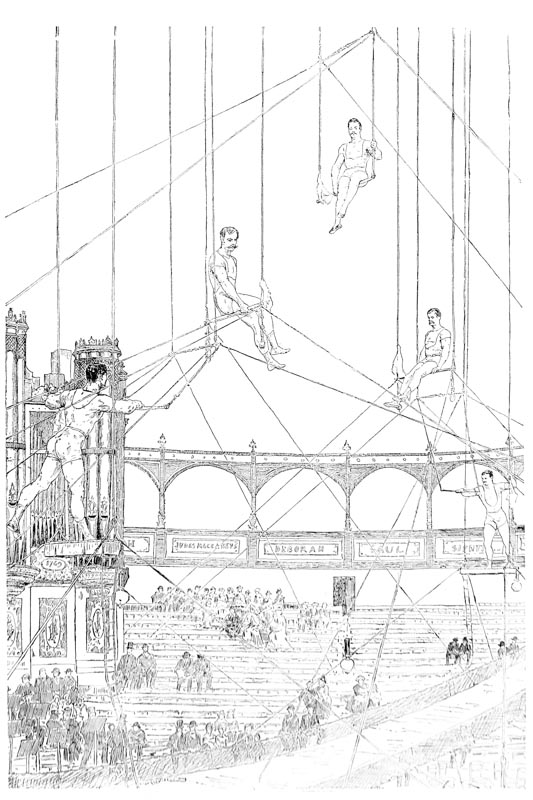
These gymnasts belong to a good family. They were educated in England in one of those country colleges where [p261] English boys develop the lobes of their brains and the biceps of their arms at the same time. Thanks to this system, my two friends, although they are the kings of the fixed bar, can also read the Iliad in Greek with great facility.
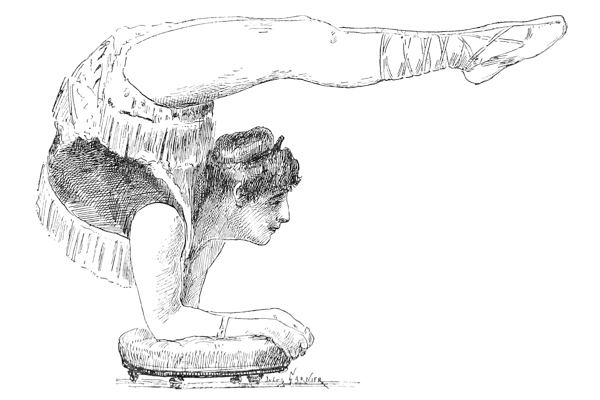
They both worked in a bank, and in the evenings, after dinner, they practised gymnastics for their amusement in a public gymnasium. Naturally supple fine young men, they made wonderful progress. A “manager” who accidentally saw them perform, proposed making an engagement with them. They consulted each other. They laboriously earned 600l. per annum between them in the bank. Now the Barnum offered a salary of 160l. per month. [p262]
The brothers Volta closed their books, crossed the ocean with a somersault, and made their début in America. They joined a band which already possessed two flying trapezists and an iron arm, the Hanlons, the genuine pupils of the old Hanlon-Lees. The Voltas’ contributions to the entertainment was a very clever series of performances on the fixed bars. This completed the scale of vaulting exercises. The band could make the tour of the world in glorious style with the varied accomplishments of its members.
With the exception of the standing swing and the feet swing, all the exercises of the fixed bar can be performed on the trapeze. Some special swings are also risked, such as the passe ventre, which is executed by throwing one’s self over the trapeze. But the most popular of these exercises is the simple flight from one trapeze to the other, with a few yards’ interval to be crossed between them. This infatuation is explicable, for there is no doubt that this performance gives us the best opportunity of admiring as in apotheosis the beauty of the human form, and this is the reason why the idea of placing young girls upon the trapeze was so quickly grasped. With the advent of woman, passion and crime made their appearance in the serene atmosphere of the aerial realms; which, like the republic of Aristophanes’ Birds, extend beyond the reach of human perversity. You have all felt the anxiety which seizes the heart during the flight supported (voltige en porteurs), when one of these young girls hangs by the feet to her trapeze—hushes the music, and in the sudden silence calls to her companion—
“Are you ready?”
The youngest of the two acrobats is mounted upon her [p263] saddle; with eye and muscle strained she watches the trapeze, which advances towards her in waves of rhythmical movements approaching nearer each time.
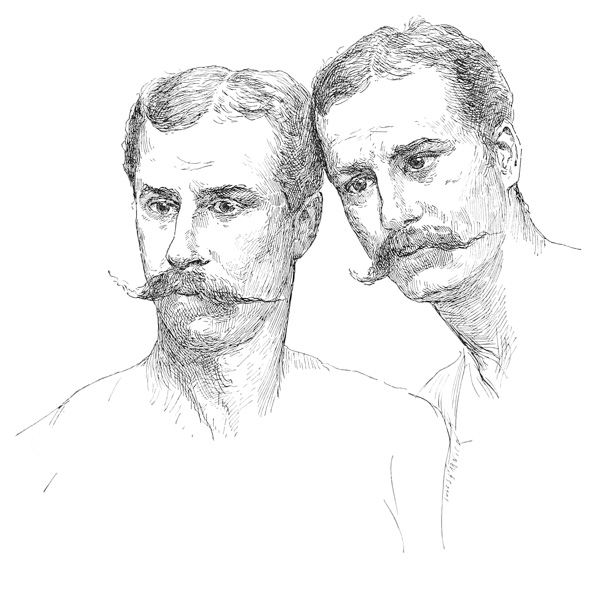
Suddenly the word is given—
“Go!”
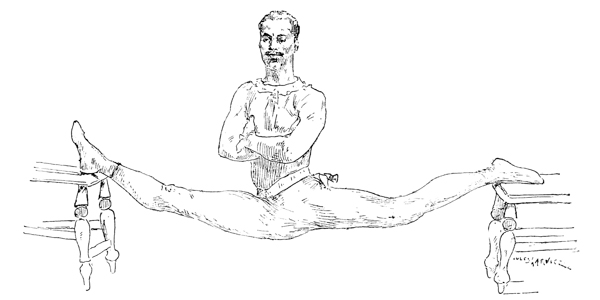
The youthful body launched by the trapeze like a stone from a sling, crosses the whole width of the circus, and the [p264] flying girl clasps the hands of her companion. The shock causes the two bodies to sway together for an instant, then they free themselves, and with a double somersault reach the net. You can imagine how easily a jealous girl can rid herself of a rival in those few minutes. An imperceptible movement of the loins, the delay of one-tenth of a second, and the girl flying through space is condemned to death. This misfortune recently happened through an accident, but there are some criminal cases of it. One of these incidents has been related already. The two heroines were called “Ohia” and “Nella.” The advertisement styled them “sisters,” but they were only companions in their aerial work. They detested each other with the indescribable artist-jealousy, in spite of their entry hand in hand and their stage smiles. It happened that the applause was warmer for Nella, the vaulter, than for Ohia who caught her; and on this [p265] account the miserable girl hated her companion so intensely that she resolved to kill her.
One day, therefore, when after the great spring Ohia grasped Nella by her hands, an abrupt movement suddenly precipitated the young girl outside the net.
Fortunately the shock was not too violent to allow Nella to catch hold of the cord as she fell. She remained suspended, dazzled for one moment, clinging to the saving line.
Ohia was still swinging in the friezes. Warned by the shouts of the audience that her scheme had failed, she made one tremendous spring, traversed the whole width of the circus, and fell shattered upon the palisades of the arena. Thus another proverb, also current in the side-scenes of the circus, was verified, and this time the whole world may take warning from it—“If you value your bones, never work with wine or with a woman.”
I once questioned some celebrated acrobats upon a subject which piques the curiosity of the public.
We all know by experience that Eves love well-made Adams. I do not mean the “mashers” with girls’ faces, but men built like the old statues, with supple limbs and broad chests. From this point of view, the gymnast who acquires strength without losing his agility, seems an ideal lover. I therefore asked them to tell me in friendly sincerity if they found many scented notes in their dressing-room every evening.
“I am sure,” replied Alphonse, the elder of the two friends, the orator of the pair, “that we receive quite as many love-letters, as the tenors do. From this you may conclude, if you like, that there is exactly the same number of practical women as of sentimental ones, unless the same individuals write to the [p266] tenors and the gymnasts—and this seems very probable to me.”
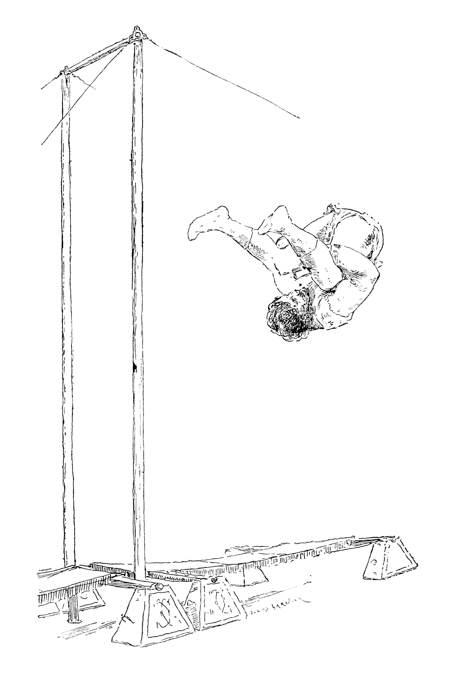
“And in what terms do you answer these passionate advances, my dear Alphonse?” [p267]
“We throw the letters into the fire without reading them,” replied the acrobat.

“You are afraid of being tempted?”
“Of course all excess is forbidden us. No one must mount into the friezes without a perfectly clear head. It is too easy to miss a spring and break one’s neck, even by falling into the net—which is more useful for reassuring the audience and the police than for anything else. But this is not our only reason for avoiding women. Ask Adolphe’s opinion on the point.” [p268]
“We do not like women because they are badly made,” replied his comrade, with a grimace of disgust.
I could not help smiling.
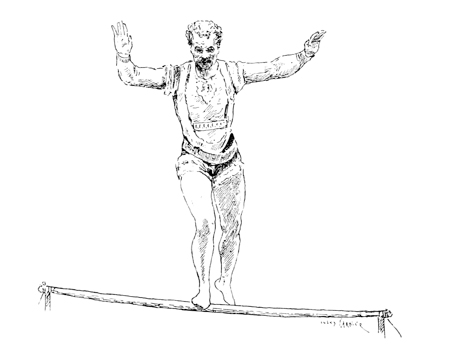
“Well, my friend,” I replied, “I think you are speaking of them like a jealous artist; you object to them because, with very limited skill, by the exhibition of their bodies flying through the air they attract as much applause as you do with all your artistic dexterity. It is not personal dislike in your case, as you seem to think—it is trade jealousy.”
At this Alphonse interposed.
“Adolph is right,” he answered. “Women are badly made. A woman is not an object of art, but of use. Look at her hips—how they exceed the falling line of the shoulders, crush the short legs and destroy all proportion by their excessive width. This defect requires concealment by some drapery, [p269] and should prohibit the exhibition of the nude. On the other hand the strength of the body, which in a woman lies in her hips, a man carries in his shoulders. Atlas bears the weight of the world upon his neck. Get up, Adolph, and show us your back.”
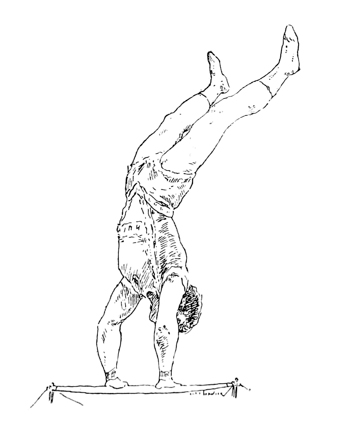
His friend was smoking, but he quietly laid down his cigarette, and took off his shirt. Alphonse looked at him for an instant, admiring him with the enjoyment of an artist, a smile on his lips.
“You can put that fellow,” he said, “into the ideal oval of the egg upon which Greek sculpture has inscribed the hermaphrodite, and you will see whether his shoulders destroy the classic lines of sexless beauty.” I have often heard these æsthetic truths expressed by other trapeze artists more coarsely and with less appreciation of art. [p270]
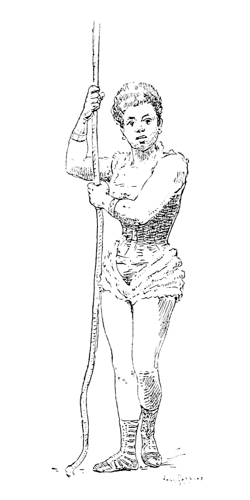
After an interval of some centuries, the life of the gymnasium has revived the customs which astonish modern readers in the Banquet. This surprise is unworthy of philosophers. It is logical that throughout all ages the same causes should produce the same effects. The woman of antiquity remained in the gynæceum, and she was rarely seen by the outer world.
Woman is banished from modern gymnasiums by her natural destination of wife, mother, and nurse.
The Greek youth became enamoured of the ephebe in the gymnasium, where they appeared nude and beautiful.
Modern gymnasts admire their fellow-workers in their [p271] dangerous performances with equal enthusiasm. And it would show little knowledge of human nature if we inquire how the admiration for beauty becomes transformed into the wish to possess it, that is, into love.

[p272]
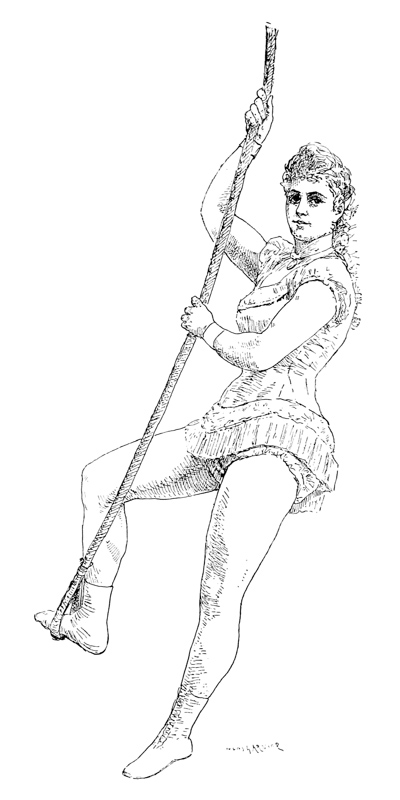
I write the word without fear of any misunderstanding.

We are now contemplating simple, healthy men who pass [p273] their lives in performing very hard work, and who are freed from sensual temptation by physical fatigue. As a rule, [p274] therefore, the passions of gymnasts are purely sentimental and platonic; you will find in them first of all the great element of all love—the protection of the weak by the strong. There is, in fact, in every pair of acrobats, a male and a female, the “hero” or bearer, the “man underneath” who supports the weight of the whole “act,” to whom the “man above” confides his life. The latter is the younger, the most supple and graceful of the two. He receives the larger share of the applause, the most enthusiastic “bravos.” His existence depends upon the self-sacrifice and affection of the man who upholds him.
“We must rely upon each other,” said one of the Hanlons to me one day, referring to their young comrade, “Bob,” the favourite of the whole troupe.
Translated:
“We must love each other like the youthful soldiers of the Theban legion, like Castor and Pollux, to whom legend has never assigned any mistress.”
This conviction of the superior, absolute beauty of man is so bound up in the customs of the gymnasium, that you will find that all men of high culture who devote themselves to physical exercises, acquire with their attachment to the trapeze, the same æsthetic views. The most illustrious example that I can quote on this point is certainly Pierre Loti.
You have read his novel of Azyadé, and you know the enthusiasm with which he speaks of the gymnasium. Remember, on the other hand, the tenderness of the novel-writer for Frère Yvres, recall the Pêcheurs d’Islande clinging to the helm of their boat, and you will more easily realize the [p275] discipline by which gymnastics lead an acrobat who cares for his profession, to the æsthetic admiration for man.
For my own part until I read the works of Pierre Loti, I never thoroughly understood the epithet which Pindar throws in the face of an Olympian victor in a lyrical antistrophe—
“Oh, barren gymnastics!” . . . . .

[12] Originated by “Little Bob” Hanlon.

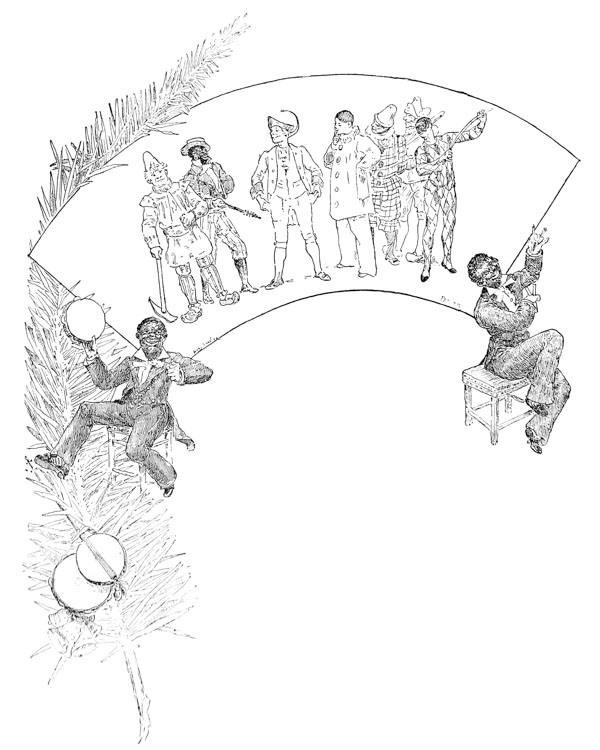
The clowns are the most popular members of the motley crowd that attracts the audience of the circus, hippodrome and other places of amusement, where strength and beauty form the basis of the entertainment. Their pirouettes fill the house, they are the “attraction,” the great success of the programme. As they are not very numerous, for there are not more than thirty of them scattered over the globe, [p278] the directors compete for them at very high salaries. Like the star-tenors they contract engagements for many years in advance, and receive the emoluments of an ambassador, and their requirements increase with their success. I am told by the agents that their commissions have never been so high as in the last few years.
Although much appreciated in France, the clown is not a creation of the Latin genius. It only invented the three personages of the comedy dell’arte, the three typical masks from which every expression of the human face arise: Pierrot the coward, Arlequin the crafty, and between them, the perverse Columbine. During many centuries these three puppets have moved through every shade and variety of psychological pantomime.
At the present time Italian pantomime is an extinct art. In the time of Watteau the poor masks had already lost their definite outlines, and their idiosyncrasies had become misty and dim. They are now effaced, dispelled by the cloud of powder which the clown, launched from the other side of the Channel, scattered in the air as he tumbled upon the French stage.
Etymologically the clown is the rustic, the rough peasant, pugnacious, ignorant and silly, who enlivens the sombre dramas of Shakespeare by his foolish quibbles. In England this ludicrous personage was the indispensable accessory of every play; he is nearly related to the French Jocrisse, who also wears the garb of a well-to-do countryman, and is equally ridiculed by the city folk.
The Shakesperian clown has not yet disappeared. He is to be found with all his traditional attributes in the three [p279] companies of Hengler’s Circus, which travel all over England, and at Christmas time give simultaneous performances in London, Liverpool, and Dublin.
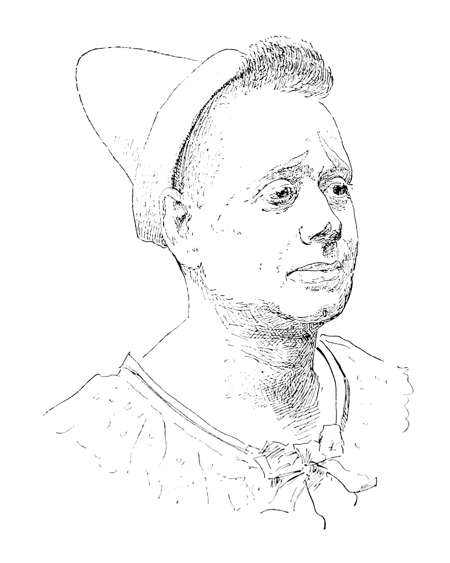
I remember entering the arena of this national circus one Sunday morning in London, and being considerably surprised to find the whole company in morning dress assembled in the ring. A black-coated individual, Bible in hand, was addressing the acrobats. He was a clergyman. I have been told since that Mr. Hengler exacts punctual attendance at the Sunday services from every member of his troupe.
In this traditional house, the Shakesperian clown, the jester, as he is called in the profession, appears in white tights, [p280] ornamented with blue or red patches indiscriminately arranged, with a short drapery round the hips, and a fool’s cap on his head. Thus attired, he does not caper and joke, but declaims passages from Shakespeare and sings Irish songs which delight the public in the cheap places.
You can easily imagine that such a figure could not be moved from its native surroundings. The dialect of Old Tom, the tirades of King Lear, would not please any audience, except in the United Kingdom. Some other work must be found for foreign engagements.
The jester, therefore, looked round to see if he could not gather some useful hints from his stage companions, that might help to fill his travelling bag, and naturally he studied the coloured minstrels. It is impossible to write a serious history of the clown without making some allusion to these negro singers. The modern clown, acrobat, magician, and pantomimist was produced by the union of the jester and the minstrel.
Lovers of old books, who strolled round the Quai Voltaire last winter may have noticed in the window of a dealer in curious prints, a collection of bad chromolithographs from New York which attracted and amused the passers by. They depicted the misfortunes of “coloured men,” caricatured by their old masters; ridiculous falls into buckets of water; a horse kicking a negro in the jaw; a gun exploding, blows a negro into a thousand pieces like Captain Castagnette. The mouths with their gleaming teeth are always split by a foot placed across them, the legs are thrown above the woolly heads in grotesque dances, which seem performed in rhythm to the blows of a whip. These coarse pictures were not signed [p281] by the artist, they bore the names of the publishers only, Currier and Ives of New York.
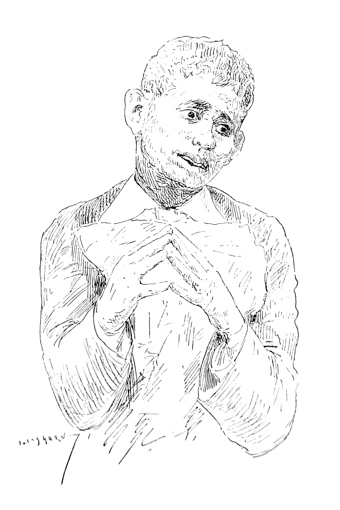
English pantomime, the extraordinary pantomime of the Hanlons, Pinauds, Renards, Leovils, Ramys, and Leopolds, is considerably influenced by these slave gaieties, by the monkey-like tricks of the negroes capering for the amusement of their cruel masters.
Freedom has been granted, the whip no longer inspires the [p282] epileptic dances of the blacks, but their jerky gambols so greatly diverted the “massa,” that they have survived slavery itself in an essentially American and English institution: the Christy Minstrels.
Visit music halls you will find on occasional stages a curious chorus of men in evening dress, sitting in a semicircle, their faces blackened with soot. In St. James’s Hall the effect is particularly curious, for it is here that Messrs. Moore and Burgess, who have carried negro minstrelsy to the highest perfection, exhibit their company of coloured minstrels. The back of the stage is occupied by the orchestra. From an artistic point, no pains is spared to seek out and engage the best musicians who come before the public both vocal and instrumental. Among the vocalists may be reckoned some of the finest voices obtainable in England or in America. The singers are seated in a semi-circle, the comic men are placed at either end of the row, and these furnish the life and humour of the entertainment; they are the comic vocalists, the propounders of quips and tellers of droll stories; their instruments are the bones and tambourines.
They play, sing, dance a jig and make jokes. This is the duty of the two leaders of the band, the jester and his butt.
Messrs. Moore and Burgess confine their well-recognised original Christy Minstrel Entertainments to the St. James’s Hall. It is the key-note of their programme that they “never perform out of London.” On the other hand, their commonplace imitators become out of the London season itinerant humourists.
In the summer you will find them on the sands [p283] of every sea side town. Banjo in hand, arrayed in the cotton trousers worn by the old slaves, always accompanied by the black dress coat, an eyeglass in one eye, straw hats on their blackened heads, they call themselves the Ethiopian serenaders. They travel in bands and perform in the open air.
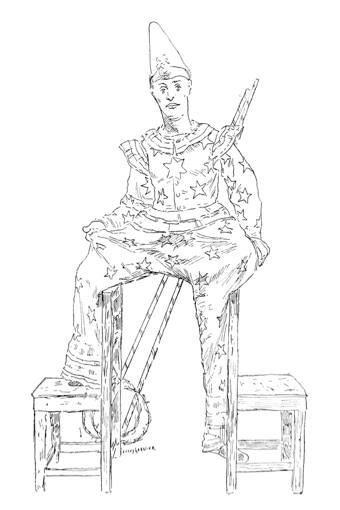
Very agile and supple, they repeat in violent dances a [p284] species of gymnastics which a little resembles the “chahut” of the lower classes in France. The great “split” is as familiar to them as the somersaults, etc; and these two exercises form the greater part of the pantomime, which the minstrels perform when they are tired of playing on the banjo.
The acrobatic success of the minstrels pointed out a road for these clowns, who were anxious to place a girdle of somersaults round the terrestrial globe. The pirouette had the advantage of being understood by the spectators in every land.
The clown therefore started without any other luggage.
This English emigration dates from about 1865. This was the time of the clever entries of vaulting clowns, who starred the whole ring with their capers. They vaulted from the “carpet,” and from the great and little batoude, that is to say, performed a somersault from a spring-board over a wall of horses.
In the course of his travels the jester, now an acrobat, learnt the idiom of several countries. From a few words interspersed through his performance, he at once saw that his English pronunciation easily roused the laughter of the audience. His accent amused the Parisians particularly, and he thought that great capital might be made of his broken French, and a large salary earned whilst sparing his physical labour. The corporation at once divided into two branches.
The clowns who found that their inclinations prompted them to become “patterers” renounced the “carpet” and the “spring-board” to speak to the public.
Those whom gymnastics had fascinated turned towards acrobatic pantomime. [p285]
And here we must weave a crown of laurels and immortal flowers for Billy Hayden, the incarnate type of a patterer clown, and you may be sure that some day his place in the history of the stage will be quite as important as that of the late Deburau.
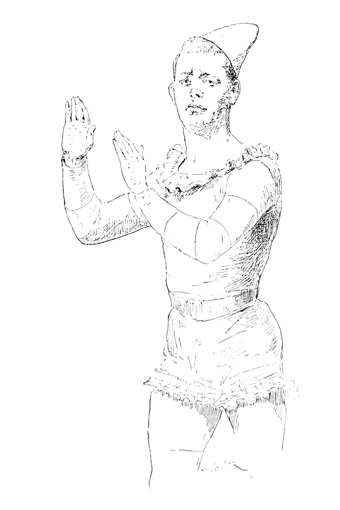
Billy related the history of his life to me. He was born in Birmingham, and his vocation dates from his early childhood. He was one day mounted upon his father’s shoulders to watch an acrobat performing in the open air, who ascended a movable perch. The spectacle made a deep impression upon the [p286] child, and nothing could prevent him from following his vocation.
Billy is a pupil of the minstrels. At the opening of his career, he travelled through the world besmeared with black. In Germany, the idea first occurred to him to powder himself like Pierrot, and at once found that the change produced a great success. The clever expressive features previously concealed by the soot were suddenly disclosed by the powder. And the audacity of the clown increased with the encouragement of public applause.
Nearly all the jokes with which he has amused us are borrowed from the minstrels. They always repeat the scene of a jester and his butt, the stock-in-trade of the old show. At the circus, the ring-master is the butt, the sensible man who corrects the childish nonsense of the clown.
The clown Footeet plays one of these traditional scenes very naturally. Mounted upon a horse, with his face to the tail, he calls out:
“Oh, this horse hasn’t got a head.”
The ring-master gravely answers:
“It is on the other side, clown.”
“Turn it round then.”
“That is impossible, clown, you must turn round yourself.”
Footeet prefers vaulting to talking. But Billy Hayden is as lazy as his donkey, and prefers jokes to somersaults. His repertoire includes an amusing story of a stolen child.
When the star equestrian dismounts from her horse, Billy turns to M. Loyal and says:
“Môa aussi, jé été oun cholie pétit démoisel.” [p287]
“Allons donc! clown!”
“Vô n’étiez pas là quand jé suis né? Môa, j’y été. Alôrs jé dois savoir mieux que vô!”
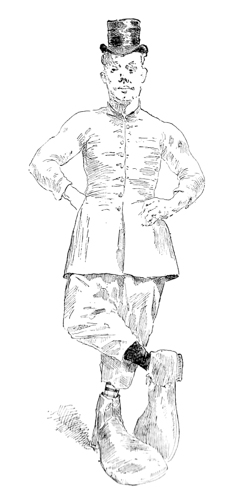
And in a lamentable voice he relates the misfortune which befell him:
“Labonn’ mé proménait dans oun vouâture d’enfant, et ell’ [p288] s’assoit sur le bi-du-bout-du-banc à causer avec oun militair’. Et alors oun vieil’ sorcière é venue avec oun pétit garçon. Et ell’ a pris môa la choli pétit’ fill’ de la vouâture d’enfant’, et ell’ a mis à la place môa, le vilain petit garçon, dans la vouâture d’enfant. Et depuis ce temps-là jé oun souis vilain pétit garçon!”13
With this Billy draws out an indescribable pocket-handkerchief and bursts into tears.
Those whom this clown does not amuse, who prefer drama to comedy, will reserve their approbation for the acrobat-clown, who has inherited the genius of the Hanlon-Lees.
This radical transformation of style tempted the jester by many advantages: first, by replacing words by gestures, it suited the natural taciturnity of the Anglo-Saxon character, which cannot dispose of the resources of Italian loquacity; then it evoked great applause by the unexpected contrast between the somersault suddenly executed precisely according to rule, following the ridiculous knockabout performance of the tumbling scenes.
In making this evolution the clown exposed himself to the danger of being confused with the professional gymnast whose exercises he reproduced. This danger however was more [p289] apparent than real. The work of a gymnast is of a special traditional character which no whimsical variation is ever allowed to tamper with. Its immediate aim is the display of daring movements and harmonious attitudes of the human body, and above all it is a plastic performance. The clown’s art, on the contrary, should aim at evoking laughter, not applause. It appeals less to the sense than to the intelligence, and, unlike gymnastics, it is not confined by classic fixed rules. It has the right to follow the wildest fancies of a whimsical imagination. It is not a Greek art, but an English one, and it reflects all the most curious characteristics of the Anglo-Saxon people.
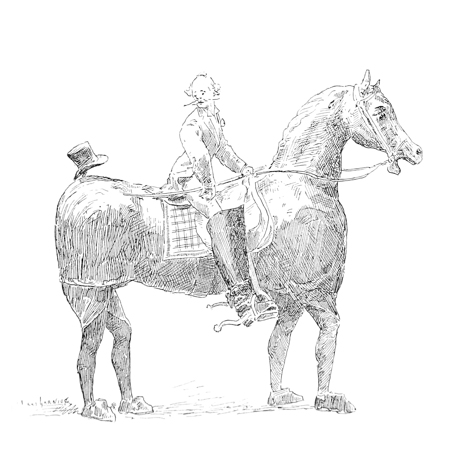
[p290]
The prevailing note in the Anglo-Saxon character is melancholy. This produced the spleen, the gloomy ideas and the systematic calculated first tinge of madness which the English themselves call “eccentricity.” To this habitual sadness the Anglo-Saxon joins a certain brutality, which is visible in all his games, sullies all his pleasures, and even gives to his vices a peculiarly sombre hue. In England gymnastics are cultivated, not for the beauty which they bestow upon the body, but for the murderous weight which they give to the fists of a boxer. England is the cruel country, where men first formulated the law of the “struggle for life.”
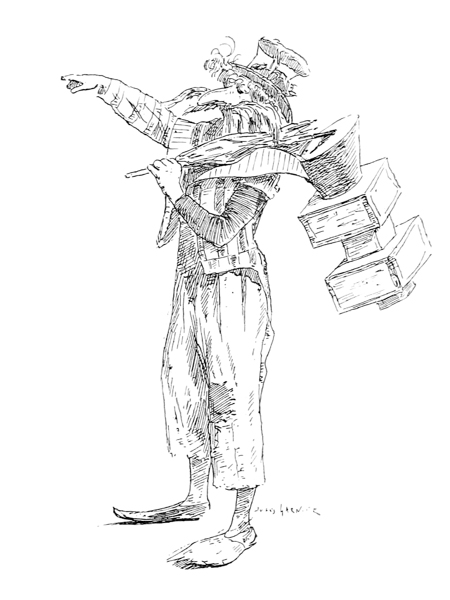
[p291]
The clown, the direct son of the Saxon genius, said to himself:
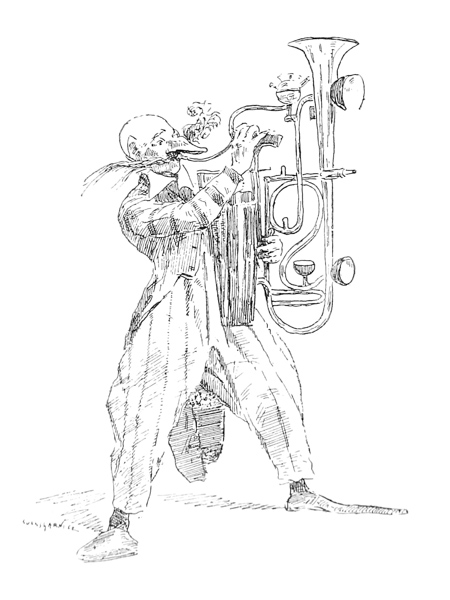
“To please my fellow-countrymen, who worship strength more than anything else, I must first of all be strong, before I can excite their admiration. I will therefore commence by developing my muscles. As to my pantomime, if I wish it to succeed, it must, by the incoherence of its actions, the whimsicalness of its pointless gestures, the automatism of its movements, imitate the terrible spectacle of insanity.”
With this idea, the English clown has adopted a mourning livery of black and silver, and has broken the powdered mask [p292] of Pierrot by two red spots, two bloody patches; the insignia of boxing and of English consumption.
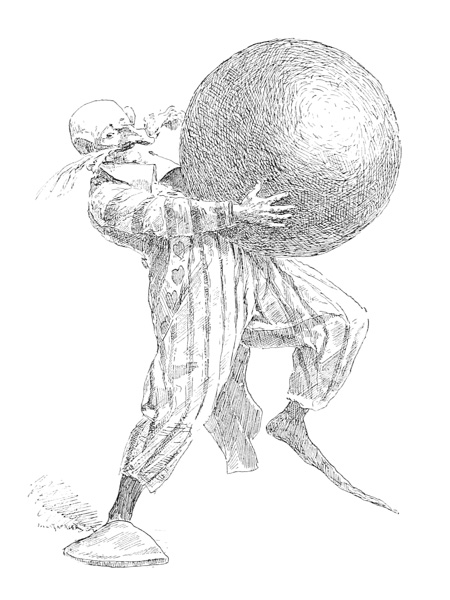
This gloomy clown crossed over to France upon the steamers that carried Darwin’s books and the commentaries of Schopenhauer. For one hour the French imbibed the sadness of their insular neighbours, the black acrobat was well received.
Every one will remember the welcome which the Magiltons and the Hanlon-Lees received in Paris. It was the first time [p293] we had seen English pantomime. The exotic art upset all our ideas of logic, it was in direct opposition to all our innate taste for clearness and delicate performances. However, it succeeded, for it evoked the only laughter of which we were at that time capable, a laughter without merriment, convulsive, full of terror.
The Hanlon-Lees! How many pleasant artistic feelings the name evokes in the memory of Parisians. The troupe is scattered now, throughout the world, there are the Hanlon-Lees on one side, the Hanlon-Volta on another, three of the brothers are dead, and their comrade Agoust has abandoned them to become manager of the Nouveau Cirque.

This intelligent and amiable man, who intends some day writing the memoirs of his eventful life, has told me the details of the history of the Hanlon-Lees—their true history, not the account of them which you will find in a little book published under the title of the Memoirs of the Brothers Hanlon-Lee, [p294] with pretty illustrations by Regamey and a splendid preface by the master, Theodore de Banville.
The six brothers Hanlon, Thomas, George, William, Alfred, Edward, and Freddy, first met Agoust in Chicago, about 1865. They were then working as trapeze and carpet acrobats. Thomas and Alfred, two splendidly built men, were the “underneath men,” the carriers in the pyramid. The other brothers were—rather puny; they always wore double tights. Under the silk tights—worn outside—was another suit, called in the acrobatic vocabulary, a thirty-two franc. In the place of muscles this suit was arranged with fine woollen fringes, which were carefully combed upwards so as to obtain good curves; and one of the favourite jokes amongst artists, is to stick pins, provided with little white flags, into these false muscles.
At Chicago the Hanlons were vaulters, and Agoust juggled. A tight-rope dancer, and Tanner with his dogs, had joined the company, but the entertainment was still too short.
Agoust, who had been manager of the Young Henry Theatre, pantomimist and leader of the ballet, suggested to the Hanlons that they should perform a pantomime. He made them rehearse two old pieces by Deburau, Harlequin Statue, and Harlequin Skeleton. The experiment succeeded, and in 1867 the little company went to Paris, where it made its reputation by the pantomime of the Village Barber.
The war of 1870 divided every one. The Hanlons returned to America with the Strandges company, which had been installed at the Châtelet. Agoust enlisted in a marching regiment.
They met again in 1876, at the Walhalla in Berlin. The [p295] Hanlons were trying to mount a scene borrowed from the minstrels, the celebrated Do, mi, sol, do. They were made up like negroes.
“What can you do in this piece?” they asked Agoust.
He replied, “You have no conductor. I will place myself in the desk.”
The five Hanlons then accepted their old comrade as a partner in the place of their brother Thomas, who had died in America. Thomas Hanlon had fallen at Cincinnati whilst making the spring for life, and had broken his head against the balustrade. It had been mended somehow, but he suffered intense pain when his brothers jumped with both feet upon his head. He had complained, saying that he could not bear it, but he still continued this performance. At the end of a few months he went mad.
The brothers Hanlon were always a band of terribly hard workers. Every day, except Sunday, they rehearsed from ten in the morning, till two—and from four till six in the afternoons. When they were tired of vaulting they sat down and worked mentally.
“My boys, never drink before a performance,” George (the leader) would say to them. “After it is over, do whatever you like.”
The Hanlons were Irish, and were supposed to drink deeply sometimes after leaving the theatre. But if there were excesses they were utilised, for when they met on the following day, they related their dreams to each other and endeavoured to construct a play out of them.
Do, mi, sol, do met with extraordinary success at the Folies-Bergères. The Hanlons had been engaged for one [p296] month at a salary of £360, but the first evening after the performance, they signed an agreement for £600 per month, and played their pantomime for thirteen months running.
Do, mi, sol, do and the Journey in Switzerland were performed in Belgium and England with extraordinary success. In the latter country Agoust separated from his companions.
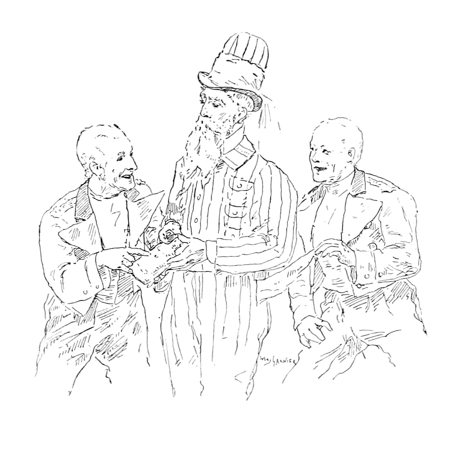
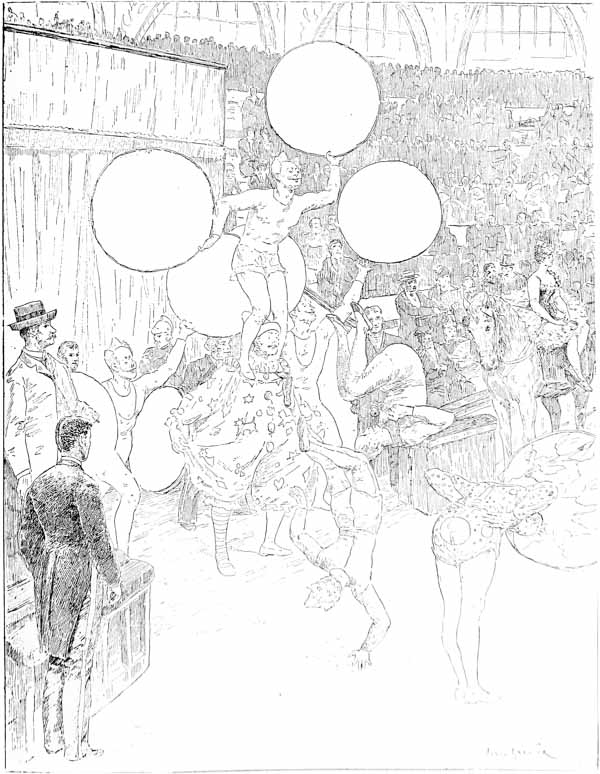
English pantomime does not require any tragic incidents in order to fill us with admiration and wonder. We have lately seen two companies of artists in Paris, the Leopolds and the Pinauds, who recalled the best days of the Hanlon-Lees. I am thinking chiefly of the Pinauds, who are exceptionally clever. I made the acquaintance of these three talented American actors whilst they were at the Folies-Bergères. They are not brothers, but friends, and they are thorough gentlemen. I say this quite earnestly, for if you [p297] meet them in the American Minister’s drawing-room you will not feel at all surprised to find them there.
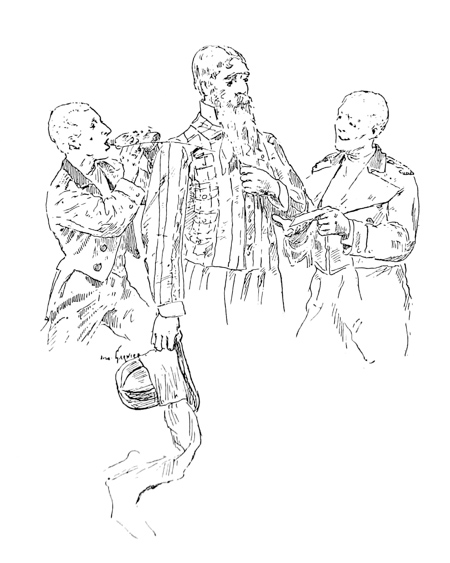
They are devoted to their art, extol it with much enthusiasm, and discuss it like artists who have deliberately adopted it, and who exert all their inventive faculties in the production of their pantomime and in bringing their unique idea into full relief. I saw this strange performance several times running and should find great difficulty in analysing it. It consists of a series of disjointed actions placed side by side, accompanied by rapid changes of costume, mad pursuits, and grotesque disguises.

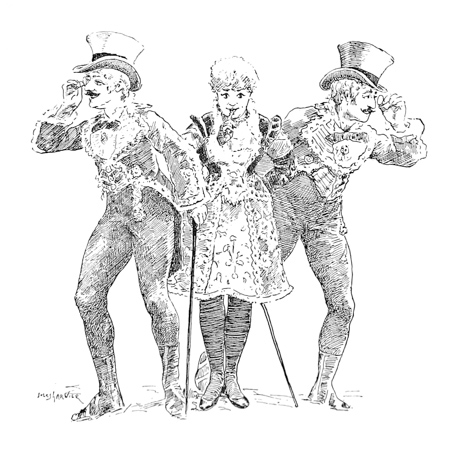
A gentleman is playing a guitar, but he is constantly [p298] interrupted by the entry and exit of strange individuals leading animals, which are all musical instruments. Everything is musical in this pantomime—the pig that the peasant drags after him, the carriage of the cannon with which a malefactor fires a shell at the back of the guitarist. The last part of the farce [p299] is filled with the misfortunes of the peasant with the pig. In the first place the rustic is roughly attacked by a bull, which aims violent blows at his umbrella with its horns. The peasant valiantly resists the blows from the horns and tail of the animal, drives it off, and proud of his victory, sits down to rest with a triumphant air. But, alas, an ill-disposed jester sets fire to John Bull’s hat, it explodes like a petard and flies into the friezes. In despair the peasant lifts his arms to heaven. His prayer is answered immediately. As though the ceiling were a horn of plenty, a rain of hats and caps descends upon the stage. But they are the crushed shabby hats of bookmakers and poor Irishmen, a lot of those formless head-gear, which are only seen in London, where the workman has no distinctive head-dress, but puts on the cast-off garments of [p300] the rich, thus giving to his poverty the appearance of a masquerade. The peasant quickly tries on about twenty of the hats, but not one of them fits his head. Again he lifts his arms to heaven with a gesture of despair, and the curtain falls.
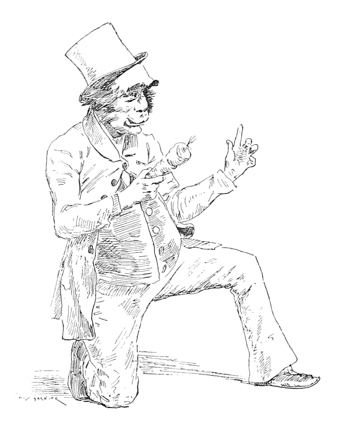
With the mania which we Frenchmen have of insisting that everything should have a meaning in spite of all appearances, I asked the Pinauds what their pantomime signified. “Absolutely nothing,” replied one of them. “On the contrary, we try to destroy all connection between the scenes of our entertainment. We only wish to produce upon the audience the impression of violent terror and madness. And therefore we represent a man, alarmed by the successive apparitions of animals which play music when they are touched.” I listened [p301] quietly, but I could not help remembering the invariable question, which I had heard the doctor at the police station ask the drunken maniacs whom the police had picked up in the streets—
“You see beasts, do you not, animals that swarm round you?”
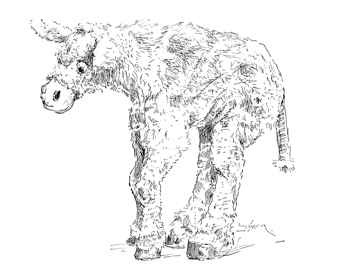
They all reply in the affirmative, hanging down their heads.
These drunken hallucinations, these apparitions of animals, are the framework of the English pantomime, the terrible visions of a gin-drinker who has rolled into a gutter at the door of a drinking bar.
The Craggs, “gentlemen acrobats,” also appeared at the Folies-Bergères.
They came from New York, where they had made a great success. They had also made large profits during their six [p302] weeks’ engagement, for they received 100 dollars a night. They enter the stage in Indian file, all the seven, wearing evening dress and white ties. They come forward in a line to the front of the stage, and bend their heads; you think that they are going to bow, simply like you or I. Instead they make a somersault. Seven somersaults forward. They are so quickly executed that every one present asks if he is dreaming. Very correctly executed, notwithstanding, very correctly! Not one smooth head is ruffled, not one white tie unloosed, not a shirt front creased.
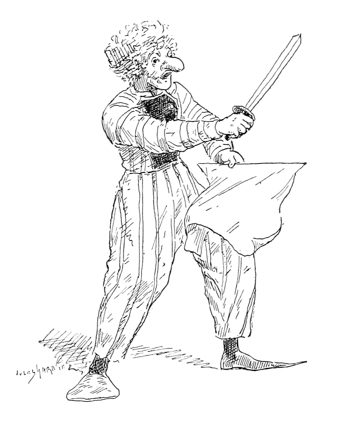
We must however believe that the coat inconveniences the gentlemen in their work, for with very leisurely movements, [p303] and perfect indifference, the seven Craggs go to the back of the stage, and there, one, two, three, in time, as though performing an exercise, they take off their coats and appear in fourteen shirt sleeves.
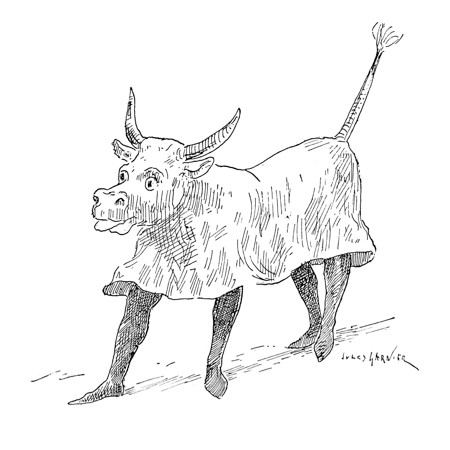
And from that moment, for the space of half an hour, they execute the most wonderful acrobatic feats.
The seven Craggs mount upon each other, then fall away like houses built of cards. MM. Craggs senior turn MM. Craggs junior round their arms. One half of the Craggs always has the legs in the air, whilst the other half is head downwards. And what deportment! how completely it differs from the smiles, kisses thrown to the public, and rolling eyes [p304] of the Italian acrobat! We shall see that in the Molier Circus, authentic gentlemen have been converted into passable clowns. Messrs. Craggs have proved to us, a more unexpected fact, that perfect gentlemen can be made from professional clowns.
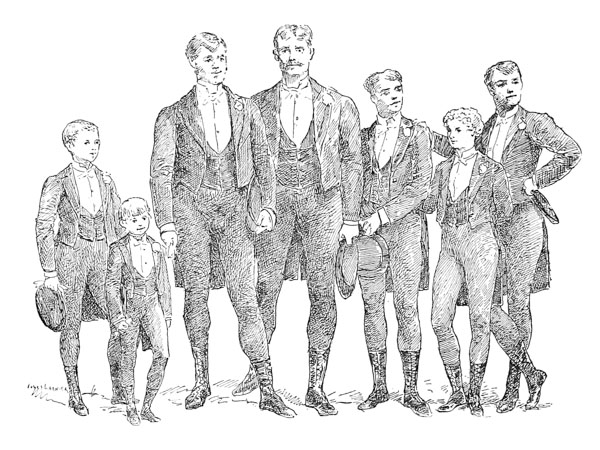
Since it is my mission to betray the secrets confided to me, I will tell the public, the whole world, that the Craggs are not seven brothers, as we might be tempted to believe, but a family consisting of the father, six sons, and one little sister Cragg.
Mr. Cragg, the father, is nearly forty-two years old, he looks like the brother of his eldest son, who is not yet twenty-four. The little girl who so bravely wears the black coat asserts that she is fourteen. I kissed her, after the performance, and complimented her most sincerely. [p305]
“She is a little Australian,” said her father, smiling kindly at her.
“An Australian, Mr. Cragg?”
“Yes, she was born at Sydney, whilst her brothers and I were performing in New Zealand and China.”
The Craggs have just returned from Pekin.
They have travelled round the world, with gardenias in their buttonholes, and Barnum has thrown golden bridges across the ocean for them.
I told you that the time had come for writing a monograph of the clown-king!
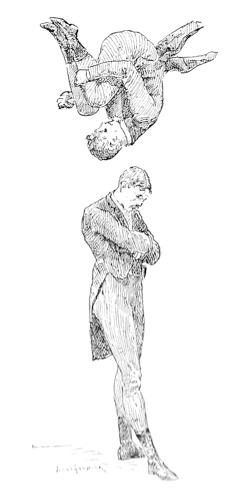
[13] “I too was once a pretty little young lady.”
“Come now! clown!”
“You weren’t there when I was born? Well, I was. So I ought to know better than you! . . . . . .
“The nurse had taken me out in a perambulator, and she sat down on the end of a bench to talk to a soldier. And then an old witch came by with a little boy. And she took me, the pretty little girl, out of the perambulator, and she put in my place, me, an ugly little boy, into the perambulator. And ever since then I’ve been an ugly little boy!”
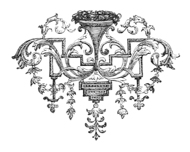
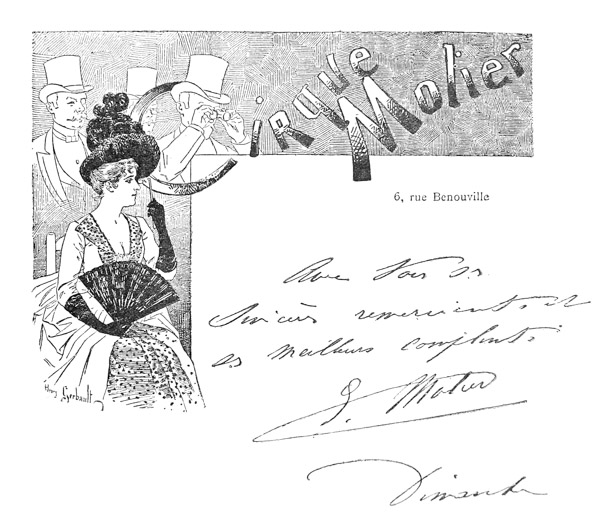
Whilst the acrobat was endeavouring to become a man of the world, the man of the world was becoming an excellent acrobat. The “governing classes” determined to have their Léotard. The gentleman quitted his stall in the circus to ascend the pad and the trapeze. [p308]
Lieutenant Viaud—in literature Pierre Loti—was one of the first to achieve this metamorphosis.
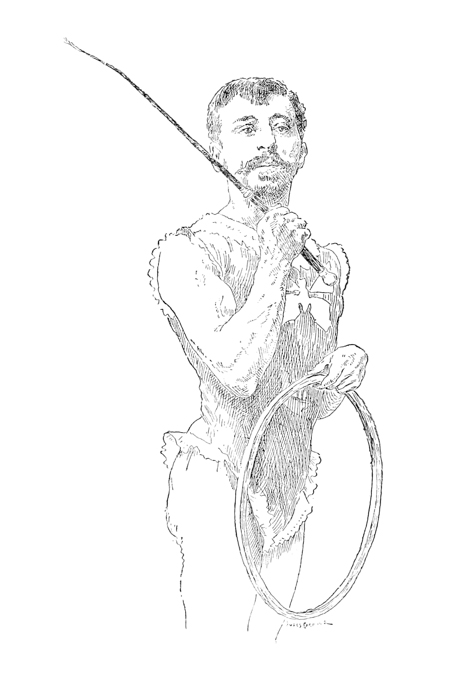
Those who have read his novels with a little attention will know the high value he places upon human beauty. Azyadée particularly, contains whole pages, infinitely curious, a little disquieting, very pagan in their candour, in which [p309] gymnastics are extolled with technical knowledge and lyric warmth.
M. Pierre Loti thinks, with the Platonics, that the body should be formed and embellished with as much refinement as the intelligence. Certain of the superiority of his mind, he wished that this cerebral strength should be served by the muscles of an athlete, and worked with indefatigable patience to correct in himself the weakness of nature.
And he has really transformed his body by the practice of gymnastics. Now, well set up, although of medium height, he produces an impression of strength and agility. One feels that in him exists that spring of elasticity which raises a body from the soil and wrests it from the laws of gravitation.
And indeed, or so it has been said, Pierre Loti joined a troupe of acrobats a few years ago, and appeared as a trapeze “novelty” in a circus in the south of France. The Naval Ministry would have been agitated by this whim....
Is this story true?
At all events it is probable, and it proves—and this is all that concerns us—the high esteem which, at the present time, a gentleman can feel for an art which the last generation decidedly ignored too much.
The men of taste, even, who clearly perceived the picturesque side of a circus, were not too numerous.
The collection of M. Louis is perhaps unique in the world.
Paul Ginisty, who has examined these treasures, has related his impressions, with much ability and grace, in the Dieu Bibelot.
“Do you know,” he says, “the Montchanin Circus?” [p310]
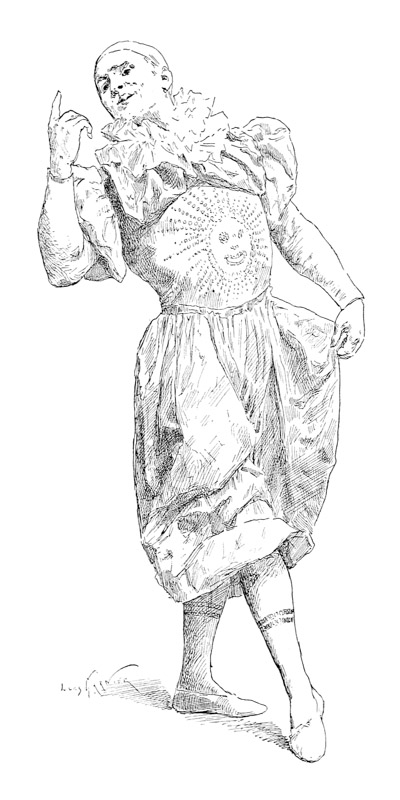
“You do not go into it through a large entrance, you need only knock at the door of a charming little hôtel. You do not [p311] find in it any of those odours usually noticed in hippique establishments, because it contains neither arena, stables, nor horses. The title of ‘circus’ is simply the familiar name given to the collection of an old amateur, who dwells in a calm quiet street in the Quartier de Villiers, and who has really a passion for everything relating to equestrian exhibitions. No one possesses as many traditions of circus art as he does. He has not only known all those who for thirty or thirty-five years have distinguished themselves in the arena; but he has also lived with every dynasty of ring-masters, Hercules and jugglers of the past. In fact, he has surrounded himself with an infinitely curious collection of prints and documents of all ages referring to the circus. It includes portraits of all the masters, specimens of costumes, placards, programmes, and advertisements of ‘phenomena.’
“Some of these prints, drawings by Carle Vernet, engravings of Grimaldi and Debucourt, are artistically interesting; others are simply typical. There is not one corner of the hôtel without some of these pleasing designs.”
Another lover of the circus, no longer content with collecting portfolios full of beautiful equestrian placards, determined to quietly live the healthy existence of a circus performer for his own amusement. When first the public read in the paragraphs of the society papers that Señor Molieros had built a circus, in his private house, in which he was ring-master, and trained horses for the haute école and other performances, people said:
“It is simply a whim of a Spanish grandee.”
The truth is that Señor Molieros is really named Ernest Molier, that he is a Manceau, and that possessing a large [p312] fortune, he prefers spending it upon horses that he loves, rather than with gamblers, who bore him.
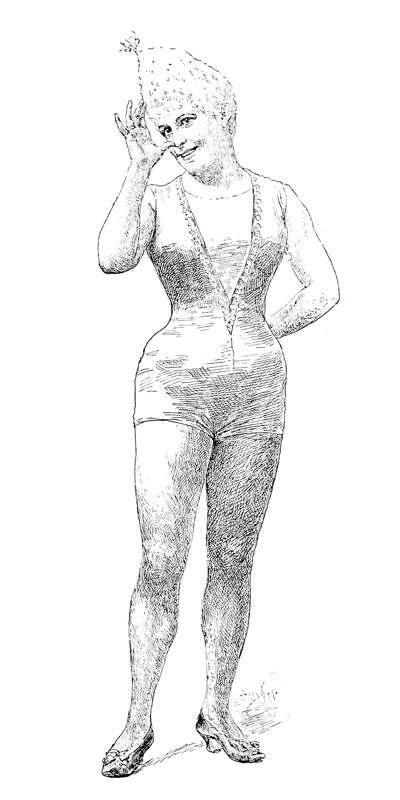
Not every one who asked for admittance to the small hôtel [p313] in the Rue de Boulogne obtained it. Molier’s intrepidity led him to prefer vicious horses, and difficulties only increased his eagerness to conquer them. “He was never happier than when some dangerous animal that no one had hitherto ventured to mount, would obey his eyes and his lightest touch. Like Anthony he would have rather killed the horse than allowed him to disobey!”14
Ernest Molier has often told me that he did not learn his profession from books. You have seen too in the perusal of these monographs, that the science of the circus is entirely traditional. But you would never guess with how much suspicious jealousy the banquiste defends the guardianship of his secrets. I have learnt by experience how unwillingly he confides even a few items of his knowledge to a writer, who can never be a rival; and from this I can imagine how much he would distrust a horseman. Only Molier’s integrity and military frankness enabled him to overcome this dislike.
Besides, Molier has the circus genius, and a man of genius can dispense with masters.
In the Rue Blanche his stable overcrowded him. Air and space were both lacking. In 1879 he therefore transported his luggage and caravan to Rue Benouville, at the gate of the Bois. A house, fencing hall and stables sprang from the soil as though built by magic. The riding-school was ornamented with the decorations of the fête of the Paris-Murcie and was converted into a regular circus. A few boxes were added for the use of privileged spectators; no one then foresaw the wonderful success obtained by the meetings in the Rue de [p314] Benouville; the preparations were only made for the reception of friends.
They came in crowds to visit the hospitable mansion.
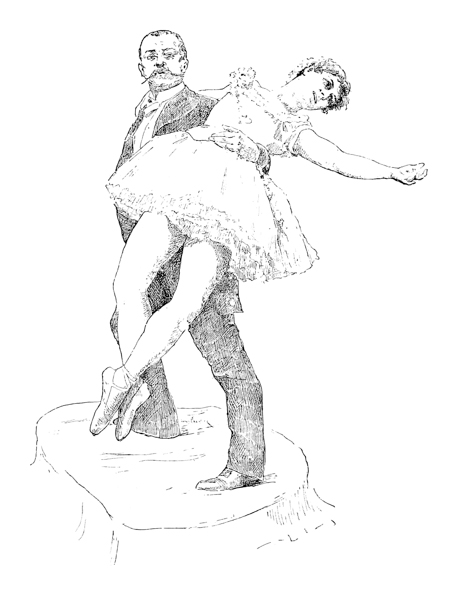

The fencing hall was opened to them; they fenced, vaulted, practised with the dumb-bells and mounted the trapeze. But Molier, faithful to his passion, devoted himself to his horses. He trained Arlequin, a dappled grey Russian horse, in the [p315] arts of the haute école, which consist in performing the Spanish walk and trot, in galloping, cantering, changing feet, balancing on the fore legs, as well as on the hind quarters;15 “and also Blondin, a superb Norman chestnut, with a light mane and [p316] tail, a horse trained in the haute école almost in the same style as Arlequin.”
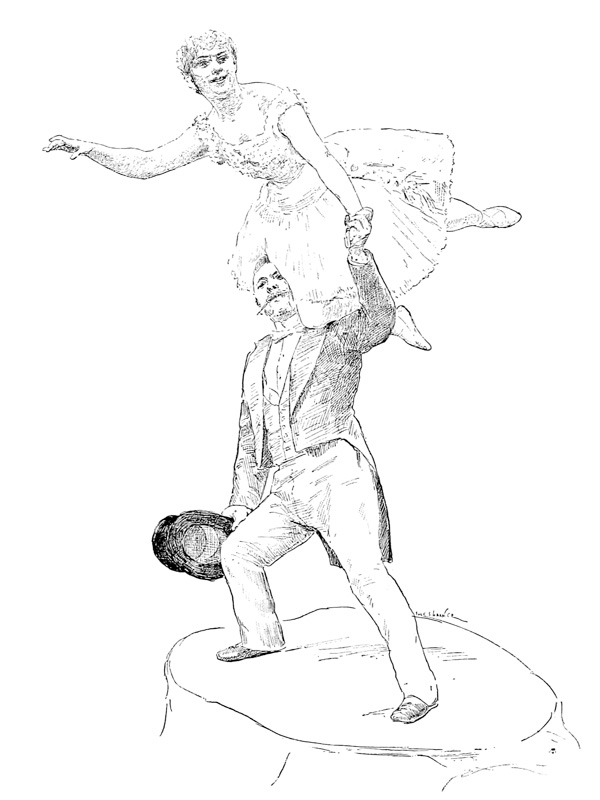
Molier also trained equestrians for the pad and the haute école. His first pupil was the pretty Mademoiselle de Trèves. [p317] He placed her on a horse, and made her an exceptionally good rider, capable of riding standing, on a bare-backed horse and of leaping over barriers, in the best style of the haute école. Then followed Mademoiselle Irma Viollat, one of the ornaments of the corps de ballet. The master taught her to repeat on horseback all the dances that she excelled in upon the stage.
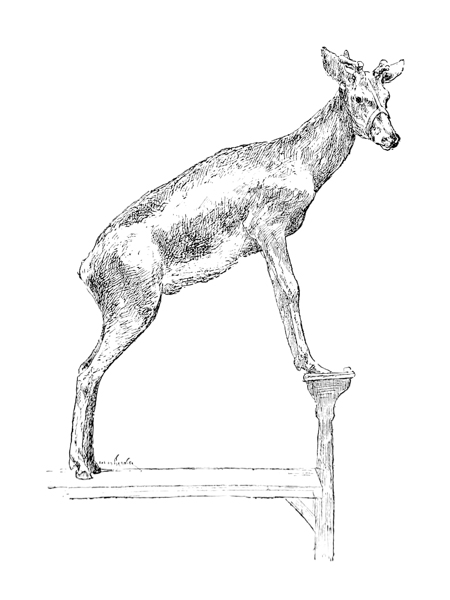
Insensibly a crowd of amateurs had gathered round Molier; and they formed a complete company. At last Molier one day yielded to the entreaties of his comrades and consented to give a performance in his circus. [p318]

It was quite understood that it was to be a private entertainment. [p319]
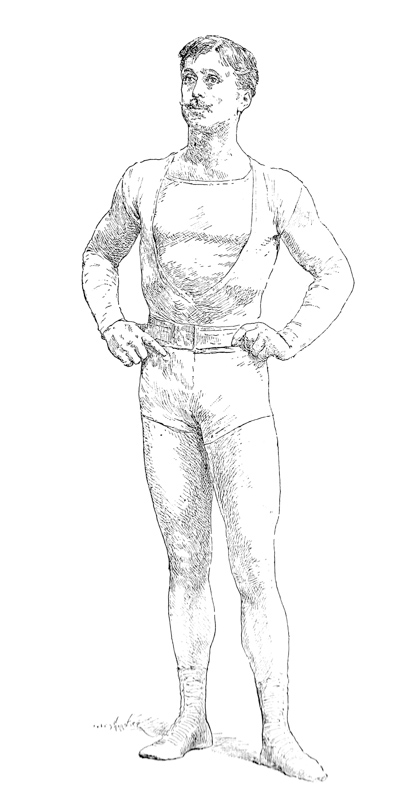
All Paris tried to get in.
Artists and society people broke open the doors. [p320]
They left the circus in great astonishment, and loudly proclaimed their admiration.
Of course, the newspapers were full of it. The people who had been left out were very severe. They declared it was a scandal. Noblemen playing at acrobatics were an easy subject for abuse. “What do you say? Messrs. Hubert de la Rochefoucauld, Martel, de Saint-Aldegonde, de Maulde, de Visocq, de Sainte-Marie, Courtay, d’Arquevilliers and de Pully had appeared in spangled tights?”
They recalled the Romans during the decadence, and M. Prudhomme crossed his arms upon his breast in the attitude of the philosopher of Couture.
Since then, men have realized that these acrobatic amusements were only the artistic form, the blast of trumpets preceding the vanguard of the revolution, which has just ended in the formation of the Society of Physical Education.
Molier and his friends, who, with legitimate pride, remember that on one occasion they presented the Duchesse d’Uzès with 50,000 francs for the benefit of the Hospital for Incurables, claim, with some reason, a share in influencing this national movement. They certainly rendered bodily exercises fashionable once more, and this is a great deal in a country where routine is the only queen that has never been dethroned.
Moreover the warm applause which greeted the tirade of the Brettigny in the Révoltée last winter, proved to the acrobats of the Cirque Molier that they had won their cause in the opinion of the public.
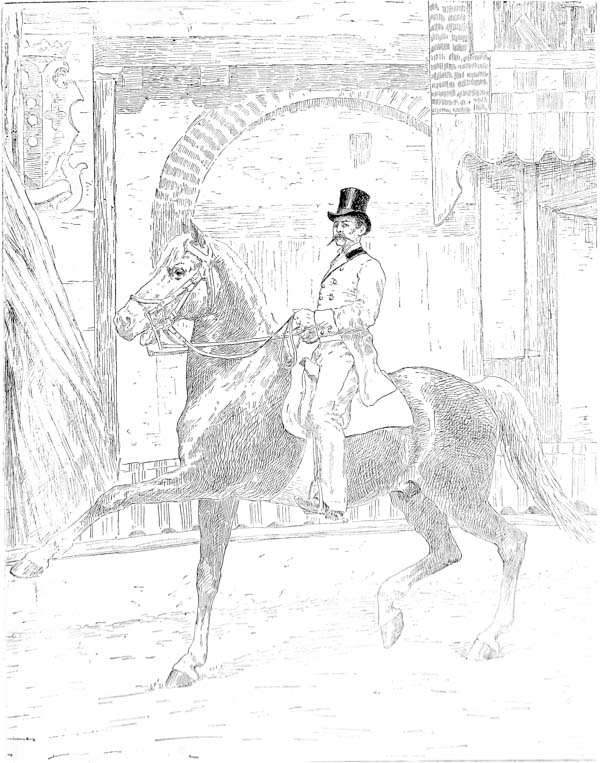
You may remember the indignant tirade in which the gentleman acrobat defends his favourite amusement against the witticisms of Madame Herbeau: [p321]
“What do you want a man of our class to do at the present time? Politics are prohibited. They are monopolized by other buffoons, whose exercises are much more dangerous for the spectators and not so amusing. The army? Well, it is a refuge for those who have courage, and I have belonged [p322] to it. But there was too little to do in time of peace. Literature? I should not know how to begin, and I dare own that I would not deign to adopt it. Naturalism is too dull, and dilettantism too sterile. I find it better to enjoy life than to write about it. You say that I degrade my race? Nay, I revive it. You know the language used by the rhetors and journalists in describing the corrupt scions of the old aristocracy. Well, we will regenerate this corrupt youth! We are strong, our muscles are like those of the street porters, of our ancestors the Frank warriors, of the companions of Charlemagne, who were only superb brutes.”16
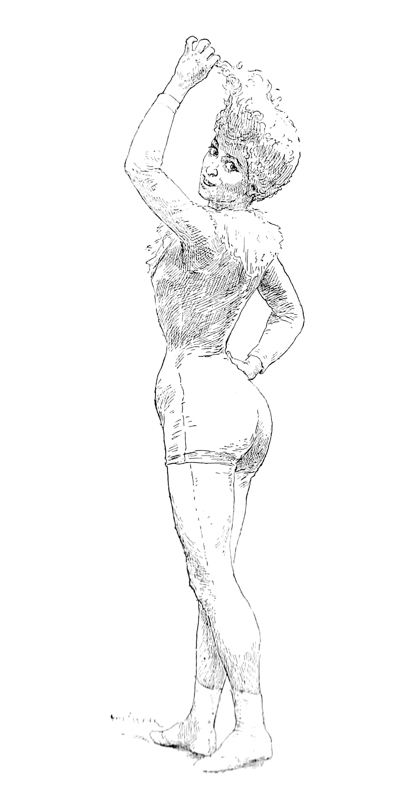
Molier and his friends have triumphed without noise, just as they resisted the ill-humour of foolish grumblers without bluster.
During the last ten years this clever troupe of amateurs has wonderfully increased. It now includes two new star equestrians—Mademoiselle Blanche Lamidey and Miss Anna. You have probably seen Mazeppa performed in a circus, at least once in your life, but, since Miss Ada Menken, you have never seen a very young girl, thrown on her back, held by one foot only, her loosened hair dragging in the sand, and in this dangerous position leaping with her galloping horse an arrangement of several barriers.
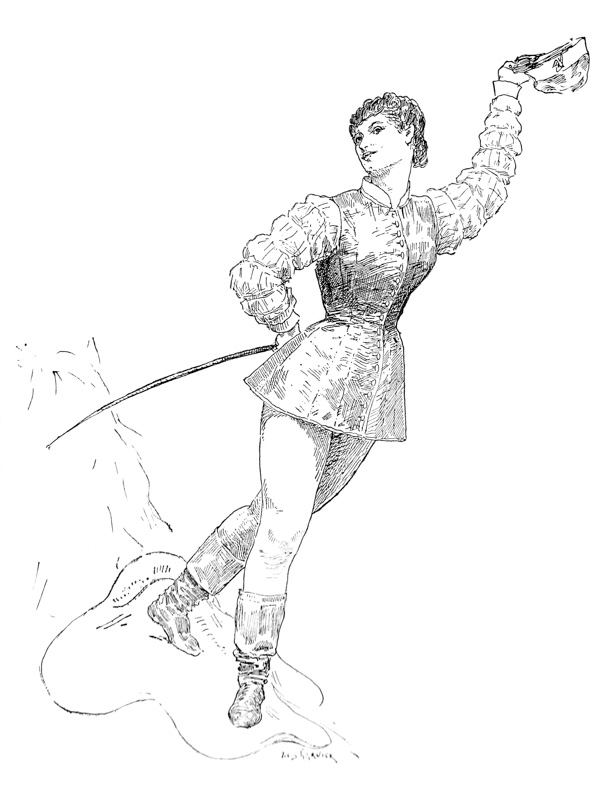
Nor since Jenny O’Brien left us for America have we ever seen a woman ride standing upon two horses with as much dainty jauntiness, self-possession and audacity as Miss Anna. And then how well she dresses! Lovers of Florentine bronzes will never forget a certain suit of grey tights, a harlequin’s [p324] costume, cut low and heart shaped at the neck, with greaves of the same grey tint below the knees.

Molier has grouped a number of pretty women, actresses, [p325] artists, and young men of the world round these two charming girls. Amongst the ladies are Mesdemoiselles Lavigne and Desoder from the Palais Royal, Mademoiselle Felicia Mallet, Mademoiselle Renée Maupin, from the Opera, Jeanne Becker, Léa d’Asco, etc.;—amongst the men: Messrs. Frédéric Vavasseur, Jules Ravaut, Arthus, Gerbaut, Adrien Marie, Craffty, Goubie, Pantelli, J. Lewis-Brown. I must apologize to those whom I forget to name.
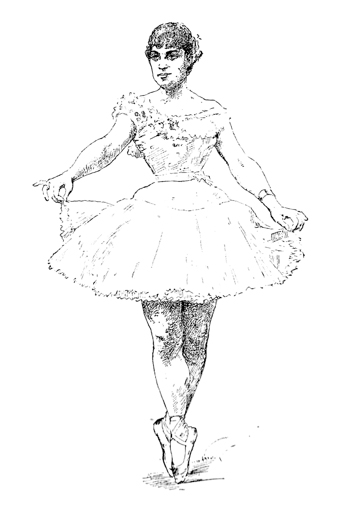
With these resources the performance of a pantomime was easily arranged, and these spectacles are one of the chief [p326] attractions of the entertainments given in the Rue Benouville. It was here that Félicien Champsaur made the first trial of contemporary pantomime by which he amuses us without introducing the form of Pierrot or the bat of Harlequin.
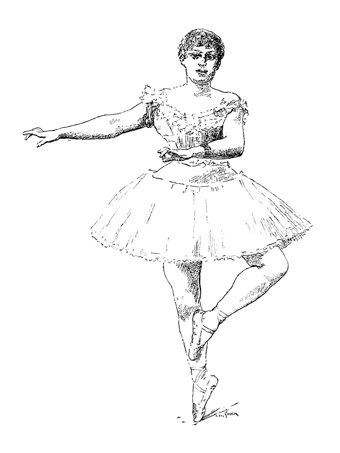
“Why,” he reflected, “should we show the fashionable people who annually fill the boxes of the Molier, some old fairy story remounted in a new form? Men of the present day with money and audacity accomplish greater prodigies than the magicians of old.” [p327]
M. Champsaur resolved to show us his contemporaries at work—and this is the plot of his pantomime—
The charming Mademoiselle Rivolta, from the Eden, appeared disguised as a little Spring looking for her course. No one had thought of using her to fill a lake, rush down a waterfall or turn a mill. She therefore wandered about the Cirque Molier, shedding floods of tears.
Good Luck, who never likes to see pretty girls cry, led two speculators in the same direction. They remark to each other:—
“Look! here’s a little Spring! And there’s no casino on the bank!”
“No race game!”
“No gambling house!”
“Cannot this little Spring cure some illness?”
“If not, she is the only one of her kind!”
To satisfy themselves on this point they then take Mademoiselle Rivolta’s hand, lead her to the house of Madame Dezoder, a lady doctor in the same neighbourhood, and knock at the door.
Armed with a goblet, Madame Dezoder tastes Mademoiselle Rivolta.
After carefully testing her, her gesture says “Pooh!”
“What does that matter?” replied the bankers. “We will bottle Mademoiselle Rivolta and, with a good label, she will cure as well as her companions.”
No sooner said than it was done. And since a godmother was required for the new Spring launched upon the world, the bankers fetch Fortune, Mademoiselle Renée Maupin, from the Opera! [p328]
Ah! what a delightful person!
I always liked Fortune instinctively, before I knew her; but since I have seen her feet, figure, and eyes! . . . . .
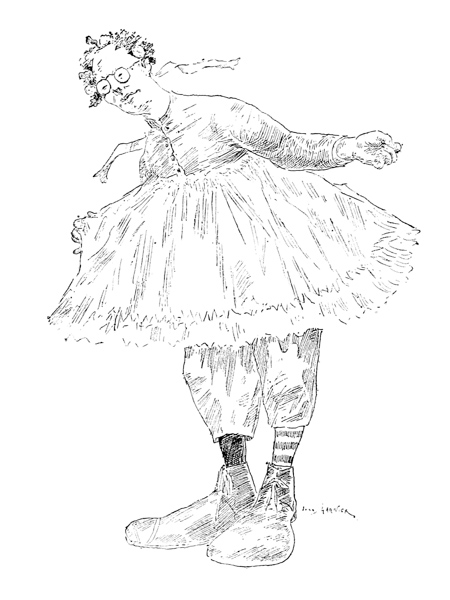
“You shall cure everything!” Fortune assured the Spring.
They placed the bottle in the doctor’s house and in it Mademoiselle Rivolta, who looked like a saint in her shrine.
Then the procession of those wounded by Life (Ereintés de la Vie)—this is the title of the pantomime—commences. [p329]
They are all invalided by love: first, a number of pretty girls who have flirted too much; then all the gentlemen who have been wounded by these flirtations.
Love himself comes to the Spring.
He is very ill.
His poor little wings hang down his back in a lamentable way.
“Douche him! Douche him!”
The child is dipped in the water and is drawn out transformed into a Farnese Hercules, with enormous muscles which stand out in huge rolls upon his arms from the shoulder to the elbow.
The entertainment closes by a procession accompanied by a blast of trumpets, at the end of which appears the Golden Calf, led by Fortune with a leash.
I have quoted this pantomime by M. Champsaur in preference to others of more recent date which have been equally successful, because it clearly indicates the nature of the entertainment given in the Cirque Molier.
People see and perform in the Rue Benouville pieces that could not be played or shown elsewhere; for here the audience and the actors are all people of the same education, the same surroundings, who know each other.
The doors have been more widely opened than they formerly were. But they are still closely guarded, the members of the society intend to amuse themselves as they please in their own circle, and to exclude anything that offends them.
For instance, you will not find either at the rehearsals or at the performances in the Rue Benouville in the boxes or behind the scenes, the shadow of a professional actor. [p330]
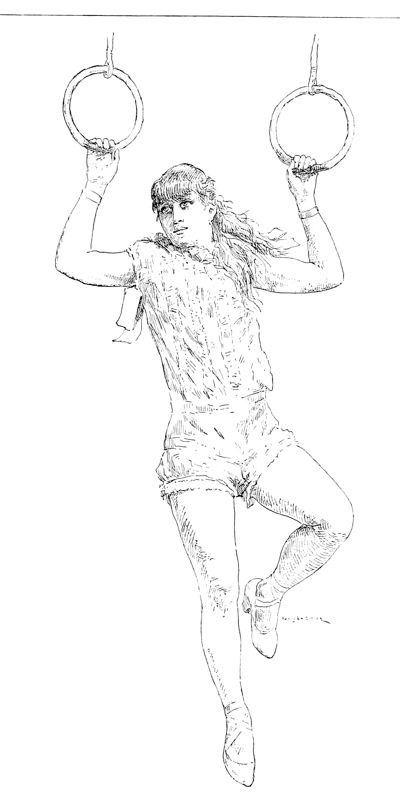
The door is closed against theatrical men.
What! even “Chose” and “Machin?” [p331]
Even for them.
The “cross” and the banner are both useless. Monsieur le Sociétaire has vainly tried to force a door which is half open for the banquistes . . . . .
A voice has cried to him from the trapeze, “We are very sorry, sir! But we have retained the prejudices of the comedians.”
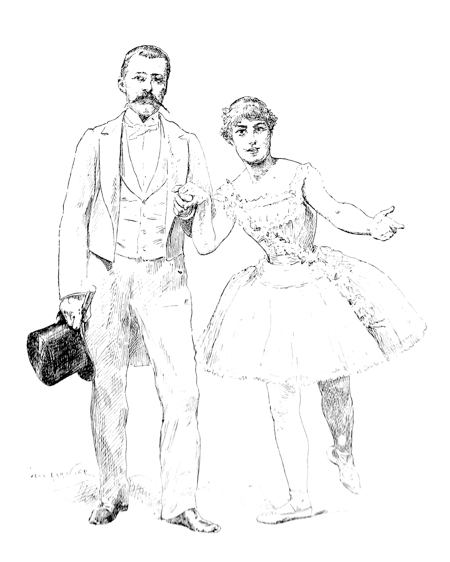
[14] Baron de Vaux, Les Hommes de Cheval.
[15] Baron de Vaux, Les Hommes de Cheval.
[16] Jules Lemaître, Révoltée, Act I., Sc. 3.
Original printed spelling and grammar is generally retained. Original small caps type Looks Like This. Footnotes were renumbered and moved from the ends of pages to the ends of chapters. Illustrations were moved out of paragraphs to between paragraphs. Ellipses look like the originals. The transcriber created the cover image and hereby transfers it to the public. The original printed page numbers are indicated thus: “[p089]”.
“Lemaitre” was changed to “Lemaître” in the two places it was originally printed (in a footnote, and in the index). The entry “Paquerette” in the index had no page number associated with it, and neither “paquerette” nor “pâquerette” appear elsewhere in the book.
Page x, ERRATA: The error mentioned in the first note, regarding “Vitellii”, has been corrected at page 78. The second note—‘Page 206, line 3 from top, for “Naet Salsbury”, read, “Nael Salsbury”’—is wrong. Page 206 was actually printed with “Naet Salisbury”. In this ebook, page 206 has been changed to read “Nael Salsbury”. The original “Salisbury” was printed only once, while “Salsbury” was printed in several places.
Page 63: “nouée was exhibited” was changed to “noués was exhibited”
Page 194: Greek phrase "Ἵππος μετέωρος" may be transliterated as "Hippos meteôros".
Page 225: the word “Yotshitaro” is spelled “Yotshitatro” in the index.
Page 238: “Emilie Loisset” was changed to “Émilie Loisset”.
Page 262: “admirn g” was changed to “admiring”.
Page 274: “them selves” changed to “themselves”.
Page 331: the index entry “Bretonnière” probably refers to “Brettonière” on page ix.
Page 334: the index entry “Jaclley” was changed to “Jackley”.
Page 335: the index entry “Linsky, 13” probably refers to “Linski” on page 13. The entry “Mallet (Félicia)” doubtless refers to Felicia Mallet on page 325.
Page 336: the index entry “Worenzoff, 74” might refer to “Worouzof”, which actually occurred on page 75. The entry “Vissocq (de), 320” probably refers to “Visocq”, as printed on page 320. The entry “Violat (Irma), 317” probably refers to “Viollat” on page 317.
End of the Project Gutenberg EBook of Acrobats and Mountebanks, by
Hugues Le Roux and Jules Garnier
*** END OF THIS PROJECT GUTENBERG EBOOK ACROBATS AND MOUNTEBANKS ***
***** This file should be named 45587-h.htm or 45587-h.zip *****
This and all associated files of various formats will be found in:
http://www.gutenberg.org/4/5/5/8/45587/
Produced by Chris Curnow, RichardW, and the Online
Distributed Proofreading Team at http://www.pgdp.net (This
file was produced from images generously made available
by The Internet Archive)
Updated editions will replace the previous one--the old editions
will be renamed.
Creating the works from public domain print editions means that no
one owns a United States copyright in these works, so the Foundation
(and you!) can copy and distribute it in the United States without
permission and without paying copyright royalties. Special rules,
set forth in the General Terms of Use part of this license, apply to
copying and distributing Project Gutenberg-tm electronic works to
protect the PROJECT GUTENBERG-tm concept and trademark. Project
Gutenberg is a registered trademark, and may not be used if you
charge for the eBooks, unless you receive specific permission. If you
do not charge anything for copies of this eBook, complying with the
rules is very easy. You may use this eBook for nearly any purpose
such as creation of derivative works, reports, performances and
research. They may be modified and printed and given away--you may do
practically ANYTHING with public domain eBooks. Redistribution is
subject to the trademark license, especially commercial
redistribution.
*** START: FULL LICENSE ***
THE FULL PROJECT GUTENBERG LICENSE
PLEASE READ THIS BEFORE YOU DISTRIBUTE OR USE THIS WORK
To protect the Project Gutenberg-tm mission of promoting the free
distribution of electronic works, by using or distributing this work
(or any other work associated in any way with the phrase "Project
Gutenberg"), you agree to comply with all the terms of the Full Project
Gutenberg-tm License (available with this file or online at
http://gutenberg.org/license).
Section 1. General Terms of Use and Redistributing Project Gutenberg-tm
electronic works
1.A. By reading or using any part of this Project Gutenberg-tm
electronic work, you indicate that you have read, understand, agree to
and accept all the terms of this license and intellectual property
(trademark/copyright) agreement. If you do not agree to abide by all
the terms of this agreement, you must cease using and return or destroy
all copies of Project Gutenberg-tm electronic works in your possession.
If you paid a fee for obtaining a copy of or access to a Project
Gutenberg-tm electronic work and you do not agree to be bound by the
terms of this agreement, you may obtain a refund from the person or
entity to whom you paid the fee as set forth in paragraph 1.E.8.
1.B. "Project Gutenberg" is a registered trademark. It may only be
used on or associated in any way with an electronic work by people who
agree to be bound by the terms of this agreement. There are a few
things that you can do with most Project Gutenberg-tm electronic works
even without complying with the full terms of this agreement. See
paragraph 1.C below. There are a lot of things you can do with Project
Gutenberg-tm electronic works if you follow the terms of this agreement
and help preserve free future access to Project Gutenberg-tm electronic
works. See paragraph 1.E below.
1.C. The Project Gutenberg Literary Archive Foundation ("the Foundation"
or PGLAF), owns a compilation copyright in the collection of Project
Gutenberg-tm electronic works. Nearly all the individual works in the
collection are in the public domain in the United States. If an
individual work is in the public domain in the United States and you are
located in the United States, we do not claim a right to prevent you from
copying, distributing, performing, displaying or creating derivative
works based on the work as long as all references to Project Gutenberg
are removed. Of course, we hope that you will support the Project
Gutenberg-tm mission of promoting free access to electronic works by
freely sharing Project Gutenberg-tm works in compliance with the terms of
this agreement for keeping the Project Gutenberg-tm name associated with
the work. You can easily comply with the terms of this agreement by
keeping this work in the same format with its attached full Project
Gutenberg-tm License when you share it without charge with others.
1.D. The copyright laws of the place where you are located also govern
what you can do with this work. Copyright laws in most countries are in
a constant state of change. If you are outside the United States, check
the laws of your country in addition to the terms of this agreement
before downloading, copying, displaying, performing, distributing or
creating derivative works based on this work or any other Project
Gutenberg-tm work. The Foundation makes no representations concerning
the copyright status of any work in any country outside the United
States.
1.E. Unless you have removed all references to Project Gutenberg:
1.E.1. The following sentence, with active links to, or other immediate
access to, the full Project Gutenberg-tm License must appear prominently
whenever any copy of a Project Gutenberg-tm work (any work on which the
phrase "Project Gutenberg" appears, or with which the phrase "Project
Gutenberg" is associated) is accessed, displayed, performed, viewed,
copied or distributed:
This eBook is for the use of anyone anywhere at no cost and with
almost no restrictions whatsoever. You may copy it, give it away or
re-use it under the terms of the Project Gutenberg License included
with this eBook or online at www.gutenberg.org/license
1.E.2. If an individual Project Gutenberg-tm electronic work is derived
from the public domain (does not contain a notice indicating that it is
posted with permission of the copyright holder), the work can be copied
and distributed to anyone in the United States without paying any fees
or charges. If you are redistributing or providing access to a work
with the phrase "Project Gutenberg" associated with or appearing on the
work, you must comply either with the requirements of paragraphs 1.E.1
through 1.E.7 or obtain permission for the use of the work and the
Project Gutenberg-tm trademark as set forth in paragraphs 1.E.8 or
1.E.9.
1.E.3. If an individual Project Gutenberg-tm electronic work is posted
with the permission of the copyright holder, your use and distribution
must comply with both paragraphs 1.E.1 through 1.E.7 and any additional
terms imposed by the copyright holder. Additional terms will be linked
to the Project Gutenberg-tm License for all works posted with the
permission of the copyright holder found at the beginning of this work.
1.E.4. Do not unlink or detach or remove the full Project Gutenberg-tm
License terms from this work, or any files containing a part of this
work or any other work associated with Project Gutenberg-tm.
1.E.5. Do not copy, display, perform, distribute or redistribute this
electronic work, or any part of this electronic work, without
prominently displaying the sentence set forth in paragraph 1.E.1 with
active links or immediate access to the full terms of the Project
Gutenberg-tm License.
1.E.6. You may convert to and distribute this work in any binary,
compressed, marked up, nonproprietary or proprietary form, including any
word processing or hypertext form. However, if you provide access to or
distribute copies of a Project Gutenberg-tm work in a format other than
"Plain Vanilla ASCII" or other format used in the official version
posted on the official Project Gutenberg-tm web site (www.gutenberg.org),
you must, at no additional cost, fee or expense to the user, provide a
copy, a means of exporting a copy, or a means of obtaining a copy upon
request, of the work in its original "Plain Vanilla ASCII" or other
form. Any alternate format must include the full Project Gutenberg-tm
License as specified in paragraph 1.E.1.
1.E.7. Do not charge a fee for access to, viewing, displaying,
performing, copying or distributing any Project Gutenberg-tm works
unless you comply with paragraph 1.E.8 or 1.E.9.
1.E.8. You may charge a reasonable fee for copies of or providing
access to or distributing Project Gutenberg-tm electronic works provided
that
- You pay a royalty fee of 20% of the gross profits you derive from
the use of Project Gutenberg-tm works calculated using the method
you already use to calculate your applicable taxes. The fee is
owed to the owner of the Project Gutenberg-tm trademark, but he
has agreed to donate royalties under this paragraph to the
Project Gutenberg Literary Archive Foundation. Royalty payments
must be paid within 60 days following each date on which you
prepare (or are legally required to prepare) your periodic tax
returns. Royalty payments should be clearly marked as such and
sent to the Project Gutenberg Literary Archive Foundation at the
address specified in Section 4, "Information about donations to
the Project Gutenberg Literary Archive Foundation."
- You provide a full refund of any money paid by a user who notifies
you in writing (or by e-mail) within 30 days of receipt that s/he
does not agree to the terms of the full Project Gutenberg-tm
License. You must require such a user to return or
destroy all copies of the works possessed in a physical medium
and discontinue all use of and all access to other copies of
Project Gutenberg-tm works.
- You provide, in accordance with paragraph 1.F.3, a full refund of any
money paid for a work or a replacement copy, if a defect in the
electronic work is discovered and reported to you within 90 days
of receipt of the work.
- You comply with all other terms of this agreement for free
distribution of Project Gutenberg-tm works.
1.E.9. If you wish to charge a fee or distribute a Project Gutenberg-tm
electronic work or group of works on different terms than are set
forth in this agreement, you must obtain permission in writing from
both the Project Gutenberg Literary Archive Foundation and Michael
Hart, the owner of the Project Gutenberg-tm trademark. Contact the
Foundation as set forth in Section 3 below.
1.F.
1.F.1. Project Gutenberg volunteers and employees expend considerable
effort to identify, do copyright research on, transcribe and proofread
public domain works in creating the Project Gutenberg-tm
collection. Despite these efforts, Project Gutenberg-tm electronic
works, and the medium on which they may be stored, may contain
"Defects," such as, but not limited to, incomplete, inaccurate or
corrupt data, transcription errors, a copyright or other intellectual
property infringement, a defective or damaged disk or other medium, a
computer virus, or computer codes that damage or cannot be read by
your equipment.
1.F.2. LIMITED WARRANTY, DISCLAIMER OF DAMAGES - Except for the "Right
of Replacement or Refund" described in paragraph 1.F.3, the Project
Gutenberg Literary Archive Foundation, the owner of the Project
Gutenberg-tm trademark, and any other party distributing a Project
Gutenberg-tm electronic work under this agreement, disclaim all
liability to you for damages, costs and expenses, including legal
fees. YOU AGREE THAT YOU HAVE NO REMEDIES FOR NEGLIGENCE, STRICT
LIABILITY, BREACH OF WARRANTY OR BREACH OF CONTRACT EXCEPT THOSE
PROVIDED IN PARAGRAPH 1.F.3. YOU AGREE THAT THE FOUNDATION, THE
TRADEMARK OWNER, AND ANY DISTRIBUTOR UNDER THIS AGREEMENT WILL NOT BE
LIABLE TO YOU FOR ACTUAL, DIRECT, INDIRECT, CONSEQUENTIAL, PUNITIVE OR
INCIDENTAL DAMAGES EVEN IF YOU GIVE NOTICE OF THE POSSIBILITY OF SUCH
DAMAGE.
1.F.3. LIMITED RIGHT OF REPLACEMENT OR REFUND - If you discover a
defect in this electronic work within 90 days of receiving it, you can
receive a refund of the money (if any) you paid for it by sending a
written explanation to the person you received the work from. If you
received the work on a physical medium, you must return the medium with
your written explanation. The person or entity that provided you with
the defective work may elect to provide a replacement copy in lieu of a
refund. If you received the work electronically, the person or entity
providing it to you may choose to give you a second opportunity to
receive the work electronically in lieu of a refund. If the second copy
is also defective, you may demand a refund in writing without further
opportunities to fix the problem.
1.F.4. Except for the limited right of replacement or refund set forth
in paragraph 1.F.3, this work is provided to you 'AS-IS' WITH NO OTHER
WARRANTIES OF ANY KIND, EXPRESS OR IMPLIED, INCLUDING BUT NOT LIMITED TO
WARRANTIES OF MERCHANTABILITY OR FITNESS FOR ANY PURPOSE.
1.F.5. Some states do not allow disclaimers of certain implied
warranties or the exclusion or limitation of certain types of damages.
If any disclaimer or limitation set forth in this agreement violates the
law of the state applicable to this agreement, the agreement shall be
interpreted to make the maximum disclaimer or limitation permitted by
the applicable state law. The invalidity or unenforceability of any
provision of this agreement shall not void the remaining provisions.
1.F.6. INDEMNITY - You agree to indemnify and hold the Foundation, the
trademark owner, any agent or employee of the Foundation, anyone
providing copies of Project Gutenberg-tm electronic works in accordance
with this agreement, and any volunteers associated with the production,
promotion and distribution of Project Gutenberg-tm electronic works,
harmless from all liability, costs and expenses, including legal fees,
that arise directly or indirectly from any of the following which you do
or cause to occur: (a) distribution of this or any Project Gutenberg-tm
work, (b) alteration, modification, or additions or deletions to any
Project Gutenberg-tm work, and (c) any Defect you cause.
Section 2. Information about the Mission of Project Gutenberg-tm
Project Gutenberg-tm is synonymous with the free distribution of
electronic works in formats readable by the widest variety of computers
including obsolete, old, middle-aged and new computers. It exists
because of the efforts of hundreds of volunteers and donations from
people in all walks of life.
Volunteers and financial support to provide volunteers with the
assistance they need, are critical to reaching Project Gutenberg-tm's
goals and ensuring that the Project Gutenberg-tm collection will
remain freely available for generations to come. In 2001, the Project
Gutenberg Literary Archive Foundation was created to provide a secure
and permanent future for Project Gutenberg-tm and future generations.
To learn more about the Project Gutenberg Literary Archive Foundation
and how your efforts and donations can help, see Sections 3 and 4
and the Foundation web page at http://www.pglaf.org.
Section 3. Information about the Project Gutenberg Literary Archive
Foundation
The Project Gutenberg Literary Archive Foundation is a non profit
501(c)(3) educational corporation organized under the laws of the
state of Mississippi and granted tax exempt status by the Internal
Revenue Service. The Foundation's EIN or federal tax identification
number is 64-6221541. Its 501(c)(3) letter is posted at
http://pglaf.org/fundraising. Contributions to the Project Gutenberg
Literary Archive Foundation are tax deductible to the full extent
permitted by U.S. federal laws and your state's laws.
The Foundation's principal office is located at 4557 Melan Dr. S.
Fairbanks, AK, 99712., but its volunteers and employees are scattered
throughout numerous locations. Its business office is located at
809 North 1500 West, Salt Lake City, UT 84116, (801) 596-1887, email
business@pglaf.org. Email contact links and up to date contact
information can be found at the Foundation's web site and official
page at http://pglaf.org
For additional contact information:
Dr. Gregory B. Newby
Chief Executive and Director
gbnewby@pglaf.org
Section 4. Information about Donations to the Project Gutenberg
Literary Archive Foundation
Project Gutenberg-tm depends upon and cannot survive without wide
spread public support and donations to carry out its mission of
increasing the number of public domain and licensed works that can be
freely distributed in machine readable form accessible by the widest
array of equipment including outdated equipment. Many small donations
($1 to $5,000) are particularly important to maintaining tax exempt
status with the IRS.
The Foundation is committed to complying with the laws regulating
charities and charitable donations in all 50 states of the United
States. Compliance requirements are not uniform and it takes a
considerable effort, much paperwork and many fees to meet and keep up
with these requirements. We do not solicit donations in locations
where we have not received written confirmation of compliance. To
SEND DONATIONS or determine the status of compliance for any
particular state visit http://pglaf.org
While we cannot and do not solicit contributions from states where we
have not met the solicitation requirements, we know of no prohibition
against accepting unsolicited donations from donors in such states who
approach us with offers to donate.
International donations are gratefully accepted, but we cannot make
any statements concerning tax treatment of donations received from
outside the United States. U.S. laws alone swamp our small staff.
Please check the Project Gutenberg Web pages for current donation
methods and addresses. Donations are accepted in a number of other
ways including checks, online payments and credit card donations.
To donate, please visit: http://pglaf.org/donate
Section 5. General Information About Project Gutenberg-tm electronic
works.
Professor Michael S. Hart is the originator of the Project Gutenberg-tm
concept of a library of electronic works that could be freely shared
with anyone. For thirty years, he produced and distributed Project
Gutenberg-tm eBooks with only a loose network of volunteer support.
Project Gutenberg-tm eBooks are often created from several printed
editions, all of which are confirmed as Public Domain in the U.S.
unless a copyright notice is included. Thus, we do not necessarily
keep eBooks in compliance with any particular paper edition.
Most people start at our Web site which has the main PG search facility:
http://www.gutenberg.org
This Web site includes information about Project Gutenberg-tm,
including how to make donations to the Project Gutenberg Literary
Archive Foundation, how to help produce our new eBooks, and how to
subscribe to our email newsletter to hear about new eBooks.